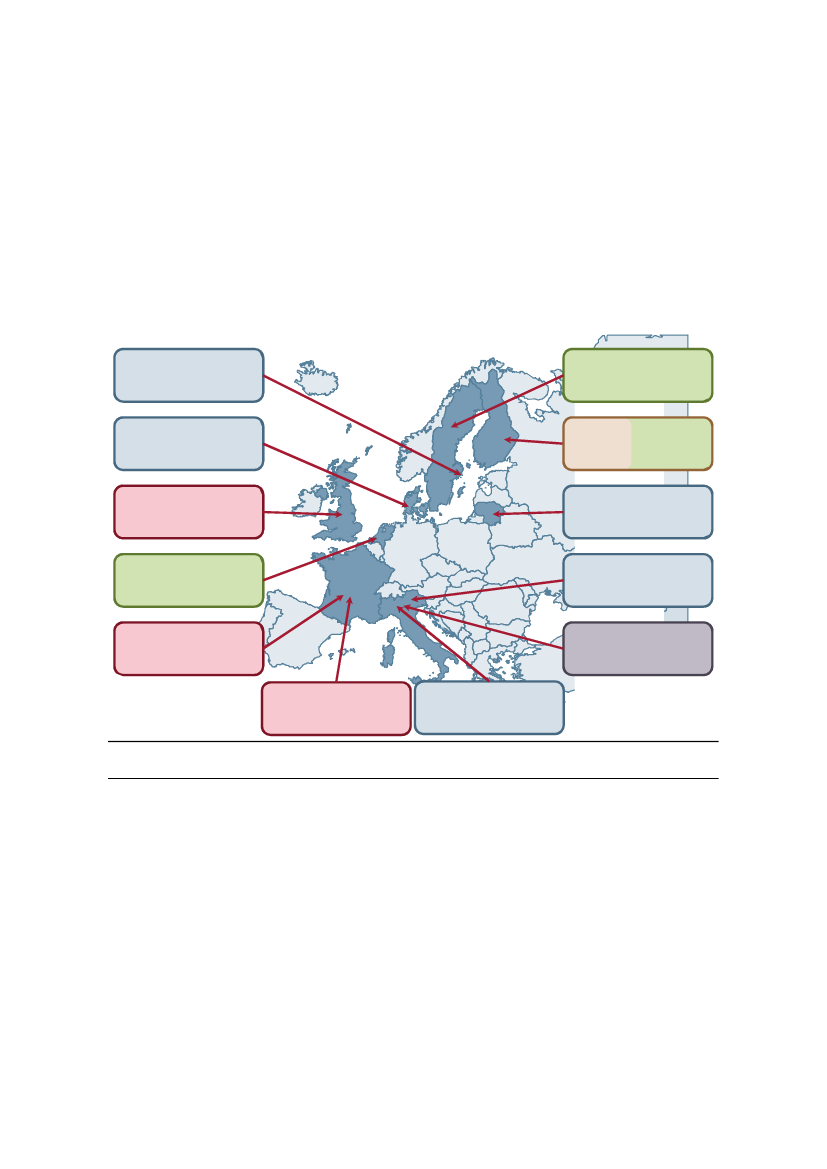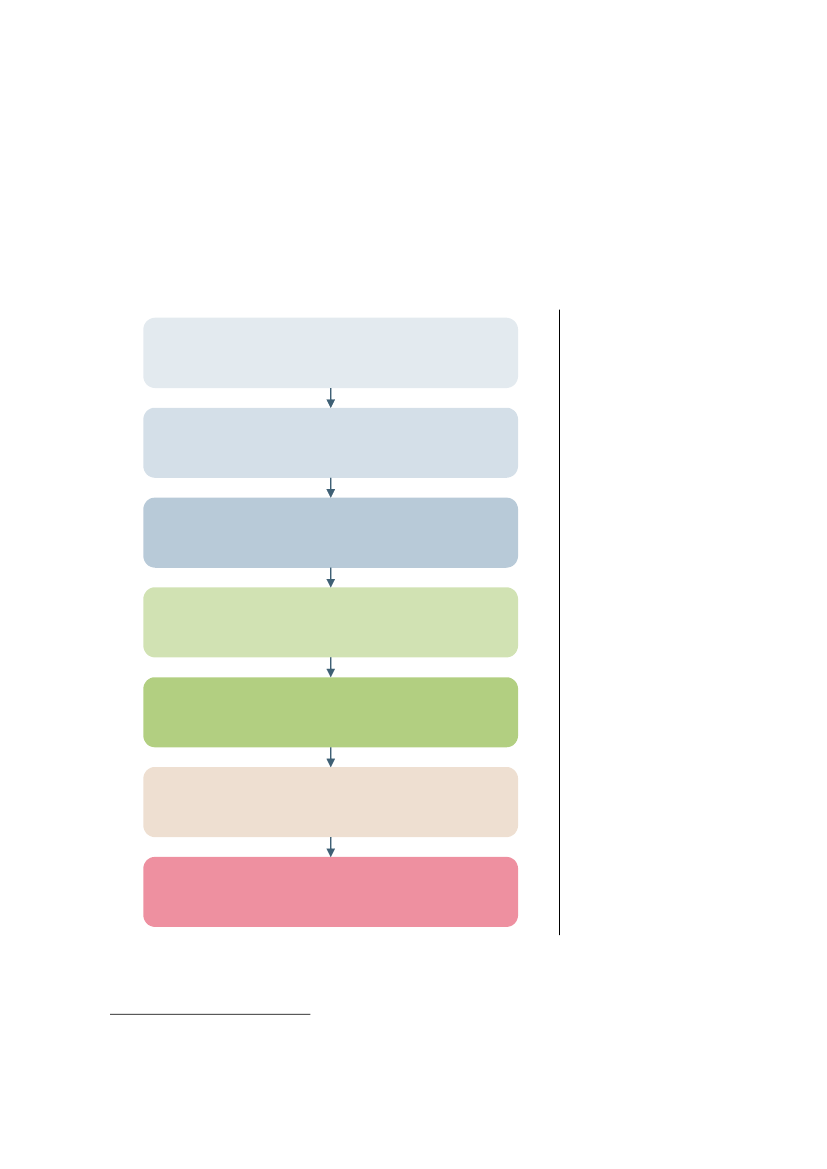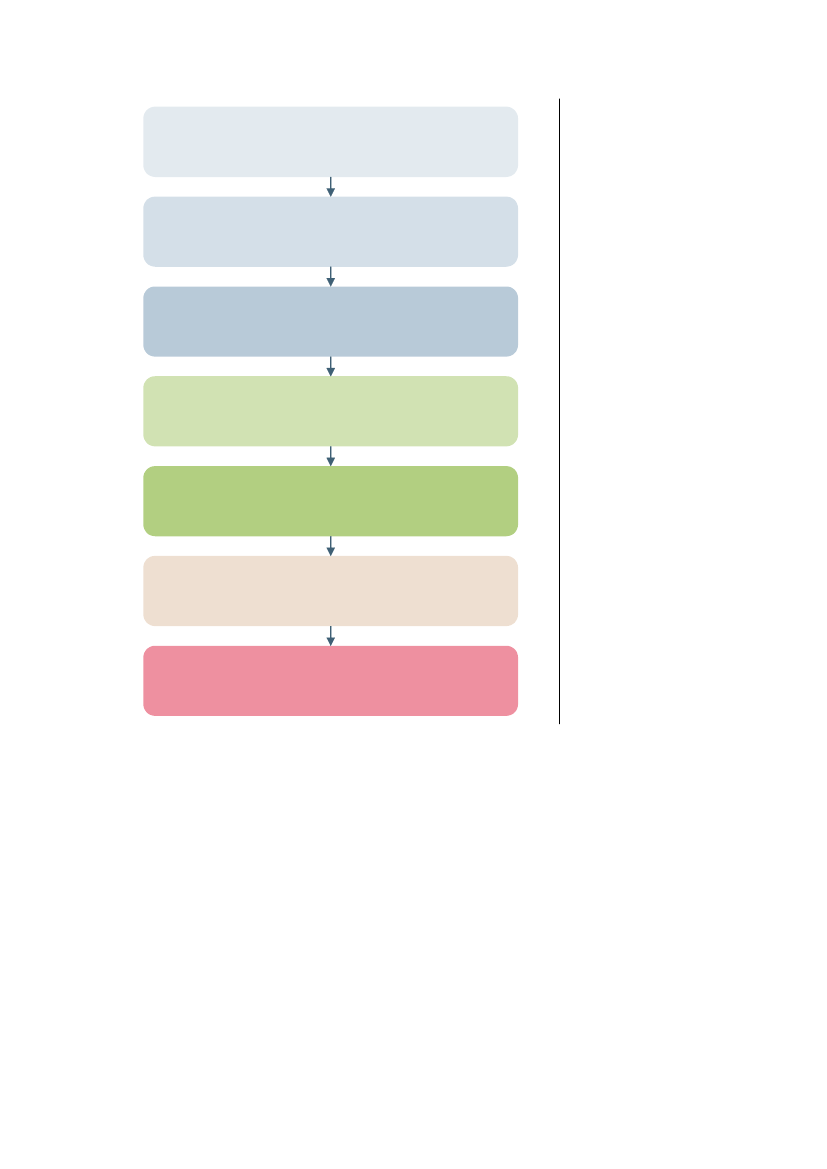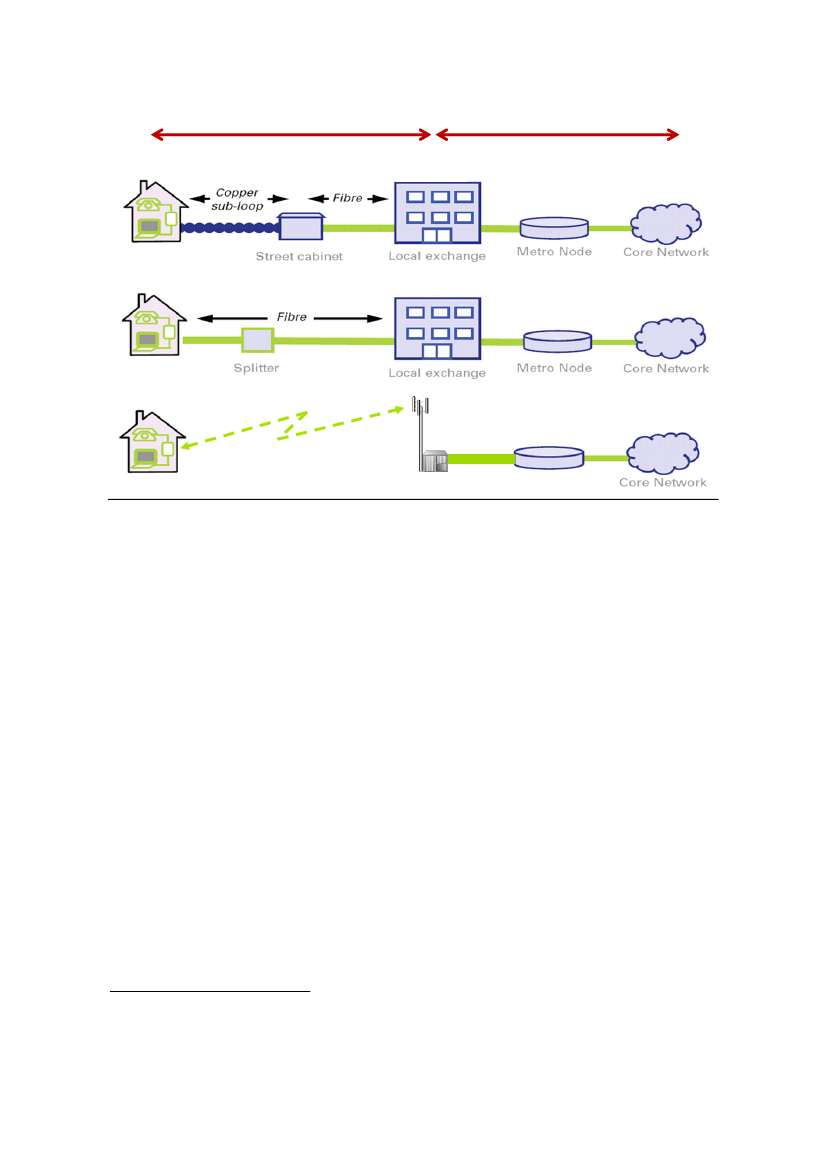Udvalget for Landdistrikter og Øer 2011-12
ULØ Alm.del Bilag 202
Offentligt
European UnionRegional Policy
Guide to broadband investment
September 2011
Guide to broadband investmentFinal report
September 2011
FOREWORDEurope is facing an investment challenge in the financing of high speed internet infrastructure. High amounts of investmentsare needed to achieve ubiquitous coverage of state-of-the-art competitive broadband networks, yet “the benefits for society asa whole appear to be much greater than the private incentives to invest in faster networks “In its Digital Agenda for Europe, the European Commission showed its commitment to overcome this challenge and make“every European digital”, irrespective of geographic location or social and economic condition. Information and CommunicationTechnologies (ICT) empower individuals to bring innovation at work and in the daily lives of their families, to improve their lifechances and to bring change in society. Therefore, the Commission is convinced that from the households in sparsely populatedareas of north Sweden or in rural Bulgaria, to the SMEs in mountainous areas, islands and other remote regions in south of Italy,Poland or Spain, no one should be left behind, as concerns Internet connectivity, irrespective of the short-term commercial vi-ability of the investment.To achieve such ambitious targets, Europe needs to invest in an infrastructure of quality that is universally accessible and whichprovides services at an affordable price level. The important role of public funding initiatives is to complement the insufficientprivate investments by selecting those investment models that catalyse interest from a variety of private investors and fosteropen competition among all market players.The EU’s Cohesion policy and agricultural policy for Rural Development can contribute to this EU pledge by joining up effortswith the Connecting Europe Facility in supporting investment in high speed networks and services and in stimulating demandfor ICT.This guide is the results of a joint effort from Analysys Mason, various Commission services, the European Broadband Portaland the Bottom up Broadband initiative born under the Digital Agenda for Europe. It represents the first attempt by the Com-mission to advise public authorities managing EU funds on the strengths and weaknesses of different models of investment inhigh speed internet infrastructures and on the technological, regulatory and policy issues that are at stake in the case of eachof these models.With cooperation by all stakeholders, the European Broadband Portal will endeavour to complete this guide by exploring otherinnovative investment models developed at national, regional or local level. Ultimately the Portal will develop into a live toolbox at the disposal of public authorities to help them planning their interventions and maximising the absorption of EU funds.In the context of its proposals for the future Cohesion Policy, the Commission recommends the development of innovationstrategies for smart specialisation. ICT and the Digital Agenda being enablers for innovation and growth are key componentsof these strategies.
Johannes HahnCommissioner for Regional Policy
Dacian CiolosCommissioner for Agricultureand Rural Development
Neelie KroesVice-President
Joaquín AlmuniaVice-President
12
European Broadband: investing in digitally driven growth COM(2010) 472.As proposed within the Multiannual Financial Framework for 2014-2020.
Contents11.11.21.31.41.522.12.22.333.13.244.14.24.34.455.15.25.35.45.566.16.26.36.46.577.17.2Executive summaryIntroduction and aims of the guideBasis and content of the guideGuidance on different investment modelsNext steps following preparation and planningConclusions and recommendationsIntroductionBackgroundAims of this documentApproach used to compile the guideWhy should I invest in broadband?IntroductionOverview of the regional benefits that broadband can provideWhat type of network infrastructure should I invest in?IntroductionAccess networkThe backhaul and core networkOther factors to consider when assessing possible network architecturesHow should I invest?Bottom-up modelPrivate design, build and operate (DBO) modelPublic outsourcingJoint venturePublic design, build and operate (DBO) modelHow do I manage/monitor the outcome?Why are period monitoring and management so important?What are the characteristics of the monitoring undertaken by different organisations?What commercial aspects need to be monitored?What non-commercial aspects need to be monitored?What governance mechanisms are available?What can be done to ensure demand for services?How do I understand the level of demand?How can I ensure that the required level of demand is reached?1124810141414182424242828313435373839404143454545474850525253
Error! Unknown document property name.
Guide to broadband investment
88.18.28.399.19.29.31010.110.2
What can be done to reduce the cost and manage risks?IntroductionMeasures to reduce costsMeasures to manage risksWhat are the next steps that need to be taken?EU funding applicationState aid complianceProcurement and deliveryFurther work by the ECKeeping the guide up to dateOther actions from broader feedbackGlossary of termsBibliographic and other referencesAims and results of example projectsInfrastructure choices from example projectsInvestment models used in example projectsDemand activities from example projects
5656565759596266737373
Annex AAnnex BAnnex CAnnex DAnnex EAnnex F
The European Union has the full ownership including copyright of this guide.The guide has been supported by the contributions of the European Broadband Portal, ERISA(European Regional Information Society Association), Commission services and the members ofthe "Bottom Up Broadband Initiative" set up under the Digital Agenda for EuropeAnalysys Mason LimitedBush House, North West WingAldwychLondon WC2B 4PJUKTel: +44 (0)845 600 5244Fax: +44 (0)20 7395 9001[email protected]www.analysysmason.comRegistered in England No. 5177472
Error! Unknown document property name.
Guide to broadband investment | 1
1 Executive summary1.1 Introduction and aims of the guideThis document sets out best practice examples in planning an investment of public funds inbroadband projects. The guidance provided is targeted at all Managing Authorities1in theEuropean Union (EU). The guide has been prepared by Analysys Mason on behalf of the EuropeanCommission (EC), and details the issues associated with investment planning and procurementthat must be considered by any Managing Authority that is aiming to implement an EU-fundedbroadband project.The EC has recognised that Member States will need to make significant investments in broadbandinfrastructure to meet the objectives set out in the Digital Agenda for Europe (DAE): by 2020, allEuropeans should have access to the Internet at speeds above 30Mbit/s and 50% or more ofEuropean households should have subscriptions above 100Mbit/s.The EC considers this guide a particularly important resource for Member States whichhave the facility to use funds from the current (2007-2013) and the future programmingperiod (2014–2020) to assist in the deployment of new broadband and high speed broadbandinfrastructure. Those Member States are urged to use this guide to develop an action planthat will ensure the DAE targets for 2020 are met.The EU’s aims of regional policy are to achieve social, economic and territorial cohesion2.Territorial balance and improved quality of life in rural areas are other objectives underlying theEU rural development policy3. Access to an affordable, good-quality and open ICT infrastructurefor all citizens will contribute to cohesion and rural development policy aims and to increaseinnovation and productivity of regional and rural actors. As a result, it is of primary importance forManaging Authorities to be aware that access to affordable broadband has a positive effect interms of meeting the most basic needs of the households, communities, public administrations andbusinesses in a territory.By ensuring that ICT services are available to as many people as possible, Member States willcontribute to cohesion, to innovation, and to social, economic and political change. Most of thebenefits of new ICT services will be derived from outside the ICT sector. Since large amounts of1
For the purpose of this document and for simplification reasons, Managing Authority should be understood as publicauthorities (national, regional, local) responsible for supporting the deployment of high speed networks in thecontext of the EU Structural (ERDF) and Rural Development funds (EAFRD). In the context of this guide, it alsorefers to agencies (e.g., intermediate bodies such as regional/rural development agencies) delegated to providepublic support to these networks and even Paying agencies under the Common Agriculture Policy..Managing Authorities should consult the EC cohesion guidelines, available at:http://ec.europa.eu/regional_policy/sources/docoffic/2007/osc/l_29120061021en00110032.pdfManaging Authorities should consult the EC rural development guidelines, available at:http://ec.europa.eu/agriculture/rurdev/leg/index_en.htm
2
3
Guide to broadband investment | 2
public funds are involved, it is important for Managing Authorities to keep the goals of deliveringsocio-economic benefit to entire territories in mind, and prioritise the long-term benefit of allsocio-economic actors of regions and rural areas over short-term gain of any specific socio-economic actor.
1.2 Basis and content of the guideThe main basis for the recommendations presented in this guide is a series of interviews withstakeholders from example projects which have already been successfully implemented. Theseexample projects are summarised in Figure 1.1.STOKAB, SwedenPublic DBOCity-based FTTHmeshed networkMidtsoenderjylland, DenmarkPublic DBOPartnership withelectricity providerSouth Yorkshire, UKPublic outsourcingPartnership arrangementfor network managementNuenen, NetherlandsBottom upCo-operative-based FTTHDORSAL, FrancePublic outsourcingInvestment in backbone,DSL and WiMAXAuvergne, FrancePublic outsourcingCabinet-based ADSLfor very long linesPiemonte, ItalyPublic DBOInspired privateinvestmentRural developmentprogramme, SwedenBottom upState-funded co-operativesNorth Karelia, FinlandPrivate DBO and bottom upGrant to build to within2km of homesRAIN, LithuaniaPublic DBONationwide backhauland core networkAlto Adige, ItalyPublic DBOWireless to homes andbusinesses; fibre to publicGeorgiaAzerbaijanArmeniaLombardia, ItalyJoint venturePlanned FTTH to 50%Turkeyof homes
Malta
Cyprus
Note: DBO = design, build and operate; FTTH = fibre to the homeFigure 1.1:Summary of example projects [Source: Analysys Mason]
Due to the complexity and unique circumstances of each broadband investment, this guide is notintended to provide a rigid, prescriptive framework within which investment decisions should bemade. Instead, it gathers together insights from the example projects to help Managing Authoritiesunderstand each of the key issues they must consider as they move through the investmentpreparation and planning process, and to help them make informed decisions.In addition to the interviews with stakeholders from the example projects, our research has alsoincluded insights from the following sources:
Guide to broadband investment | 3
••••
feedback from the eris@ annual conference regarding a range of possible financial models forbroadband investmentModels for efficient and effective public-sector interventions in next-generation broadbandaccess networks,Analysys Mason report for the Broadband Stakeholder Group, 9 June 20084a blogosphere consultation co-ordinated by eris@feedback from the first Digital Agenda Assembly held in Brussels on 16 and 17 June 2011.
The guide is structured as a series of questions that a Managing Authority must ask itself whenplanning a broadband infrastructure investment. The structure of the guide is shown in Figure 1.2.Why should I invest in broadband?Define project aims to tackle market failures and/or deliver socio-economic benefits
Figure 1.2: The sevenstages of planning abroadband investment[Source: AnalysysMason]
What type of network infrastructure should I invest in?Understand the costs and benefits of different kinds ofinfrastructure
How should I invest?Understand the merits of each investment model and what mightwork best for you
How do I manage/monitor the outcome?Ensure successful delivery and operation, and provide evidencefor audit
What can be done to ensure demand for services?Understand the commercial case and your potential role on thedemand side
What can be done to reduce the cost and manage risks?Include measures to reduce costs and manage risks
What are the next steps that need to be taken?Contribute to hitting the DAE targets by using EU funds quicklyand effectively
This guide is complementary to existing guidance material which is publicly available, including:
4
Available at http://www.broadbanduk.org/component/option,com_docman/task,doc_view/gid,1008/Itemid,63/
Guide to broadband investment | 4
•••
Guide to Regional Broadband Deployment (1st edition)5Check List of Actions for Public Authorities Considering Broadband Interventions in Under-served Territories6FTTH Business Guide (2nd edition)7.
Additional guidance for the implementation of each investment model will be made available onthe European Broadband Portal8.The guide should be read in conjunction with the following important European Policy areas:•
The implementation of the EU’s cohesion policy, as outlined in theStrategic report 2010 onthe implementation of the programmes 2007–20139The implementation of the EU's rural development policy, as outlined in the report on theimplementation of the national strategy plans and the Community strategic guidelines for ruraldevelopment (2007-2013)10;The EC Communication onRegional Policy contributing to smart growth in Europe 202011and the accompanying Staff Working Document12The EC Communication onDigital Agenda for Europe13The EC Communication onEuropean Broadband: investing in digitally driven growth14Policy actions aimed at the achievement of EU targets for broadband networks15.
•
•
•••
1.3 Guidance on different investment modelsA key aspect of the investment preparation and planning phase is the choice of investment model.
5
Available at http://www.broadband-europe.eu/Lists/Competences/Guide%20to%20regional%20broadband%20development%20-%201st%20edition.pdfAvailable at http://www.broadband-europe.eu/Pages/checklist.aspxAvailable at http://www.ftthcouncil.eu/documents/Reports/FTTH-Business-Guide-2011-2ndE.pdfSee http://www.broadband-europe.eu/Pages/Home.aspxAvailable at http://ec.europa.eu/regional_policy/policy/reporting/cs_reports_en.htmAvailable at: http://ec.europa.eu/agriculture/rurdev/publi/index_en.htmAvailable athttp://ec.europa.eu/regional_policy/sources/docoffic/official/communic/smart_growth/comm2010_553_en.pdfAvailable athttp://ec.europa.eu/regional_policy/sources/docoffic/official/communic/smart_growth/annex_comm2010_553.pdfAvailable at http://eur-lex.europa.eu/LexUriServ/LexUriServ.do?uri=COM:2010:0245:FIN:EN:PDFAvailable at http://ec.europa.eu/information_society/activities/broadband/docs/bb_communication.pdfAvailable athttp://ec.europa.eu/information_society/newsroom/cf/pillar.cfm?pillar_id=46&pillar=Very%20Fast%20Internet
67891011
12
131415
Guide to broadband investment | 5
The investment models presented in this guide have been selected on the basis of public data onbroadband projects from around Europe, and input from DG REGIO and eris@. The modelsrepresent a range of options for combining public and private investment, and are presented inincreasing order of involvement by the Managing Authority. Each model is applicable in differentcircumstances, depending on the scope of the required infrastructure, the specific aims of theManaging Authority, and the investment/risk appetite of potential private sector partners. The fiveinvestment models are shown in Figure 1.3 and summarised below.
Bottom-up
Publicdesign, buildand operate
Fivemodels
Privatedesign, buildand operate
Joint venture
Publicoutsourcing
Figure 1.3:
Summary of available investment models [Source: Analysys Mason]
Bottom-up model16
The bottom-up, or local community, model involves a group of end usersorganising themselves into a jointly owned and democratically controlledgroup (frequently a co-operative) capable of overseeing the contract to buildand operate their own local network.The private design, build and operate (DBO) model involves the ManagingAuthority issuing funding (often in the form of a grant) to a private sectororganisation to assist in its deployment of a new network. The public sectorhas no specific role in the ownership or running of the network, but mayimpose obligations in return for the funding.
Private design,build and operate(DBO) model
16
In this context, 'bottom-up' does not refer to the LEADER intitiative.
Guide to broadband investment | 6
Public outsourcingmodel
Under a public outsourcing model a single contract is awarded for allaspects of the construction and operation of the network. The majorcharacteristic of this model is that the network is run by the private sector,but the public sector retains ownership and some control of the network.A joint venture is an agreement under which ownership of the network issplit between the public and private sector. Construction and operationalfunctions are likely to be undertaken by the private sector.
Joint venture model
Public design, buildA public DBO model involves the public sector owning and operating anetwork without any private sector assistance. All aspects of networkand operate modeldeployment are managed by the public sector. A public sector operatingcompany may operate the entire network, or may operate the wholesalelayer only (with private operators offering retail services).Guidance regarding the advantages and disadvantages of each investment model and the suitabilityof each to different circumstances is given in Figure 1.4.ModelBottom upAdvantages•Long-term, non-profitview, suitable for high-cost infrastructure(e.g. FTTH)Focuses demand andencourages localsocial cohesionLarger scale (thanbottom up)Low public burden,which can lead tofaster deployments•There is a minimumfunding threshold toattract privateinterestLimited control overoperations, whichmay reduce thesocio-economicimpactReduced financialbenefit to privatesector (compared toprivate DBO)AdditionalbureaucracyFor larger-scale investments, wheresufficient funding is available toattract private interest in rural areas,and where the operations (and risk)of the network can be confidentlytransferred to a private operatorDisadvantages•Localiseddeployments, withrisk of differingtechnologiesRecommended useFor targeting localised areas and forgaining the most benefit from smallamounts of funding
•
PrivateDBO
••
•
Publicoutsourcing
•
Public financialstability with privateexpertiseGreater control (thanprivate DBO)
•
•
•
Where the Managing Authorityrequires a high level of control overthe network, and where the privateoperator has a more conservativerisk profile than the private DBOmodel
Guide to broadband investment | 7
ModelJointventure (JV)
Advantages•Potential financialbenefit for bothparties, based on risksharingThe creation ofspecial-purposevehicles (SPVs) canmake the model veryscalable, and allowalternative investmentsourcesManaging Authorityhas full control topromote competitionand enforce standardsManaging Authoritycan ensure socio-economic benefits areprioritised
Disadvantages•Potential conflicts ofinterest must beresolved and mayblock creation/successfuloperation of the JVFew examples ofimplemented JVs toindicate bestpracticeSize and scopelimited by publicexpertisePotentially excludesprivate sectorexpertise
Recommended useWhere the interests of the publicand private sectors can be closelyaligned
•
•
Public DBO
•
•
•
•
Where a Managing Authority needsto have absolute control over theoperations of the network, or wheresmall targeted investment willinspire investment from privatesources
Figure 1.4:
Summary of advantages, disadvantages and recommended uses of the investmentmodels [Source: Analysys Mason]
In terms of the choice of investment model, a Managing Authority should consider the delivery ofbenefits to end users over thelong termas a key criterion in making that choice. The EC believesthat from a cohesion perspective, longer-term investment models work best for financing highspeed infrastructures, promote competition and allow the delivery of cheaper and better-qualityservices for end users. This is particularly the case when an investment focuses on future-proofpassive or backhaul infrastructure, which supports effective competition among a wide range ofservice providers. Issues associated with the long-term management of end-user benefits andeffective competition are discussed in more detail in Section 1.5.However, the EC wishes to encourage innovation in the choice of investment models, and is keento stress that there is no one model that is preferred above all others. Indeed, it is an important roleof a Managing Authority to use an appropriate combination of investment models from differentstakeholders to match their needs and to deliver a long-term solution for end users.A Managing Authority also needs to be innovative in terms of both the sources of funding and theavailable financial instruments for investment. It must consider private investment from bothwithin and outside the telecoms sector, including operators, institutional investors, utilities, endusers, content providers and equipment providers. In terms of financial instruments available to thepublic sector, the European Investment Bank (EIB) has developed examples of innovativeproducts and services,17such as:17
See http://www.eib.org/products/index.htm for more information.
Guide to broadband investment | 8
•••••
Individual loansIntermediated loansStructured finance facilitiesRisk sharing finance facilitiesGuarantees.
Regardless of the mix of public and private investment, a Managing Authority should choose theinvestment model on the basis of its ability to offer end users a range of affordable, high-qualityservices on a long-term basis.
1.4 Next steps following preparation and planningThe guide also includes detailed guidance on the next steps that need to be taken, following theinvestment preparation and planning phase, as shown in Figure 1.5.
EU fundingapplicationPreparationandplanning
Procurementdesign
Procurementactivity
Contractaward
Broadbanddelivery
State aidcompliance applicationFigure 1.5:Next step activities [Source: Analysys Mason]
There are three key activity flows that follow preparation and planning: the EU fundingapplication, complying with State aid regulations18, and the four separate activities that contributeto procurement and delivery. These three activity flows are carried out broadly in parallel, and asummary description of each activity is provided below.1.4.1 EU funding applicationTo complete an EU funding application, or any other relevant funding application, a ManagingAuthority will need to assess the funding application guidelines and application form(s), andideally check that its understanding is consistent with that of the funding body, through the use ofmeetings and dialogue.
18
Under the State aid regime, projects developed under the "de minimis" rule do not need a state-aid clearance.
Guide to broadband investment | 9
There are a variety of sources of EU funding, and these can be combined with national or localsources of public sector funding, before being leveraged with private sector financing whereappropriate, as discussed in Section 1.3.1.4.2 Complying with State aid regulationsThe EC monitors the investment of public funds to ensure that State aid is not used to undulyfavour one or more private entities in a way that would distort a market. The key activities forachieving compliance with State aid regulations relate to justifying the need for publicintervention19. However, there are four situations in which a State aid notification isnotrequired:•If the investment is made on terms that are equivalent to those available to the market•If the level of aid is below a threshold of EUR200 000•If the broadband network is only used for public services•If the broadband project is being implemented as part of a national framework scheme whichhas already received State aid approval.If none of the above conditions is met, an individual State aid notification must be submitted to theEC. A Managing Authority should prepare a State aid pre-notification paper in consultation withthe relevant government department.In addition to describing the project objectives and approach in the State aid pre-notification paper,the Authority will need to gather and prepare evidence about the broadband demand and supplysituation in the localities of interest for the project. This includes a requirement for detailedmapping and coverage analysis, to determine whether infrastructure has already been (or is aboutto be) deployed on the supply side, as well as a mapping of the expected service requirement onthe demand side.Other inputs to the State aid process are derived from the project design, the procurementrequirements specifications and the responses from bidders during the procurement process. Inparticular, the requirements specifications and questions posed by bidders during the procurementshould be designed to help satisfy the EC’s guidelines on State aid for broadband.1.4.3 Procurement design, procurement activity, contract award and broadband deliveryThe procurement design is shaped by a number of factors and options that should be assessedmethodically by a Managing Authority and developed into a coherent, agreed procurementstrategy. Due to the wide range of factors involved in procurement design, a Managing Authorityis likely to need specialist procurement and technical support to ensure the procurement will bothmeet its objectives and comply with procurement legislation and State aid guidelines.
19
For more detail, seeCommunity Guidelines for the application of State aid rules in relation to rapid deployment ofbroadband networks,available at http://eur-lex.europa.eu/LexUriServ/LexUriServ.do?uri=OJ:C:2009:235:0007:0025:EN:PDF
Guide to broadband investment | 10
Each procurement route will include a specific set of activities. For example, the OJEUCompetitive Dialogue procedure includes the following steps:••••••
market awarenesspre-qualification questionnaire (PQQ)invitation to participate in dialogue (ITPD)dialogue processinvitation to tender (ITT)contract award.
A Managing Authority may award the contract to the winning bidder, once the key dependenciesof State aid approval and funding confirmation have been achieved.The broadband delivery stage is a complex undertaking and presents the contracting Authoritywith a variety of challenges. Many areas will require close monitoring and management, includingchecking the functionality/performance of the network, checking deployment costs and checkingthe services offered / prices charged to wholesale and retail customers.
1.5 Conclusions and recommendationsBased on research of the example projects and analysis of the steps that need to be taken towardseffective broadband delivery, we have derived the following conclusions and recommendations forany Managing Authority that is planning a public broadband investment.Socio-economicbenefit must bemanaged alongsideprojectsustainability todeliver long-termbenefitsDue to the large investment required to deploy broadband networks, publicinvestment of some kind will often be required (particularly in rural areas).When large amount of public funds are involved to deliver thesocio-economic aimsof EU policies, thelong-termneeds of territories must beprioritised over the commercial aims of specific private companies.For this reason, a Managing Authority might favour those models whichprovide long-term control over the operations of the project to ensure thatthe needs of the entire territory are met. Effective control of the project bythe Managing Authority will also help to ensure that access to the networkinfrastructure is made available on anopenandnon-discriminatorybasis (asdiscussed in more detail below). Effective control of the project will alsoallow the Managing Authority to ensure that the network is operated in away that supports the delivery of long-term socio-economic benefits (e.g. byensuring that service availability and performance meet minimumrequirements, and also ensuring that the desire for commercial returns doesnot overtake the need to provide affordable services).However, the private sector can bring invaluable expertise to broadbandprojects, and commercial discipline that can ensure projects are deliveredefficiently. The involvement of large-scale private operators can help to ensure
Guide to broadband investment | 11
the sustainability of the project, as their expertise and experience can help inadapting to changes in the market or embracing technological developments.It is therefore essential for a Managing Authority to engage with potentialprivate partners at an early stage of the procurement planning process to gaugetheir appetite for different investment models, while keeping the procurementprocess transparent and non-discriminatory.The bottom-upmodel may often besuitable for small-scale fibre projectsFibre to the home (FTTH) provides the very highest connection speeds toend users, but is usually very expensive to deploy. Our research suggeststhat the bottom-up model is a suitable complement to small-scale FTTHdeployments, as co-operatives can take a long-term not-for-profit view ofthe investment. Larger-scale deployments may be possible, where anexisting large-scale co-operative exists (e.g. a local utility company). In theexample projects we observed bottom-up models being deployed both on asmall scale (e.g. Nuenen and Swedish Rural Development Programme) andon a larger scale (e.g. the local co-operative electricity companies deployedfibre in Midtsoenderjylland, Denmark).However, Managing Authorities may face a challenge in leveraging thebottom-up model for a project involving widespread deployment (if large-scale co-operatives do not already exist). They should explore measures toaggregate discrete co-operative areas and promote common technicalstandards to enable major players in the industry to participate and hencedeliver benefits to end users, particularly regarding the choice andaffordability of services.Small investmentscan provide acatalyst throughinnovativepartnershipsNone of the example projects incorporates a formally established jointventure (the Lombardia project is still at the planning stage). However,particular elements of some projects were undertaken using a collaborativeapproach. In many cases, small investments led to innovative partnerships,and provided a catalyst for further investment from other sources.These examples included the Managing Authority in Piemonte, Italyinvesting in services in return for investment in infrastructure by theincumbent. And in North Karelia, many end users were inspired to committo the bottom-up funding of the network once they saw cable being installedalong their street.Managing Authorities should engage with potential private partners toexplore the possibility of innovative partnerships to catalyse investment.Open access toinfrastructuresupports effectiveAs discussed above, a Managing Authority should aim to ensure that thebroadband investment delivers a choice of affordable, innovative servicesfrom a range of retail suppliers over the long term. This aim is supported by
Guide to broadband investment | 12
competition
promoting effective and sustainable competition on the network, which inturn is supported by providing open and non-discriminatory access foroperators to use the infrastructure to provide services.Infrastructure access is possible on two broad bases:••
Access to thepassiveinfrastructure, such as underground ducts, darkfibre and terrestrial wireless sitesAccess to theactive infrastructure,which refers to the active electronicssuch as those attached to fibre or copper cables, or terrestrial wirelessand satellite electronic equipment.
The concept ofopenandnon-discriminatoryaccess refers to a situation inwhich any operator can interconnect with the network on the same terms asany other. The infrastructure operator must ensure that it does not undulyfavour any service provider(s) over any others. For this reason it isadvantageous to use a model under which the infrastructure operator is notalso a service provider, as this reduces any incentive for favouritism. It is acondition of granting State aid approval that the recipient of the aid providesopen wholesale access, regardless of the presence of significant marketpower (which is determined by national regulatory authorities through anestablished ‘market review’ process).It is generally accepted that if an operator has access to the passiveinfrastructure (e.g. copper, dark fibre or underground ducts) it will havemore freedom to develop innovative services, and therefore compete withother operators and hopefully deliver lower prices to consumers. However,access to passive infrastructure generally requires a higher level ofinvestment both from the access provider (which must ensure sufficientcapacity in ducts, dark fibre, cabinets, etc.) and from the access seeker(which must provide its own active equipment). In areas where the businesscase for next-generation access (NGA) broadband networks is alreadychallenging (such as rural areas), the additional investment required by theaccess seeker may mean that passive infrastructure access may be less likelyto support effective and sustainable competition, unless alternative and moreinnovative investment models are used which could mean lower cost andlower access charges (e.g.: bottom up model)20.Therefore, a Managing Authority should plan an investment with a view to20
The majority of costs are associated with deploying the passive infrastructure. Under apassive access model,theaccess seeker needs to deploy its own active electronic equipment relatively close to the end user, in order toconnect with the passive infrastructure. Although this cost is small when compared to the passive investment, it maystill be enough to create an unviable business case in very sparsely populated areas. The alternative is anactiveaccess model,which allows the access seeker to interconnect via active electronics from a more centralisedlocation, which provides lower control, but requires less upfront investment.
Guide to broadband investment | 13
ensuring that any new network infrastructure is opened at as many levels aspossible, thus allowing all market players to operate in a level playing field.Also, by investing in infrastructure rather than directly in services, aManaging Authority will help to ensure that it does not distort the market,which could be detrimental to end users.These considerations will encourage effective and sustainable competition,which will help to create an environment that stimulates the availability ofinnovative services at low prices, offered by a range of retail providers toconsumers and businesses.
Guide to broadband investment | 14
2 Introduction2.1 BackgroundTheDigital Agenda for Europeis one of the flagship initiatives of the EC’sEurope 2020 Strategyfor a smart and sustainable economy. The agenda provides a framework for Member States toachieve the 2020 strategy’s objectives for broadband deployment: that is, broadband access for allin Europe by 2013 and at least 30Mbit/s connections for all by 202021.The EC recognises that significant funding will be required in order to achieve these objectives,and all Member States have, or are developing, broadband plans to deliver the required connectionspeeds to their population. However, only around half of the broadband plans that include roll-outof superfast broadband networks set out the specific measures that will need to be implemented torealise the targets for broadband access.Due to rapid developments in technologies and business models for broadband services, there is arisk that rural areas will get left behind as commercial operators focus on urban areas that are morecost effective to serve. In order to limit the emergence of a ‘digital divide’ between urban and ruralareas, it is essential that local and regional authorities are able to use public funding effectively tosupport the roll-out of new broadband networks.The EC has also recognised that the sharing of best practice in terms of broadband investment hasplayed a key role in improving the outcome of ICT investment programmes in some regions.The EC considers this guide a particularly important resource for Member States who havethe facility to utilise EU funds from the current programming period (2007-13) to assist inthe deployment of new broadband infrastructure. Those Member States are urged to use thisguide to develop an action plan that will ensure the DAE targets are met.
2.2 Aims of this documentIn order to promote the sharing of best practice in implementing broadband investment, thisdocument aims to provide reliable and independent guidance on planning a broadband investment.Overall, the aims of the guide are as follows:•••
To help ensure that the Digital Agenda for Europe (DAE) targets are metTo support the aims of EU's regional policy for affordable high-quality broadband for allTo support the aims of EU's rural development policy for better quality of life and improvedprovision of basic services in rural areas;
21
These are the coverage objectives. There is also a take-up objective (for at least 50% of households to use servicesof at least 100Mbit/s).
Guide to broadband investment | 15
••
To help some Member States exploit EU funds more effectivelyTo learn from other projects which have been implemented and spread best practice.
The guide has been prepared on the basis of research into publicly available information,interviews held with stakeholders from several example projects which have already beenimplemented, and feedback gathered from an online consultation and from a workshop at theDigital Agenda Assembly in Brussels.The guide is aimed at Managing Authorities (and other implementing agencies) with responsibilityfor preparing projects to fund broadband, including calls for public procurement. The guide thereforeexamines a range of possible investment models and other issues that Managing Authorities need toconsider in order to successfully leverage public funds for broadband investment.Structure of the documentThis guide has seven sections, addressing each of the stages that a Managing Authority needs to gothrough when planning a broadband investment. The seven stages are shown in Figure 2.1 below.
Guide to broadband investment | 16
Why should I invest in broadband?Define project aims to tackle market failures and/or deliver socio-economic benefits
Figure 2.1: The sevenstages of planning abroadband investment[Source: AnalysysMason]
What type of network infrastructure should I invest in?Understand the costs and benefits of different kinds ofinfrastructure
How should I invest?Understand the merits of each investment model and what mightwork best for you
How do I manage/monitor the outcome?Ensure successful delivery and operation, and provide evidencefor audit
What can be done to ensure demand for services?Understand the commercial case and your potential role on thedemand side
What can be done to reduce the cost and manage risks?Include measures to reduce costs and manage risks
What are the next steps that need to be taken?Contribute to hitting the DAE targets by using EU funds quicklyand effectively
The content of each of the seven sections is summarised below.•
Why should I invest in broadband?This section looks at the drivers for investing inbroadband networks and how public funds can, if used effectively, help to deliver socio-economic benefits. It is essential that Managing Authorities define their aims at the start of theinvestment planning process. This section also considers the aims of past broadband projects,and how successfully they were achieved, as well as including some of the unexpectedbenefits that have arisen from these projects.What type of network infrastructure should I invest in?This section looks at the choicesavailable to a Managing Authority with regard to different parts of a broadband network (e.g.access vs. transport/backhaul networks), and the ways in which various elements of thenetwork support different aims of broadband investment. Additionally, although the majorityof the example broadband projects considered specify requirements that are technologicallyneutral, this section aims to explain the reasons for the particular technology choices, and
•
Guide to broadband investment | 17
assess their appropriateness for meeting various goals. A Managing Authority must considerthe pros and cons of each available technology, in order to choose the option that meets itsaims in the most cost-effective manner.•
How should I invest?Managing Authorities must choose the right investment model for theirparticular circumstances. This section gives details of five different models of investment thata Managing Authority could follow. It considers the advantages and disadvantages of eachmodel, and their suitability for different types of network investment. More detail on theseinvestment models is given below.How do I manage/monitor the outcome?It is essential for Managing Authorities tomanage/monitor the outcome of the investment to ensure that funding is being usedappropriately. This section looks at various methods that a Managing Authority can use tomonitor the implementation of projects and the appropriateness of each method for differentcircumstances. It is important for a Managing Authority to consider these issues as part of theplanning process, as any public or private partners in the investment project will need tocommit to managing and monitoring provisions upfront.What can be done to ensure demand for services?This section considers the relationshipbetween demand for services and the overall impact of the Managing Authority’s networkinvestment, based on insights from the research into example projects.What can be done to reduce the cost and manage risks?This section considers themeasures that can reduce the cost of a broadband deployment (e.g. re-using existinginfrastructure) and manage risks (e.g. through detailed planning).What are the next steps that need to be taken?In this section we consider the three parallelactivity streams that need to be initiated following the investment planning process: funding,procurement and delivery, and State aid.
•
•
•
•
Focus of the guide: broadband investment modelsThe main focus of the guide is to consider five high-level investment models for broadband, all ofwhich are available to Managing Authorities for funding broadband network deployment. Themodels below represent a spectrum of increasing involvement and commitment from theManaging Authority:•
Bottom up– a group of end users (frequently organised as a ‘co-operative’) decide to invest inthe deployment of a network. Public involvement is usually limited to issuing grants orguaranteeing loans, and/or facilitating access to publicly owned infrastructure such as ducts.Private design, build and operate– a private company receives funds (often in the form of agrant) from the public sector to assist in network deployment, but the private company retainsfull ownership.
•
Guide to broadband investment | 18
•
Public outsourcing– a public sector body outsources network build and operation to theprivate sector under a long-term agreement, but the public sector body retains ownership of thenetwork.Joint venture– public and private sector bodies both retain a stake in the network.Public design, build and operate– the public sector constructs and operates the networkitself, retaining full control and offering services on a retail or wholesale basis.
••
In addition, we are aware that (as part of preliminary analyses) some Managing Authorities haveconsidered other models, such as public-private partnership (PPP) models of the kind used forother major infrastructure projects, where availability payments are made over a long period.However, we have not yet identified any broadband projects that have used this model for a realdeployment, and this model is not considered in detail in this guide.
2.3 Approach used to compile the guideIn order to provide comprehensive information to support each section of the document, andtherefore create a useful guide for Managing Authorities, we conducted detailed research intoexisting broadband investment projects around Europe. As a result, we have built up an evidencebase of case studies from previous successful projects to deploy next-generation broadband (whichcan be found in Annex A). Figure 2.2 provides a summary of the example projects on which wehave conducted detailed research.STOKAB, SwedenPublic DBOCity-based FTTHmeshed networkMidtsoenderjylland, DenmarkPublic DBOPartnership withelectricity providerSouth Yorkshire, UKPublic outsourcingPartnership arrangementfor network managementNuenen, NetherlandsBottom upCo-operative-based FTTHDORSAL, FrancePublic outsourcingInvestment in backbone,DSL and WiMAXAuvergne, FrancePublic outsourcingCabinet-based ADSLfor very long linesPiemonte, ItalyPublic DBOInspired privateinvestmentRural developmentprogramme, SwedenBottom upState-funded co-operativesNorth Karelia, FinlandPrivate DBO and bottom upGrant to build to within2km of homesRAIN, LithuaniaPublic DBONationwide backhauland core networkAlto Adige, ItalyPublic DBOWireless to homes andbusinesses; fibre to publicGeorgiaAzerbaijanArmeniaLombardia, ItalyJoint venturePlanned FTTH to 50%Turkeyof homes
Malta
Cyprus
Figure 2.2:
Summary of example projects [Source: Analysys Mason]
Guide to broadband investment | 19
In addition to this detailed research, the guide includes insights from the following sources:••
feedback from the eris@ annual conference regarding the proposed financial modelsModels for efficient and effective public-sector interventions in next-generation broadbandaccess networks,Analysys Mason report for the Broadband Stakeholder Group, 9 June 200822a blogosphere consultation co-ordinated by eris@feedback from the first Digital Agenda Assembly held in Brussels on 16 and 17 June 2011.
••
When selecting projects for detailed analysis, we aimed to collect a range of examples, including(where possible): various examples of each investment model, and examples of a number of typesof infrastructure deployment. Where possible we have identified the outcomes of each project, interms of supporting competitive broadband provision and delivering socio-economic benefit.Figure 2.3 provides a summary of the examples considered in detail for the guide.
22
Available at http://www.broadbanduk.org/component/option,com_docman/task,doc_view/gid,1008/Itemid,63/
Guide to broadband investment | 20
Figure 2.3:Investment valueInfrastructureFTTH FTTCInvestment model
Summary of example projects [Source: Analysys Mason]
Project
ManagingAuthority
Summary ofinvestment
Wire- ADSL Core & Bottom- Private PublicPublicJointless &back-upDBOout-ventureDBOsatellitehaulsourcing (partnering)**
Piemonte,Italy
Public ICTadministrationorganisation
Multipleinfrastructure toinspire privateinvestment
EUR 21 million fromERDF; EUR 7 millionfrom provincial funds;EUR 7 million fromnational funds; EUR15million from regionalfundsPublic investment ofEUR 6 million andprivate investment ofEUR 8 millionPublic funding fromnational governmentPublic investment ofSEK173.0 million andprivate investment ofSEK23.3 million andEUR 21 million from theEuropean EconomicRecovery Package(EERP).
( )
OnsNet,Nuenen,Netherlands
Close the gap(privatecompany)
Co-operative-basedinvestment in FTTHwith some backhaul
RuralDevelopmentProgramme,Sweden
Swedish Boardof Agriculture
National fundingmade available tolocal co-operativesfor FTTH
Guide to broadband investment | 21
ProjectFTTH FTTC
ManagingAuthorityInvestment valueInfrastructureInvestment model
Summary ofinvestment
Wire- ADSL Core & Bottom- Private PublicJointPublicless &back-upDBOout-ventureDBOsatellitehaulsourcing (partnering)**
Midtsoenderjylland,Denmark
VejenMunicipality
Investment in fibreconnection betweencity halls;partnership withelectricity companyfor FTTH
Total investment of EUR83, 6 million. Out ofwhich privateinvestment of EUR 81.6million and publicinvestment of EUR 2million which includesEUR 143300 ERDFsupport.Public investment ofEUR38 million andprivate investment ofEUR30 millionEuropean funding ofEUR13 millionPublic investment ofEUR6.2 million(including EuropeanRegional DevelopmentFund (ERDF) funding)and private investmentof EUR3.1 millionSuccessor projectincluded EUR66 millionfrom government, andEUR25 million from theEERP funds.
( )
DORSAL,Limousin,France
Collective oflocal authorities
Investment inbackbone, DSL andWiMAX services
NorthKarelia*,Finland
Regional council
Grant to local telcoto build backbone towithin 2km ofhousehold; bottom-up model for finaldrop
Guide to broadband investment | 22
ProjectFTTH FTTC
ManagingAuthorityInvestment valueInfrastructureInvestment model
Summary ofinvestment
Wire- ADSL Core & Bottom- Private PublicJointPublicless &back-upDBOout-ventureDBOsatellitehaulsourcing (partnering)**
DigitalRegion,SouthYorkshire, UK
Local authorities,regionaldevelopmentagency
Public investment inFTTC network, withpartnershiparrangement fornetworkmanagementPublic investment ofEUR38,5 million out ofwhich: EUR 10 millionERDF support, EUR 4.8million in nationalauthority funding andEUR 23,7 million in localand regional authoritiesfunding.Total investment of EUR50,1 million, out ofwhich ERDF support isEUR 42,6 million.Total investment ofEUR 450 millionTotal investment of EUR58,5 million, out ofwhich ERDF support is:EUR 7,9 million.
Total investment of EUR101,9 million, out ofwhich ERDF support is:EUR 37,6 million EUR
( )
Auvergne,France
Local authority(Auvergne EUoffice)
Deployment ofcabinet-based DSLservices to reduceline lengths andprovide basicbroadband
RAIN,Lithuania
Non-profit publicenterprise
Nationwidebackhaul/corenetwork
STOKAB,Sweden
Municipalityowned
City-based FTTHmeshed network
Lombardia,Italy
RegioneLombardia
Planned FTTHinvestment to 50%of homes
Guide to broadband investment | 23
ProjectFTTH FTTC
ManagingAuthorityInvestment valueInfrastructureInvestment model
Summary ofinvestment
Wire- ADSL Core & Bottom- Private PublicJointPublicless &back-upDBOout-ventureDBOsatellitehaulsourcing (partnering)**
Alto Adige,Italy
Bolzano LocalCouncil
Wirelessconnections tohomes; fibreconnections topublic sector andbusinesses
Total investment of EUR6 million, out of whichERDF contribution is:EUR 2.1 million.
*
The interview also considered the successor project to the North Karelia investment,Broadband for all in Eastern and Northern Finland.
**
A number of individual projects were undertaken as part the programme on a similar basis. Individual projects were not discussed separately, instead, the overallapproach was analysed.
*** ( ) refers to examples of partnering that do not fit the strict definition of a Joint Venture, but were felt to align with the philosophy of this investment model.
Guide to broadband investment | 24
3 Why should I invest in broadband?
Define project aims to tackle market failuresand/or deliver socio-economic benefits3.1 IntroductionAs a first stage in the investment planning process, it is essential for a Managing Authority todefine the aims of the broadband investment project. These aims will includewhatthe projectneeds to achieve, andwhy.Once a clear set of aims have been defined these will guide the rest ofthe project (and influence decisions throughout the planning process). A Managing Authorityshould consider the appointment of a ‘champion’ to drive the project aims forward.This section looks at a selection of reasons why a Managing Authority may decide to makebroadband investments, primarily associated with delivering socio-economic benefits (creatingstronger community relationships, supporting regional development, promoting competition andattracting/retaining investment). A Managing Authority may also derive benefit from using thenetwork for its own services (including playing the role ofanchor tenant,which could help tosupport the business case).Above all, it is important for a Managing Authority to be aware that access to affordable broadbandhas a positive effect in terms of meeting the most basic needs of the individuals, communities andbusinesses in a territory. It is important for a Managing Authority to keep these goals in mind, andprioritise the long-term benefit of individuals over short-term gain for private entities.The majority of the example projects which were studied for this guide were considered to be a successby the stakeholders who were interviewed. However, several interviewees, including those for NorthKarelia (Finland) and the Digital Region (UK) project, commented that it was too early to objectivelymeasure the impact of the broadband project on the region’s economy, and also highlighted that it wasdifficult to exclude the effects of the recent economic crisis on such a measurement.The aims of the example broadband projects, and how successfully they were achieved, are set out inAnnex C (which also highlights some of the unexpected benefits that have arisen from these projects).
3.2 Overview of the regional benefits that broadband can provideThe key regional benefits of broadband investment that were identified through our interviews andfurther research are: supporting economic development, minimising the digital divide andimproving social cohesion, as discussed below.
Guide to broadband investment | 25
Supporting economic developmentThroughout our analysis, three main project aims relating to economic development were identified:•
Contribution of broadband to GDP growth and productivity gains.This has been shownin academic work for the World Bank by Christine Qiang23(2009), who demonstrated that a10% increase in basic broadband penetration enlarged GDP growth by an additional 1.21%when looking at 66 high-income countries; and by 1.38% in the remaining 120 low- andmiddle-income countries. In some cases, the aim is to prevent a decline in GDP. For example,the DORSAL project in France “wasmotivated by regional enterprises threatening to leavetheir local premises and move to another region, where telecommunications services would becheaper and have higher quality”.The creation of new jobs or businesses,which may be directly linked to the telecoms sectoror may be from other sectors using the infrastructure that the programme has put in place. Adirect example of this was seen in the Piemonte project in Italy where a developmentprogramme was run by the exchange created through the project. The programme consists ofaround 100 participating enterprises, which are given hardware and resources (such asbandwidth) at a discount, with the successful enterprises being spun off as new independentbusinesses.An increase in consumer surplus,or the amount that consumers pay for a service, comparedto the value they feel they receive from the service outcomes. In the case of broadband, serviceoutcomes can range from quick access to large amounts of information (e.g. learning andhealth services), to access to the world’s largest portal for social and entertainment services.While none of the interviewed projects has measured this gain directly, a paper by ShaneGreenstein and Ryan McDevitt24(2009) showed that the consumer surplus gain generated bybroadband adoption in the USA between 1999 and 2006 was approximately USD7.5 billion.
•
•
In some projects, specific reports were issued that analysed the individual region and linked thepossibility of economic advancement of the region to an increase in broadband capabilities. Forexample, in the Digital Region project in South Yorkshire, UK, a report produced at the start of theproject helped to generate initial interest and buy-in from all the project stakeholders.Minimising the digital divideOne of the more crucial aims of broadband investment projects for rural areas is to minimise the‘digital divide’, a distributional objective25to ensure that all regions within a country enjoy similar23
Qiang, C. Z. and Rossotto, C. M.,Economic Impacts of Broadband, Information and Communications forDevelopment: Extending Reach and Increasing Impact,World Bank (Washington, DC, 2009), pp. 35–50.Greenstein, S. & McDevitt, R. (2009),The Broadband Bonus: Accounting for Broadband Internet’s Impact on USGDP(NBER Working Paper 14758).A distributional objective in this context is the attempt to promote equality of welfare between regions (with acomparison either nationally or internationally), frequently through wealth distribution.
24
25
Guide to broadband investment | 26
levels of digital connectivity. Minimising the digital divide is one of the main targets that the EC’sDirectorate General for Regional Policy (DG REGIO) tries to promote through the distribution ofits available funds. Given the rate of development of broadband in urban areas throughout Europe,these divides are becoming more marked.Below we consider some of the specific situations that can cause a digital divide, and hence theareas where public investment in broadband networks will have the most impact. The situationsdescribed below will make a commercial business plan more challenging, and so discourageinvestment in the area by commercial operators.•
Difficult geographical characteristics.Broadband network development can be restricted bychallenging geographical characteristics, such as the mountainous terrain of an area (ashighlighted in the Piemonte and DORSAL projects) or the sparsity of population (ashighlighted in the South Yorkshire project). These factors greatly increase the cost andfinancial risk of developing broadband services in an area, especially fibre solutions, and sodiscourage commercial investment.Low affluence of an area.A low level of disposable income in a region is likely to reduce thedemand for more expensive (newer) services, and so reduce the potential return on investment.There may be various reasons why a region has a lower affluence level, such as historicaleconomic factors. For example, in South Yorkshire where the Digital Region project issituated, the area suffered from the loss of the two core industries of the region (coal andsteel), and is now classified as an ‘Objective 1’ area by the EU26.Investment inertia.This occurs in regions that are able to provide some financial return, butare often overlooked by a commercial operator in favour of the more obvious investmentopportunities, or lower-risk opportunities available in other regions. This was demonstrated inthe Piemonte region of Italy: the region was suffering from investment inertia and required apublic investment catalyst to inspire confidence, and highlight the potential of the area. Thepublic sector invested in a new core network, a new Internet exchange and new services, andthis attracted investment from the incumbent to upgrade local exchanges.
•
•
If a Managing Authority can use an innovative investment model to fund the deployment ofinfrastructure, so that commercial operators only have to develop a business case for providingservices, then the effects of a digital divide can be minimised. Furthermore, broadband projectscan act as catalysts either to demonstrate demand for broadband in the region (as in the RuralDevelopment Programme in Sweden), or to stimulate a reaction from the market in the region (aswas seen in both Piemonte and the Digital Region projects).
26
An EU Objective 1 region is a region debilitated from any of: low level of investment; higher than averageunemployment rate; lack of services for businesses and individuals; and poor basic infrastructure.
Guide to broadband investment | 27
Improving social cohesionOur research highlighted a number of projects whose aims included strong social drivers. Theseprojects aimed to achieve a range of benefits from the social impact of broadband. A report byUniversity of Siegen (2010) report on the social impact of ICT classified the benefits as follows:•
Provision of e-health services.The ability to access information on healthcare is often listedas a major reason for obtaining access to the Internet. The availability of better health-relatedinformation has led to an improvement in the perception of healthcare in both the USA andCanada. In the Nuenen project in the Netherlands, the initial concept for the project was drivenby a local housing company’s wish to install e-health services, including videocommunications, in new-build homes for the elderly and disabled.Improved contact with community and family.A number of social researchers haveconcluded that the Internet promotes contact with friends and family, and allows people tomaintain contact with people who share similar interests. Indeed in the OnsNet example,recent research demonstrated that the project had helped to promote social cohesion amongmembers of the co-operative.Remote working.Access to ICT enables flexible working practices, in terms of both time andlocation. This provides benefits for both employers and employees (e.g. parents with youngchildren, who may be unable to work away from home, can now join the workforce). Theintroduction of remote working is one way in which the Rural Development Programme inSweden may achieve its objective of promoting entrepreneurship, employment and helping tosustain Sweden’s sparse rural population.Education and lifelong learning.While there is little evidence that e-learning is likely toreplace traditional face-to-face interaction between teaching staff and students, increased ICTpenetration can provide large sections of the community with the opportunity to engage inlong-term, informal learning.Projects can become targets for further research into the effects of broadband on varioussocio-economic factors,as occurred in OnsNet and Midtsoenderjylland, and it can be hopedthat this research will help to inspire and guide future projects. The existence of strong linkswith the local university was highlighted as a key success point in the Midtsoenderjyllandproject, and so by providing universities with access to data for research, a ManagingAuthority may be able to benefit from similar links in future projects.
•
•
•
•
Guide to broadband investment | 28
4 What type of network infrastructure should I invest in?
Understand the costs and benefits ofdifferent kinds of infrastructure4.1 IntroductionThe second stage of the investment planning process is for a Managing Authority to consider thetype of network infrastructure in which it is going to invest. Investing in infrastructure, rather thaninvesting directly in services, will help to ensure that a Managing Authority does not distort themarket, which could be detrimental to end users.The Managing Authority must consider the type of infrastructure along three dimensions: thescope of the network, the performance of the network, and the ability of the network to supportcompetition.4.1.1 Scope of the networkThis section looks at the options available for a Managing Authority to invest in different parts of abroadband network, and the various technologies available for each part.There are two main options for investing in broadband infrastructure:•
The access network,which comprises the connection between the end user and the nearestnetwork node (e.g. local exchange or central office). Various options are available forproviding broadband connections in the access network, depending on the requirements andavailable funding (including existing copper lines, new fibre-optic cables and wirelessnetworks).The backhaul and core network,which provides links between network nodes to allowconnectivity over large distances (e.g. between towns and cities). Because traffic from a largenumber of end users is aggregated as it passes through the backhaul and core networks, fibre-optic cable is often the technology of choice due to its high capacity. High-capacity wirelessmicrowave links are also used.
•
The extent of the access and backhaul/core portions of the network is shown in Figure 4.1 for threeexample NGA technologies.
Guide to broadband investment | 29
Access networkFibre to the cabinet
Backhaul and core network
Fibre to the premises
Terrestrial wireless
Radio base station
Figure 4.1:Extent of access and core/backhaul networks for some NGA technologies [Source:Analysys Mason]
Sections 4.2 and 4.3 examine which of these network components and technologies have beenused in the example projects, to identify different circumstances which lend themselves to aparticular choice.4.1.2 Performance of the networkIt is essential that a Managing Authority has at least a broad understanding of the candidatetechnologies and architectures that can be used to meet its requirements, so that it has anappreciation of the trade-off between cost and performance. Analysys Mason has conductedstudies which are available in the public domain on the cost and capabilities of both wireline27andwireless28technologies.However, EU State aid rules mean that a Managing Authority must specify its networkrequirements in a technology-neutral way. For example, a Managing Authority may specify that abroadband network must provide connections at a certain speed, and be able to be upgraded tosome higher speed over time, but it must not specify which technology is used to deliver thatspeed.2728
Available at http://www.broadbanduk.org/component/option,com_docman/task,doc_details/gid,1036/Available at http://www.broadbanduk.org/component/option,com_docman/task,doc_view/gid,1246/Itemid,63/
Guide to broadband investment | 30
It should be noted that a complementarymixof technologies may be appropriate in a particularregion. While fibre-optic cable usually delivers the highest connection speed, it is expensive todeploy over wide areas, and wireless and satellite technologies are likely to have a role to play inproviding cost-effective wide area coverage.4.1.3 The ability of the network to support competitionAnother important consideration is the impact that technology will have on competition.A condition for granting State aid is the obligation for the aid recipient to provide open wholesaleaccess, regardless of the presence of significant market power. It is generally accepted that if anoperator has access to the passive infrastructure (e.g. copper, dark fibre or underground ducts), itwill have more freedom to develop innovative services, and therefore compete with otheroperators and hopefully deliver lower prices to consumers.Under State aid guidelines29, the access obligations imposed on the infrastructure operator mustinclude access to both passive and active infrastructure level for at least seven years withoutprejudice to any similar regulatory obligations that may be imposed by the national regulatoryauthority (NRA). The subsidised network has to be designed in a way that guarantees that severalalternative operators can have access to the subsidised infrastructure at all levels: the supportedinfrastructure will have to offer sufficient place in the ducts, shall have sufficient dark fibrecapacity, place in the cabinets, and capacity on active access equipment. In the case of NGAnetworks, an argument may be put forward that in low-density areas access to the passive levelwill not result in additional competition since it may be not economically feasible to create analternative network. Therefore the State aid guidelines for broadband require that the new networkshould be opened at as many levels as possible, thus allowing market forces to decide whichaccess products suit them best.It is also essential to ensure that the infrastructure access (at which ever point it is offered) is openand non-discriminatory. This will require the Managing Authority to design wholesalerequirements which ensure that operators can compete effectively, regardless of who actually ownsand operates the network. The design of wholesale requirements is discussed in more detail inSection 9.3.1.Competition considerations will influence the choice between the two main options for providingfibre to the home. A ‘point-to-point’ network provides a dedicated fibre connection to each home.This means that an operator can easily access an end user by connecting to the relevant fibre. Analternative network is a ‘GPON’ architecture, whereby some of the access network is shared like acable network, but each customer has their own connection into their premises. A GPON networkmay involve lower costs than a point-to-point network, but the options for competition are less
29
State aid to broadband: primer and best practices,Filomena Chirico / Norbert Gaál, Directorate-General forCompetition, forthcoming
Guide to broadband investment | 31
straightforward as access to different customers must be managed electronically by the networkoperator30.
4.2 Access network4.2.1 Fibre to the home (FTTH)Fibre to the home (FTTH) involves laying a fibre-optic cable all the way from the central office /local exchange (or suitable local access node, such as a public sector building) to the home. FTTHis the technology with the highest capacity, and therefore provides the highest degree of futureproofing. However, due to the long distances involved in deploying a connection all the way to thehome, the deployment costs of FTTH can be very high. To date, commercial deployments ofFTTH have been limited due to this high cost.There are two main options for an FTTH architecture: GPON and point to point (P2P).GPON networks may require less capital expenditure (CAPEX) to be deployed (in particular inless densely populated, rural areas). Previous studies have shown that the cost of deploying a PTParchitecture is on average between 10-20% more than an equivalent GPON architecture31. The costdifference is higher in rural (less dense) areas than in urban (more dense) areas.However, as discussed above, the benefit of point-to-point networks is that they allow all operatorsto have full use of a fibre between the local exchange and the end user, hence allow fullunbundling, thus they tend to be viewed more favourably from a competition point of view. Stateaid policy (see section 9.4) also emphasizes that pro-competitive broadband architectures willresult in "lower prices and higher level of services for end user" which in turn can help to deliverbetter penetration rates in areas affected by cohesion problems.In contrast, the primary method of competition on GPON networks is via an electronic interface,which may restrict the level of control that an alternative service provider has over its services.The use of wavelength unbundling on PON networks may in the future offer a similar level ofcontrol as a dedicated fibre on a P2P network, but at the time of writing of this guide, thistechnology was still being standardised.Point-to-point networks may also be better suited to providing symmetric services and are able toprovide higher capacities to the end-users hence they are considered to be more future proofsolutions, particularly taking in the prospect of both households and businesses moving graduallytowards cloud-computing.30
It is often stated that point to point readily allows for passive (infrastructure-level) access whereas GPON readilyallows for active (service-level) access. As GPON technology evolves over time this distinction is likely to becomeless clear as access to individual wavelengths becomes viable.Pleaseseehttp://www.broadbanduk.org/component/option,com_docman/task,doc_view/gid,1036/,andhttp://www.vodafone.com/content/dam/vodafone/about/public_policy/position_papers/vodafone_report_final_wkconsult.pdf.
31
Guide to broadband investment | 32
It should be strongly emphasized that, in the case of both architectures, the cost of deployment tothe managing authority is much more dependent on the ability to re-use existing infrastructure andthe model of investment than on the choice of technology. This issue is discussed in more detail inSection 8. Furthermore, the sustainability of the project (and therefore the ability to deliver longterm socio-economic benefits) is more dependent on the choice of business model and theexpertise of project partners, than the choice of technology.In terms of the projects reviewed in the development of the guide, those projects which havealready deployed FTTH infrastructure have used PTP architecture. Project interviewees gave avariety of reasons for choosing PTP infrastructure, including the ability to support high speedconnections, the ability to provide symmetric services, the more future proof nature of PTP and theability to more easily support competition from multiple service providers. One project (which wasstill in the planning phase) was considering the use of GPON, due to this technology being thefavoured technology of the incumbent, who was involved in the project.A number of the example public projects researched for this guide have featured investments inFTTH in the access network. The example projects which deployed FTTH were as follows:••••••
OnsNet, Nuenen, Netherlands:for delivery of new video-based e-health servicesRural Development Programme, Sweden:to help meet a national target to provide100Mbit/s broadband to 90% of homesMidtsoenderjylland, Denmark:FTTH infrastructure was deemed important for economicdevelopmenteRegio, North Karelia, Finland:to help meet a national target to provide 100Mbit/sconnectivitySTOKAB, Sweden:FTTH was chosen as the most future-proof technologyLombardia, Italy:different FTTH architectures will be deployed (GPON and P2P),influenced by the preferences of both the incumbent and alternative operators.
Further details of these examples of FTTH deployment can be found in Annex D.4.2.2 Fibre to the cabinet (FTTC)Fibre to the cabinet (FTTC) involves laying fibre from the central office (or local exchange) to astreet cabinet or basement of an apartment block. Because the fibre is only laid for some portion ofthe distance to the home, significant cost savings can be realised relative to FTTH. However, asthe copper network is used for the last part of the connection to the home, the speeds available onan FTTC network are also significantly lower than with FTTH (around 80% in terms of the cost toconnect a home). As with FTTH technologies, the cost is strongly affected by the ability to reuseexisting infrastructure.We observed two examples of projects that featured FTTC infrastructure:
Guide to broadband investment | 33
••
Digital Region, South Yorkshire, UK:FTTC infrastructure was chosen for its ability todeliver significant increases in connection speeds, without the high cost of FTTHAuvergne, France:FTTC infrastructure was used to provide basic broadband, as there werestill a number of houses that were some distance from the cabinet.
Further details of these projects can be found in Annex D.4.2.3 Terrestrial wireless and satelliteTerrestrial wireless technologiesprovide a link between the home and the nearest network nodewithout the need for a physical wireline connection. Terrestrial wireless networks arecomplementary to fixed networks, and can be advantageous in areas where the installation of awireline network is difficult and/or expensive (e.g. in mountainous terrain). However, becauseseveral users access the network via the same last-mile link (i.e. the wireless link), thecontention32for services can be much higher than on wireline networks, and the realised speed may be muchlower than the maximum speed quoted by the service provider. In order to ensure an end userreceives anassuredlevel of service more base stations will have to be added, which will increasecosts. It should also be noted that demand for high-speed rates from a large number of users on awireless network tend to require additional investment in the fixed infrastructure that supports thewireless network.Satellite networksoffer a useful solution for areas that are not covered by terrestrial networks(either wireline or wireless), e.g. where the existing networks have left ‘not-spots’. Satellitetechnologies can contribute to reaching the Digital Agenda’s target of 100% coverage by 2013. Aswith terrestrial wireless technologies, many users are accessing the same node (i.e. the satellitetransponder) and so the effects of contention may have a greater impact than on fibre networks.Wireless technologies which could provide effective next-generation broadband services includeterrestrial wireless broadband technologies such as the 3GPP LTE-advanced or IEEE 802.16mWiMAX standards, and high-capacity satellites, using Ka-band multi-spotbeam technology.The costs of terrestrial wireless technologies vary according to a number of factors, including theterrain over which they are deployed, the data rate that must be delivered at the furthest point fromthe base station and the overall traffic demand. Indeed, for both terrestrial wireless and satelliteaccess technologies, the cost of deployment depends very heavily on the traffic demand to besupported. This is in contrast to the fibre technologies, for which costs do not vary as strongly withtraffic demand.Three of the example projects included wireless and satellite networks to complement the fixedinfrastructure. In these projects, terrestrial networks were used to cover most of the more rural32
Network contention is a measure of the number of users that are served by a single network node (e.g. a localexchange or a terrestrial wireless base station). The capacity available to each end user at any point in time isdependent on the capacity supplied to the node, divided by the number of users on that node that arecurrentlyusing services.
Guide to broadband investment | 34
areas, with satellite playing an important role in covering hard-to-reach areas. The exampleprojects which featured wireless and satellite technologies were:•••
DORSAL, France:a WIMAX network has been deployed in the mountainous region, andsatellite serves those premises which are unable to obtain a terrestrial connectionPiemonte, Italy:initial investment was in public-only wireless services. Once regulationswere changed, however, private operators were able to follow with their own investment.Alto Adige, Italy:wireless services have been used to cover mountainous areas.
Further details of these example projects can be found in Annex D.4.2.4 DSL (copper-based) broadband technologiesBasic broadband services are most often delivered over the existing copper network, using DSLtechnology. DSL technology has the advantage that it makes use of the existing accessinfrastructure and is therefore relatively cheap to deploy. However, the nature of the technologymeans that download speeds are heavily affected by the distance between the local exchange(central office) and the home, and in many cases are limited to below around 10Mbit/s.Two of the example projects involved investment in current-generation broadband (i.e. ADSL). Inboth cases, this was because the original investment was initiated some time ago (more than fiveyears ago), and at the time this technology was considered to be sufficient to meet market needs. Itwas recognised by one of the example projects that an upgrade to FTTH would be very costly,while the other project maintains that there is no demonstrable demand for FTTH and so noupgrade is required.Further details of the example projects that deployed DSL (copper-based) technologies can be foundin Annex D.
4.3 The backhaul and core networkA large number of the example projects featured investment in backhaul and core networks. A fit-for-purpose backhaul network is essential for providing effective broadband services. Due to theway that a backhaul/core network connects large areas, this is a cost-effective way of providingcoverage to a large number of end users. However, investments in backhaul/core networks rely onthe existing access network (or a new access network deployed through a separate investment) todeliver services to end users. Backhaul/core investment can be effective at delivering services toend users where access infrastructure is already sufficient for broadband (e.g. basic broadbandover copper lines) or where the investment provides a catalyst for investment to upgrade the accessnetwork. It is important for a Managing Authority to ensure that the new backhaul/core network isbuilt using established technical standards, to allow effective competition in the access network.The example projects which included investment in the backhaul and core network were:
Guide to broadband investment | 35
••••••
OnsNet, Nuenen, Netherlands:included a backhaul connection for the FTTH network to anearby universityDORSAL, France:included a 1200km fibre-optic backbone to support the investment in theaccess networkMidtsoenderjylland, Denmark:included a fibre ring between four city halls (this wassubsequently used by a co-operative electricity company to connect to FTTH)eRegio, North Karelia, Finland:built a backhaul network to within 2km of each homePiemonte, Italy:included the deployment of a new core network, and a new Internet exchangeRAIN project, Lithuania:deployed a nationwide backhaul and core network to provideimproved connectivity to existing access infrastructure.
Further details of these example projects can be found in Annex D.
4.4 Other factors to consider when assessing possible network architecturesThere are a number of other factors which it is important for a Managing Authority to considerwhen choosing network architecture.Technical expertiseTechnical experts should be involved early in the design process.•
In the Midtsoenderjylland project in Denmark, the municipalities madetheir first “fibre master plan”, designed by the Centre for NetworkPlanning at Aalborg University, freely available. This master plan was adesign of an optimal fibre network for the region, and where the fibreshould be laid, with estimated savings of up to 25% compared to whathad previously been planned. The fact that the municipalities made theplan and the methods from Aalborg University available to the electricitycompanies was seen as an important catalyst in the success of this project.
However, problems can occur when expertise is not used effectively:•
In the DORSAL project in France, the network operator had to installmore wireless transmitters than planned. The Managing Authority wasprotected from the additional cost as the network operator had agreed tobear such risks.
Guide to broadband investment | 36
Technologyobsolescence
Technology obsolescence is a common issue in telecoms, as technologiesare constantly evolving.•
In terms of thechoice between copper- and fibre-based technologies,the DORSAL project has already implemented one upgrade and anyfuture project would potentially require substantial funds, and probablyfunding from the EU.In terms of thechoice between fibre technologies (FTTC vs. FTTH):it is difficult to know which solution is appropriate, as even operators inwell developed markets like the USA have adopted different strategies(e.g. Verizon is pursuing an FTTH strategy, while AT&T is deployingFTTC).
•
Minimisingadoption barriers
Public broadband investments should be structured to minimise the barriersto adoption for both end users and service providers – to ensure that servicesare available and people actually use them. For service providers it isimportant to define operational areas of an appropriate size: if there are toomany small areas this may impose a large burden on service providers thattender for all of the projects; conversely, too few large areas may make itdifficult for an operator to create a viable business if those areas includelarge proportions of low-density users. Barriers for end users can include thecost and accessibility of services. Deploying the right infrastructure andpromoting effective competition can help to minimise cost, whiledeveloping new services that (for example) do not require the use of a PCcan ensure that services are accessible.
Guide to broadband investment | 37
5 How should I invest?
Understand the merits of each investmentmodel and what might work best for youIn this section we present five investment models which we believe have potential for use forbroadband projects in Europe. The models are shown in Figure 5.1.
Bottom-up
Publicdesign, buildand operate
Fivemodels
Privatedesign, buildand operate
Joint venture
Publicoutsourcing
Figure 5.1:
Summary of available investment models [Source: Analysys Mason]
There is no single model that suits every situation, and a Managing Authority must consider thepros and cons of each model and how it might fit the Authority’s current situation. This guidetherefore presents the merits of each model to enable an Authority to make an informed choice.Due to the large investment required in deploying broadband networks, public investment of somekind will often be required (and this is more likely in rural areas). However, as discussed inSection 3.1, the long-term needs of individuals must be prioritised over the commercial aims ofprivate partners. For this reason, a Managing Authority might favour those models which allow ahigher degree of control over the operations of the project to ensure those long-term needs are met.However, working with the private sector can bring a number of advantages, including invaluableexpertise, and commercial discipline that can ensure that the project is delivered efficiently. AManaging Authority must consider private investment from both within and outside the telecomssector, including operators, institutional investors, utilities, end users, content providers and
Guide to broadband investment | 38
equipment providers. Furthermore, the involvement of large-scale private telecoms operators canhelp to ensure the sustainability of the project, as their expertise and experience will proveinvaluable in adapting to changes in the market or embracing technological developments.Therefore it is essential for a Managing Authority to engage with potential private partners at anearly stage of the procurement planning process to gauge their appetite for different investmentmodels.
5.1 Bottom-up modelThe bottom-up, or local community, model involves a group of end users (comprising localresidents and/or businesses) organising themselves into a jointly owned and democraticallycontrolled organisational group (frequently a co-operative) capable of overseeing the contract tobuild their own local network. In this model it is likely that the public sector has no role in owningor running the project, but rather passes the funding to the group itself to oversee the investmentproject. Given the composition of the local group it is likely that the day-to-day running of thenetwork will be outsourced to a telecoms operator with the necessary expertise.We have identified example projects which have implemented bottom-up models from both a localpoint of view, and also as part of larger-scale (regional) initiatives. Bottom-up funded projects tendto be of a smaller scale than projects that use the other funding models outlined below.Advantages of bottom-up model•
As the investment is generally undertaken by non-profit organisations comprising end users, itis usually considered on a long-term basis and so high-bandwidth infrastructure (such as fibreto the home) can be deployed which provides the highest level of future-proofing.Co-operative organisations have the effect of generating and aggregating demand in an area,which ensures that maximum social benefit is derived from the investment, even if only asmall amount of funding is available.
•
Disadvantages of bottom-up model•
This approach may not be suited to providing widespread coverage, as individual projects canbe very localised. This may mean that some areas are missed out and those networks that arebuilt have differing technical standards, which may mean that competition from otheroperators is limited.The co-operative/partnership organisations are unlikely to have specific telecoms networkexpertise, and so high-cost ‘turnkey’ solutions may be required.
•
Guide to broadband investment | 39
•
If the funding is to come from the end users themselves, then producing this funding upfrontmay create a barrier. In this case, the public sector can help by guaranteeing or underwritingloans.
Overall, the bottom-up model should be used for targeting localised areas and for gaining the mostbenefit from small amounts of funding.Below we provide illustrations of how the bottom-up model has been used by some of the exampleprojects.•••
OnsNet, Nuenen, Netherlands:the bottom-up approach included a six-week demandaggregation scheme and free services for the first yearRural Development Programme, Sweden:end users provided investment (either financial or‘in kind’) to attract additional bottom-up investmenteRegio, North Karelia, Finland:end users provided the investment, and demand often didnot materialise until the network deployment reached their premises.
Further details of these example projects can be found in Annex E.
5.2 Private design, build and operate (DBO) modelThe private design, build and operate (DBO) model involves a private sector organisationreceiving some level of public funding (often a grant) to assist in its deployment of a new networkoffering open wholesale access. Critically, in this model, the public sector has no specific role inthe ownership or running of the network, but it may impose obligations relating to either of thesein return for the funding.Advantages of private DBO model•
It is more suitable for funding widespread deployments than the bottom-up model, as thepublic funding (grant) can be given to an established commercial operator to deploy andoperate the network.It imposes only a limited burden on the public sector, which is not involved in running thenetwork. This in turn can lead to faster deployments than other funding models.It has a number of advantages for the private operator, particularly because ownership of thenetwork assets is likely to prove valuable in the long term.
•
•
Disadvantages of private DBO model•
It is essential that the available funding is sufficient to attract interest from private operators,as significant funding may be required to make a viable business case for deployment,especially in rural areas.
Guide to broadband investment | 40
•
As the Managing Authority has limited on-going control, the social benefit that the publicsector is looking to create may be restricted if the private operator has little interest indelivering social benefit and instead focuses on generating a financial return (although this canbe offset by the terms of the agreement).
The private operator will be exposed to more risk in this model; in other models (where the publicsector continues to have more of a stake), the private entity continues to share some portion offinancial exposure with the public sector throughout the project. An additional risk premium willbe included by potential private partners when they determine the funding requirements for theproject.Overall, the private DBO model should be used for larger-scale investments than the bottom-upmodel, where sufficient funding is available to attract interest from operators to work in ruralareas, and where the operations (and risk) of the network can be effectively transferred to anoperator with little on-going control from the Managing Authority.The private DBO model has been used by one of the example projects:•
eRegio, North Karelia, Finland(and its successorBroadband for all in Eastern andNorthern Finland):a grant was used to fund the backhaul and core network serving theFTTH network built using a bottom-up model. The grant provided for the eRegio project wasonly sufficient to attract interest from a single local operator.
Further details of this project can be found in Annex E.
5.3 Public outsourcingUnder a public outsourcing model a single contract is awarded to a private sector organisation,covering all aspects of the design or construction of the network. The major characteristic of thismodel is that the network is built and operated by the private sector, but the public sector retainsownership and some control of the network.Advantages of public outsourcing model•
It is able to leverage the stability of the Managing Authority, and the commercial and technicalacumen of the private sector on an on-going basis.The public sector retains ownership of, and a large degree of control over, the networkinfrastructure.
•
Disadvantages of public outsourcing model•
Next-generation broadband networks can typically take 10 to 15 years or more to achieve areturn on investment, and the fact that public network outsourcing agreements typically revert
Guide to broadband investment | 41
to public operational control after 10 or 20 years (or at least must be outsourced again under anew contract) could reduce the incentive for some private companies to invest.•
The outsourcing relationship can create an added layer of bureaucracy between the privateoperator and the Managing Authority.Depending on whether the public outsourcing arrangement is facilitated by a legal framework,the provisions of that framework may impose unfavourable constraints on the operation of theproject (e.g. constraining investment in the future).
•
Overall, the public outsourcing model should be used for widespread deployments where theManaging Authority requires a high level of control over the network, and where the privateoperator prefers the risk profile of greater financial stability but a lower potential return than thatoffered by the private DBO model.Three of the example projects featured the public outsourcing model:•
DORSAL, France:undertook the investment within a legal framework which facilitatedoutsourcing of the network build and operations to a single operator by a collective of localauthorities. While the legal framework was effective in allowing the separate organisations toprocure together (and so realise economies of scale) it also includes provisions which can berestrictive (for example, limiting the amount that can be reinvested to provide capacityupgrades)Auvergne, France:chose the public outsourcing model to address a market failure, leveragethe technical expertise of the private operator, and make effective use of public funds toprovide services to commercially unviable sparsely populated areasDigital Region, South Yorkshire, UK:included a slight variation on this model. The networkbuild was entirely publicly funded (due to a lack of commercial interest), but the operatingcompany is a joint undertaking between the local Managing Authorities and the privateconsortium that built and operates the network. A revenue share arrangement is in place forany returns from the network.
•
•
Further details of these projects can be found in Annex E.
5.4 Joint ventureA joint venture is any agreement where ownership of the network is split between the public andprivate sector. Construction and operational functions are likely to be undertaken by a privatesector organisation.
Guide to broadband investment | 42
Advantages of joint venture model•
A joint venture has a number of advantages over a public outsourcing arrangement (asdescribed in Section 5.3 above), as both parties are able to maintain a long-term financial stakein the network. Some Managing Authorities may be reluctant to relinquish full ownership ofthe network as they may see long-term strategic value in owning the assets.The joint venture model offers the ability to broadly balance the interests of the public andprivate sectors and also balance the sharing of risk. Indeed some forms of joint venture haverequired the private partner to increase its stake in the project when certain key performanceindicators are achieved (such as take-up), which represents a form of risk-sharing arrangement.This model often features the creation of special-purpose vehicles (SPVs). These SPVs can beof almost any size, which makes the model very scalable (i.e. from local communities to sub-national regions). The SPV mechanism also allows investment to be gathered fromcomparatively innovative sources, such as institutional investors.
•
•
Disadvantages of joint venture model•
With two stakeholders in the network each with different interests, it may be difficult to alignthose interests and set up and/or continue the operation of the joint venture.
Overall, the joint venture model should be used only where the interests of the public and privatesectors can be closely aligned. Indeed, in our review of the example projects, we were unable toidentify any existing formal joint venture arrangements. The Lombardia project in Italy isproposing an innovative model of sharing ownership between the Managing Authority,institutional investor and other public and private partners, but the project has not yet beenimplemented.However, there are some examples where particular elements of a project were undertaken in acollaborative sense. These examples of partnering are summarised below, as they reflect the spiritof the joint venture model.The partnering ideas below may be useful for attracting investment from other industries – forexample, from utilities for investment in access infrastructure, or from media and technologycompanies for investment in services.•
Lombardia, Italy:although not yet in deployment, this project is proposing an innovativestructure involving SPVs, whereby investment can be sought from a number of sourcesMidtsoenderjylland, Denmark:included an agreement between the Managing Authority anda local co-operative electricity company to deploy the networkPiemonte, Italy:included an agreement between the Managing Authority and the incumbentto deploy new infrastructure in return for investment in new services. The project also
•
•
Guide to broadband investment | 43
included a public–private partnership arrangement for the operation of a new Internetexchange•
Digital Region, South Yorkshire, UK:includes a profit sharing arrangement between theManaging Authority and the network operator.
Further details of these example projects can be found in Annex E.
5.5 Public design, build and operate (DBO) modelA public DBO model involves the Managing Authority operating without any private sectorintervention, except at a service provider level (involving either wholesale or retail serviceproviders). All aspects of network deployment and operation are managed by the public sector. Anetwork company is formed by the Managing Authority and typically offers wholesale services,with the potential to offer retail services (although this is not common).Advantages of public DBO model•
This model allows the Managing Authority to retain control of the network and may havebenefits such as: ensuring that social capital targets are given a high priority, ensuring thatthere are no conflicts of interest in achieving effective competition, and enforcing commontechnical standards.This model is also suitable when the Managing Authority does not have confidence in theavailable legal mechanisms (e.g. competition regulations) for ensuring effective competition.
•
Disadvantages of public DBO model•
Sole ownership of the network by the Managing Authority increases its exposure to the risk ofa failed venture. Organisations set up in this manner may struggle to meet targets (e.g. forcoverage and take-up), which may be due to a lack of commercial and technical expertise(which few public sector organisations possess). The public will be aware that its money isbeing spent, and if any failings receive substantial publicity this could result in a loss ofconfidence in the project.Networks deployed under this model may be limited in size and scope due to the finite amountof expertise held within the Managing Authority. Therefore the ability for investment underthis model to provide widespread network coverage may be reliant upon the networkproviding a catalyst for other investments.The model may potentially exclude certain aspects of private sector expertise, which could bevaluable in ensuring the efficient deployment and operation of the network. More broadly, thismodel does not exploit the economies of scale and scope that private sector operators canbring.
•
•
Guide to broadband investment | 44
Overall, the public DBO model should be used where a Managing Authority needs to haveabsolute control over the operations of the network (perhaps to ensure competition), or where theManaging Authority is confident that a targeted public DBO investment will inspire investmentfrom other sources.Although examples of the public DBO investment model can be found across Europe, its primaryuse appears to be for relatively small-scale deployments (e.g. those confined to a single city or toprovide core/backhaul connections between different towns).Five of the example projects featured the public DBO model:•
Midtsoenderjylland, Denmark:to connect four city halls together (although this networkwas used by an electricity company to backhaul a fibre-based access networkPiemonte, Italy:to invest in a variety of small broadband projects, including a new Internetexchange, a regional backbone, some dark fibre, a public-only wireless network and newservicesRAIN project, Lithuania:to ensure absolute control of (and therefore promote effectivecompetition on) a new national backhaul and core networkSTOKAB, Sweden:to provide dark fibre on an equal basis to any customer, through amanagement company set up by the city. The company uses framework contracts to procureservices on an on-going basisAlto Adige, Italy:the local authority is fully funding a project which will use a combinationof wireless and wireline networks to link local homes and businesses.
•
•
•
•
Further details of all of these projects can be found in Annex E.
Guide to broadband investment | 45
6 How do I manage/monitor the outcome?
Ensure successful delivery and operation,and provide evidence for auditThis section looks at various methods by which a Managing Authority can monitor/manage publicbroadband projects and their appropriateness for different situations. Where possible, theinformation presented below is based on how various levels of monitoring and governancemechanisms have been used in practice.
6.1 Why are period monitoring and management so important?It is essential for a Managing Authority to implement effective governance mechanisms. This is toensure that public money is being used appropriately, to check how decisions are being made, andto make sure stakeholders are behaving in the right way. It is also important to ensure that publicmoney that is invested in broadband projects is seen to deliver tangible benefits to Member States,so that funding continues to be provided for this type of activity.
6.2 What are the characteristics of the monitoring undertaken by differentorganisations?Periodic monitoring can be undertaken by public organisations with varying remits, as discussedbelow. The monitoring is usually conducted by the Managing Authority undertaking the project(whoever that may be). This section is not intended to guide the Managing Authority in making achoice between the options below, but rather to provide an overview of the constraints that it mayexperience, depending on its management remit.Monitoring by the local group (or co-operative)Monitoring can be conducted by the local group or co-operative that is undertaking the project.The advantage of this approach is that the monitoring organisation is very close to the operationsof the project and so will be able to identify any issues very quickly. However, a small monitoringorganisation may not have the financial or political strength to maintain effective monitoring of theproject, as illustrated by the Nuenen example below.
Guide to broadband investment | 46
OnsNet, Nuenen, Netherlands95% of the network is owned by the co-operative and 5% by the construction company (but theconstruction company has full voting control). This ownership split was not originally planned butoccurred due to financial complications during the project.Overall oversight of the project was intended to be undertaken by the board of the co-operative. Now,however, due to the ownership structure of the co-operative, the board has limited oversight of theproject. No monitoring is done by the government or municipalities, and there has been nogovernment involvement in the project beyond the initial money given.
Monitoring by regional municipalities (or a syndicate group on their behalf)Monitoring by regional or municipal public bodies can bring greater financial or political strengthto the monitoring activity. However, as the public body is further removed from the project, thereis likely to be a need for a formal process whereby the operating organisation reports to theregional municipality on a regular basis, as illustrated by the DORSAL example below.DORSAL, FranceIn order to ensure compliance with the two-year construction timetable, a technical committee wascreated to oversee the progress of the project. In addition, a representative from Axion/Sogetrel wouldprovide monthly updates on the state of the project to representatives from the local authorities whichmake up the DORSAL collective. DORSAL publishes an annual report which captures all the activityon the project, specifies the use of funds and provides additional insight. A third party audited theproject to ensure that funds were used appropriately.
Monitoring by a central government bodyFinally, a project may be monitored by a central government body. This situation has theadvantage that the monitoring body has a greater awareness of the high-level objectives of anynational broadband policy, and may also have strong links to the market-specific expertise of theregulator. However, despite a central government body having responsibility for all broadbandoperations in the country, its formal monitoring remit is likely to be limited to those projects whichhave benefited from public sector investment.Rural Development Programme, SwedenThe majority of investments are monitored at the county level. Investment has to be used as specifiedin the application for a period of five years following the project (this is monitored by the Board ofAgriculture). There is also a condition of open access imposed on all the projects. Approximately 5%of projects are being monitored/controlled by the Board of Agriculture to ensure the above conditions,as this is the proportion of broadband projects which have received public sector investment.
For all monitoring organisations, monitoring requirements could be set out in the contract with thenetwork supplier, with obligations possibly linked to the payment of public money (e.g. roll-outmilestones, ‘ready for service’ (RFS) dates, Internet service providers (ISPs) signed up, customersconnected).
Guide to broadband investment | 47
A government body (likely to be the Managing Authority) could hold such a contract, but we arenot aware of any examples of a regulator being party to a contract like this. It should be noted thatany measures that a regulator may apply (such as penalties and remedies) are separate anddetermined by the regulator itself, and so do not need to be duplicated in any contract with anetwork supplier. In other words, the investment contract provides ‘project-specific’ monitoring,while the regulator provides ‘market’ monitoring.
6.3 What commercial aspects need to be monitored?There are a number of options for monitoring the commercial aspects of a broadband investmentproject, as outlined below.Milestone and deployment controlsMilestone bonuses and penalty payments are a form of control over network deployment.Payments are linked to specific deliverables or achievement of a roll-out plan or wholesale take-upby ISPs or take-up by end users. Another link to milestones is widespread publication of RFSdates. Public relations announcements of this type could be stipulated as part of a deploymentcontract.It may be necessary to include payment profiles (i.e. schedules for paying the organisationsresponsible for building the network) as part of this type of monitoring, which set out how thebonuses and penalties should adapt to changing market conditions during roll-out. For example,if Supplier A is awarded public funding, but partway through the project Supplier B decides toextend its roll-out to areas targeted for public funding, the payment profile may need to beadjusted (because Supplier A is less likely to reach the take-up levels it expected at the start ofthe project).It is good practice for Managing Authorities to use milestones and deployment controls to ensurethat the roll-out goes according to plan.Price benchmarking and clawback mechanismsTheCommunity Guidelines for the application of State aid rules in relation to rapid deployment ofbroadband networks33set out two important commercial considerations for Managing Authoritiesto ensure State aid compliance. With respect to abenchmarking pricing exercise,the Guidelinesstate:
33
Available at http://eur-lex.europa.eu/LexUriServ/LexUriServ.do?uri=OJ:C:2009:235:0007:0025:EN:PDF
Guide to broadband investment | 48
In order to ensure effective wholesale access and to minimise potential distortion ofcompetition, it is crucial to avoid excessive wholesale prices or, by contrast, predatorypricing or price squeezes by the selected bidder. Access wholesale prices should be basedon the average published (regulated) wholesale prices that prevail in other comparable,more competitive areas of the country or the Community or, in the absence of suchpublished prices, on prices already set or approved by the NRA for the markets and servicesconcerned. Thus, where ex ante regulation is already in place (i.e., in a grey area)wholesale prices for access to a subsidised infrastructure should not be lower than theaccess price set by the NRA for the same area. Benchmarking is an important safeguardsince it enables Member States to avoid having to set in advance detailed retail orwholesale access prices, as well as to ensure that the aid granted will serve to replicatemarket conditions like those prevailing in other competitive broadband markets. Thebenchmarking criteria should be clearly indicated in the tender documents.With respect to aclawback mechanism to avoid over-compensation,the following text is includedin the Guidelines:To ensure that the selected bidder is not over-compensated if demand for broadband in thetarget area grows beyond anticipated levels, Member States should include a reversepayment mechanism into the contract with the successful bidder. The provision of such amechanism can minimise ex post and retroactively the amount of aid deemed initially tohave been necessary.Further guidance on the issues surrounding tender documents and selecting bidders can be foundin Section 9.
6.4 What non-commercial aspects need to be monitored?There are also non-commercial aspects of a project that should be monitored that a ManagingAuthority must monitor, as outlined below.Ensuring that open-access principles are maintainedIt is a key principle of State aid guidelines that publicly funded broadband projects must use an open-access model. This model helps to promote competition among multiple service providers, supportsinnovation in products and services, and minimises market distortion. It is important to ensure thatopen access is defined in terms of access to specific services and products (e.g. wholesale bandwidthor dark fibre or duct access). Access should be provided to all products, all of the time.The majority of example projects involving public funding included requirements for mandatorynon-discriminatory wholesale open access. For example, in the Midtsoenderjylland project “Theagreement to rent the dark fibres had to be priced at the accepted market level as it was againstDanish law to disturb the market by subsidising FTTH, or preferring one company to another”,
Guide to broadband investment | 49
and in the Swedish Rural Development Programme “Thereis also a condition of open accessimposed on all the projects. Approximately 5% of projects are monitored/controlled by the Boardof Agriculture”.Monitoring of operational metricsThe metrics below represent some of the operational aspects that a Managing Authority shouldconsider monitoring on at least an annual basis, to ensure that wholesale and retail users arereceiving a service which is fit for purpose, and overall usage of the network is progressingaccording to plan. The metrics below are based on the annual report that is issued by the networkoperator to the Managing Authority on the DORSAL project.OperationalreadinessThe Managing Authority should monitor the number of deployed networkinfrastructure elements (e.g. fibre termination electronics, wireless transmitters),and the overall service availability on different parts of the network.The Managing Authority should monitor the occurrence of faults on thenetwork, including those that are notified by customers (e.g. residential vs.business vs. public sector) and those that are discovered by network staff. Thefault monitoring should include analysis of how the number of faults varies withincreasing usage, and seek to identify any common causes of faults.The Managing Authority should monitor the frequency and nature ofmaintenance that is required on the network, including scheduledmaintenance, corrective maintenance and preventative maintenance. In thecase of scheduled and preventative maintenance, the Managing Authorityshould look to ensure that this is done at a time when it will cause leastdisruption to customers.The Managing Authority should monitor the take-up of the network bywholesale and retail customers. For retail customers this could include thenumber of new connections, while for wholesale customers this couldinclude measuring the installation of their equipment or the take-up of otherservices. Where a network operator has specific responsibilities to marketthe broadband services or stimulate demand, the Managing Authority shouldalso separately monitor that these activities are taking place (in addition tomonitoring the resultant take-up).The Managing Authority should monitor the speed and quality of servicesbeing delivered to end users, to ensure that the benefits of next-generationbroadband can be realised, and to allow comparison with other projects.
Fault occurrence
Maintenance
Network take-up
Networkperformance
Guide to broadband investment | 50
6.5 What governance mechanisms are available?From the example projects, we have observed a broad spectrum of options for a ManagingAuthority to influence the decision making on a project, as discussed below. The choice ofgovernance mechanism will tend to be guided by the choice of investment model, but a ManagingAuthority needs to be aware of the different options.Full ownership and control by a public bodyIf the network infrastructure is fully owned and operated by the Managing Authority, then theAuthority has full control over any decision making. However, this approach may require aseparate public organisation to be set up that has the appropriate network operating skills. Inaddition, on larger projects, the lack of involvement from commercial operators may make itdifficult to align operation of the broadband network with the needs of the market.Midtsoenderjylland, DenmarkThe backbone network was owned and operated by the municipality – with a repair contract taken outwith an external company. The fibre used by the public network is seen as part of the municipalities’ICT networks and so is looked after by the municipalities’ ICT administrators, to ensure they havecontrol over how it is used.
RAIN, LithuaniaA ‘Joint Activity Partnership Agreement’ was made between the Ministry of Transport andCommunications (MTC) and PEPI. The MTC agreed to undertake the project application, collection offunds, and participation in the Supervisory Committee (SC).The SC supervises implementation of the project, work timeliness, achievement of planned results,assesses the project’s long-term impact and encourages the distribution of the project’s results. TheSC gives guidance on the project’s activities and implementation. The SC was created by the ministerof Transport and Communications and consists of representatives of ministries, local governanceauthorities, educational establishments, etc. The Supervisory Committee meets at least once aquarter.
A public-only board or small SPV which oversees all decision makingAn alternative approach is to have a board of public body stakeholders or a small special-purposevehicle (SPV) to oversee all decision making. This approach has the advantage of leveragingprivate operator expertise to operate the network while retaining overall control within the publicsector. However, caution must be exercised with this approach, to avoid a situation where toomany layers of bureaucracy cause project delays.
Guide to broadband investment | 51
Digital Region, South Yorkshire, UKOriginally a management team sat underneath the board, to oversee contact with the networkoperator, Thales, who in turn managed any sub-contractors. Now Digital Region and Thales form ajoint team at management level. This collaborative approach has speeded processes up by removinga layer of bureaucracy.
A mixed ownership model with the public sector maintaining a majority stakeA variant of the public-only board is to have a mixed board of public and private stakeholders. Inthis way, the public sector has the opportunity to maintain control with a majority stake (e.g. 51%)but the private sector can exert significant influence on the running of the project.Piemonte, ItalyIn Piemonte, the public body invited the private sector to control 49% of the newly built Internetexchange, allowing the private sector to help manage the project (while keeping ultimate control in thepublic sector) and thus give the impression of working with, rather than against, the market.
Alternative methods of influenceFinally, governance can be exercised through alternative methods of influence. This approach maybe necessary when no formal governance arrangement is possible between the ManagingAuthority and the network operating organisation. However, even in these circumstances theManaging Authority is still able to monitor activity on the project, and refer any undesirableactivity to another enforcing body (e.g. the regulator).North Karelia, FinlandThe telecoms company that wins each project has to guarantee 30 years of service on the network.One of the Regional Council’s jobs is to check that the network is running in accordance with theagreement, though it has no specific tools to use in this task. The majority of monitoring comesthrough customer feedback. When problems are highlighted, a flag is raised with the Finnish regulator(FICORA) to apply penalties.
Guide to broadband investment | 52
7 What can be done to ensure demand for services?
Understand the commercial case and yourpotential role on the demand sideThis section considers the importance of the demand for services in in the context of networkinvestment by a Managing Authority. We look at two key issues –understandingdemand andencouragingdemand to reach the levels needed to make an investment deliver the required socio-economic benefits.Details of the initiatives to foster demand from the example projects can be found in Annex F.
7.1 How do I understand the level of demand?Understanding the current level of demand for broadband technology and services within an areashould be a fundamental consideration when a Managing Authority is planning a broadbandnetwork investment.One critical success factor for completion of a broadband project is that the project must beinitiated at a time that is appropriate, given the prevailing balance of supply and demand.Our research has shown that investments involving demand-side initiatives tend to reach break-even relatively quickly (the OnsNet, Nuenen project in the Netherlands providing a good exampleof this). Many of the project interviews highlighted the importance of the current understanding ofdemand held by the private telecoms operators. Given that most of the investment models involvesome level of interaction with operators, this is also an issue for the Managing Authority. It ispossible that if the telecoms operator has a good understanding of the demand, it may be willing toaccept a transfer of risk from the public body (as is the case, for example, in French DSPagreements34.Having established the importance of understanding demand, some example projects alsoidentified various difficulties associated with its measurement. For example, the stakeholders inthe Rural Development Programme in Sweden were not fully aware of the true demand at the startof the project, and North Karelia’s new project is having measurement difficulties due tovariability of the price estimates used to gauge interest from end users. In many cases, newdemand is also created once a new network has been built and it is demonstrated that services areof interest to end users. This effect was seen in the North Karelia project, for example.34
Délégation de Service Public (a model set by French law under which a private actor is granted the opportunity tomanage public services by a public body).
Guide to broadband investment | 53
Even projects which undertook demand analysis before they began have been affected by the factthat demand changes over time, especially given the rapid pace of developments in the telecomsindustry. An example of this evolution of demand is provided by the DORSAL project in France,which reported that users were soon demanding higher speeds and capacities.In some of the example projects both the Managing Authorities and the telecoms operatorsperceived there to be a low level of demand initially. Indeed, this perception of low demand wasone reason why private investors had previously shown little interest in the areas concerned (andhence created the need for an intervention). However, it is possible that the initial assessment ofdemand may not have reflected the real demand, due to one of the following factors:•
Managing Authorities may not have asked the right questions (e.g. if people with low levels ofIT literacy are asked about their interest in technologies they do not understand, they may notbe able to indicate their true level of demand as they have not actually seen the technologies inoperation)The initial demand may be truly latent, and so not even be apparent to the population itselfuntil it is stimulated through a development such as the introduction of a new service.
•
If the real level of demand is low, projects can benefit from demand aggregation or stimulation, asdiscussed in the next section.
7.2 How can I ensure that the required level of demand is reached?Demand aggregation and stimulation schemes are likely to be important in ensuring the success ofa broadband investment project, and so must be considered by a Managing Authority. Theschemes should ideally be structured to include an element of commitment from users, since thishelps to give the Managing Authority and operator(s) confidence that benefits can be derived fromthe significant investments required for a new network. Furthermore, once the investment has beenmade, it may act as a catalyst in revealing latent demand or generating additional investment.These issues are discussed below.Demand registration and aggregationWith first-generation broadband, demand registration schemes were rather like an ‘expression ofinterest’ with no firm commitment. In contrast, the demand registration schemes seen to date fornext-generation broadband have all involved consumers making a contractual commitment to takea service several months before that service becomes available.The aggregation of commitment (and demand) from urban and rural areas allows costs to beshared across both, which can help to ensure a feasible business case for investment in rural areasthat would otherwise be impossible to achieve. In this case the urban areas are effectivelysubsidising the rural, as was the case in the OnsNet project in Nuenen.
Guide to broadband investment | 54
Demand stimulationIn order to stimulate the greatest possible increase in demand, a Managing Authority must considertwo interlinked factors.•
Creation of new services requiring broadband.A Managing Authority can create demandby producing useful services that people will use, especially where the technology is used toachieve goals that would not have been possible over previous networks. A good example ofthis was the creation of alternative customer premises equipment in the Piemonte project, sothat elderly people could use services without knowing how to use a PC. While this addscomplexity to a project, it should be viewed as providing very useful additional value to abroadband investment project. Furthermore, a Managing Authority may have good contactswith other organisations that can assist in the development of new services. For example, apublic body can work with local universities to develop e-teaching services, or can work withlocal hospitals to develop e-health services (again as demonstrated in the Piemonte project,where the incumbent offered to upgrade multiple exchanges in return for a similar value ofservice product creation).Marketing of the uses of broadband.As well as making services available, it is alsoessential to advertise them to the local people, to ensure that they are aware of their existence.One of the main points of feedback from the OnsNet (Nuenen) project, which undertook asuccessful marketing campaign, is that a project should not try to sell its advancedtechnologybut rather advertise itself as aservice– especially when dealing with elderly members of thepopulation.
•
In addition, demand stimulation should be timed so that it coincides with an increase in supply,whether from the private sector or from any form of supply stimulation. A Managing Authorityshould also recognise the impact that a strong community-based dimension can have on a localisedintervention. Local interest can also be increased through local demand stimulation initiatives; forexample, the OnsNet (Nuenen) project provided a one-year free period for users who signed up tothe project. Of course such a promotion will have an inevitable short-term financial impact on theproject.Catalyst effectsOne of the key outcomes from many of the example projects is that the investment project itselfcan act as a catalyst that stimulates demand. This can happen in one of two ways:•
A project’s technology or services may inspire latent demand.This is especially true wherethe initial demand has been underestimated due to latent demand that only emerges oncepeople see their friends and family using the technology and services. Although this couldmean inspiring demand at the beginning of the project (as in the North Karelia example), it isalso possible to inspire demand forfutureprojects (as was the case in the Rural DevelopmentProgramme in Sweden).
Guide to broadband investment | 55
•
Public infrastructure development may overcome private investment inertia.Asdiscussed earlier (see page 26 above), a new infrastructure project can frequently act as acatalyst in dispelling investment inertia, helping to attract private sector investment as theproject develops. As a result, either the cost of the project to the public can fall or the scope ofthe project can be expanded. Examples of this are provided by the Piemonte project in Italy(where the incumbent changed its investment attitude towards the region), and theMidtsoenderjylland project in Denmark (where initial public investment helped to stimulatethe local electricity company into undertaking a large investment).
Guide to broadband investment | 56
8 What can be done to reduce the cost and manage risks?
Include measures to reduce costs andmanage risks8.1 IntroductionDeploying broadband infrastructure is an inherently expensive undertaking, and any measures toreduce the cost of the deployment can help to make public funds go further, make business casesmore attractive to private operators, and generally maximise the social and economic impact of theinvestment.
8.2 Measures to reduce costsA key source of cost savings measure is the re-use of existing infrastructure. For example, ifexisting ducts can be re-used this avoids the hugely expensive activity of digging new trencheswhen installing fibre infrastructure. Some of the example projects were able to use existing ductsto avoid digging new trenches (e.g. the DORSAL and Midtsoenderjylland projects used the duct ofexisting utility providers to deploy new fibre connections). However, in the case of Nuenen, theuse of existing duct was discounted due to the time and effort it would have required to negotiateaccess.In such circumstances, the Managing Authority can play a role in facilitating access to ducts,especially if there are other public organisations with duct holdings that could be persuaded tosupport the Authority’s broad socio-economic aims. For example, in the STOKAB exampleproject the Managing Authority sought to co-ordinate its network installation with other civilworks by other utilities. The State aid guidelines35recommend that if a Managing Authoritydecides to undertake some civil works (such as the construction of new ducts) in order to enableand accelerate the deployment of infrastructure by operators, then such civil works should not be“industry or sector specific”. In principle, the civil works should be open to all potential users andnot just electronic communications operators (i.e. also open to electricity, gas and water utilities,etc.).The Broadband Communication from DG INFSO36also includes a number of other measures toreduce the costs of broadband deployment:35
Community Guidelines for the application of State aid rules in relation to rapid deployment of broadband networks,available at http://www.broadband-europe.eu/Pages/DocumentDetail.aspx?ItemID=72Broadband Communication from DG INFSO, available athttp://eur-lex.europa.eu/LexUriServ/LexUriServ.do?uri=COM:2010:0472:FIN:EN:PDF
36
Guide to broadband investment | 57
•
Making the installation of new passive infrastructure and in-building wiring a requirement forplanning authorisations.Encouraging local authorities and regulators to use their powers to require the disclosure of theexistence and condition of local access infrastructure from operators, with the aim ofstimulating competition. In particular, national regulators should use their powers underDirective 2002/21/EC to obtain all relevant information on the location, capacity andavailability of ducts and other local loop facilities, to give alternative operators the opportunityto deploy their fibre networks at the same time as incumbents, and share the costs of civilengineering works.Co-ordinating civil works (such as digging and the construction of ducts) to enable andstreamline the deployment of network elements.Provision of general powers for the acquisition of rights of way by streamlining laws andregulations concerning civil works, town planning, environment, public health and generaladministration to simplify and accelerate procedures (e.g. for granting rights of way or mastplanning), if necessary by establishing a one-stop shop for these purposes.Planning authorities could also reduce the investment cost for the roll-out of wirelessbroadband, by removing administrative obstacles (e.g. difficulties in obtaining permission fornew base stations or in renewing contracts for existing ones).
•
•
•
•
An arrangement whereby a Managing Authority can facilitate discussions with planningauthorities to enable the smooth deployment of the network was observed on the Digital Regionproject in South Yorkshire, UK. This was also seen on a more localised basis in theMidtsoenderjylland, Denmark project, whereby the co-operative based funding model facilitatedaccess to end users’ property for network deployment.
8.3 Measures to manage risksWhen designing public broadband investments, careful consideration should be given to potentialmarket developments that may lead to the infrastructure being superseded by other technologies.For this reason, contracts should be structured so that they can react to significant changes in take-up, pricing or wholesale product requirements. It is also important for a Managing Authority toarrange for thorough due diligence to be conducted as part of a project, to ensure that its plan iscredible and will not be subject to significant delays, cost increases or other potential difficulties.A Managing Authority should ensure that it has access to the necessary skills, either internally orexternally, to design interventions and identify any risks that could emerge in future.An example of a project for which planning aimed to reduce costs and manage risks is the RAINproject in Lithuania:
Guide to broadband investment | 58
RAIN, LithuaniaThe following principles were followed in the planning of the network:1Cables only to be laid to areas where no other cables existed, with information on planned routesbeing provided to operators, allowing them to highlight any doubling of lines.Ensure coverage of 98% of Lithuania and to knowledge centres (schools, libraries, Internet cafes,etc.).Install fibre connection points in all settlements the line passes, allowing future connections tonetworkFibre lines to terminate at locations agreed by the municipalities and the operatorsMinimise the total distance of cable, while considering how to avoid natural obstacles (lakes etc.)and use protective zones such as those under roads.
2
3
45
A simultaneous network access project entitled “Creation of a Broadband Data Transmission Networkin Lazdijai Region and Alytus Region Municipalities” (PDPT) and the infrastructure created during itsimplementation, were also taken into account when selecting fibre routes for the RAIN network. Thetowers built during the implementation of the PDPT project were connected to the RAIN network. Inaddition, the remaining unconnected infrastructure assets of other operators as well as establishmentsand organisations throughout the region were also connected to the RAIN network.Operators provided PEPI with information about the communications infrastructure that theymanaged to aid in planning of the fibre routes. In return, PEPI provides information about planned fibreroutes to any interested parties, with precise information about planned lines (i.e. with co-ordinates)provided to parties who enter into a confidentiality agreement. Planned fibre routes are adjustedthrough working procedures upon receipt of operators’ comments on their future plans, includingchanges in the use of their infrastructure and other comments.37
37
Public Enterprise Plačiajuostis Internetas (PEPI), a state-founded non-profit public enterprise.
Guide to broadband investment | 59
9 What are the next steps that need to be taken?
Contribute to hitting the DAE targets byusing EU funds quickly and effectivelyFigure 9.1 summarises the three key activity flows that follow preparation and planning of abroadband investment: EU funding application, procurement and delivery, and compliance withState aid regulations.
EU fundingapplicationPreparationandplanning
Procurementdesign
Procurementactivity
Contractaward
Broadbanddelivery
State aidcompliance applicationFigure 9.1:Next step activities [Source: Analysys Mason]
These three activity flows are carried out broadly in parallel. A summary description of eachactivity is provided below.
9.1 EU funding applicationTo complete an EU funding application, or any other relevant funding application, a ManagingAuthority will need to assess the funding application guidelines and application form(s), andideally check there is a common understanding of the funding application requirements throughmeetings and dialogue with the funding body. For example, a constructive dialogue with theEuropean Commission services, when necessary and before submitting the application, couldprove useful.9.1.1 Preparing the applicationAs guidance for preparing funding applications, there are two specific aspects to consider.
Guide to broadband investment | 60
•
The application form is likely to require the completion of relevant, evidence-basedquantitative and qualitative analysissuch as a cost–benefit analysis and a socio-economicanalysis, to demonstrate the project will provide benefits, that project risks will be managedand the project will be sustainable.It may be necessary to re-position the aims of the project so that it satisfies the fundingbody’s objectives.For example, a project may be designed such that the outcome is deliveryof broadband to residential and business premises, proposed by bidding suppliers to achievemarket efficiencies and minimise intervention funding. However, the objectives of the ERDFstipulate that only businesses are eligible for funding. In this case, the funding application mayneed to demonstrate how State aid is designated for businesses only, even though thebroadband roll-out includes delivery to residential premises. One approach could be to includea contractual mechanism that withholds release of State aid funding to the supplier untilobligations associated with broadband delivery to businesses have been satisfied.
•
9.1.2 Timing of the applicationActivities to prepare funding applications should begin in parallel with the procurement process,but the actual funding application, along with supporting details such as a cost–benefit analysis,cannot be fully developed and completed until the details of the solution and costs are available,which is only possible once the winning bidder(s) have been identified at the end of theprocurement process. Only after the funding application has been approved is the Authority in aposition to award the contract to the winning bidder(s).9.1.3 Sources of EU fundingEU funding is distributed through a range of policies and financial instruments designed to satisfythe various objectives of the EU. A number of these are applicable to broadband projects, assummarised in Figure 9.2 below.Broadband projects will often be funded using a variety of sources, and many of the financialinstruments below can be used in combination. EU funding can also be combined with national orlocal sources of public sector funding, and should also aim to leverage private sector financingwhere possible, as discussed in Section 5.The financial instruments summarised in Figure 9.2 are potential funding sources that wereavailable at the time of writing, but this availability is subject to change and up-to-date informationon EU funding should be sought at the time of application.
Guide to broadband investment | 61
No.1
NameEuropeanRegionalDevelopmentFund (ERDF)
DescriptionThis fund has been made available by EC to strengthen economic and socialcohesion in the EU by correcting imbalances between its regions. The ERDF canintervene in three objectives of regional policy:••Convergence– focuses its intervention on modernising and diversifyingeconomic structures, and safeguarding and creating sustainable jobsRegional competitiveness and employment– prioritises innovation andthe knowledge-based economy, environment and risk prevention, and accessto transport and telecoms servicesEuropean territorial co-operation– focuses on development of economicand social cross-border activities, establishment and development of trans-national co-operation, and increasing the efficiency of regional policy throughinter-regional promotion and co-operation
•
ERDF money is used for co-financing of project costs; therefore it should besupplemented by other funding sources, which may be from European, national orlocal government, or from the private sector.2EuropeanAgriculturalFund for RuralDevelopment(EAFRD)The EAFRD is designed to contribute to improving:the competitiveness of agriculture and forestry;the environment and the countryside; andthe quality of life and the management of economic activity in rural areas.As part of this remit, a key objective is to encourage ICT development in ruralareas. EAFRD money can be used for infrastructure investment, but also indevelopment of services and IT businesses in rural areas, demand stimulationmeasures, and vocational training in ICT.EAFRD funding must be supplemented with other funding sources, which may befrom national or local government, or from the private sector.Under the European Economic Recovery Plan, which was endorsed by theCouncil at its meeting on 11-12 December 2008, in total EUR 1.02 billion weremade available for broadband in rural areas and new challenges as defined underthe Common Agricultural Policy (CAP). This money was injected in the EAFRD.The programming that followed by Member States for injection of these funds intotheir total budgets, led to the provision of EUR 360 million solely for broadbandinvestments in rural areas.3European SocialFund (ESF)The ESF was set up to reduce differences in prosperity and living standardsacross Member States and regions, and thereby promote economic and socialcohesion. The ESF is devoted to promoting employment in the EU, and helpsMember States make Europe’s workforce and companies better equipped to facenew, global challenges. It contributes to projects that provide training, and helpsbusinesses, communities and individuals to make the most of broadband and IT.JESSICA is a joint initiative for financing sustainable urban development, operatedby the EC in co-operation with the European Investment Bank (EIB) and theCouncil of Europe Development Bank (CEB). JESSICA aims to co-ordinate theapproach of these bodies with the objective of providing financing for urbanrenewal and development actions as well as for social housing, using acombination of grants and loans. Under the new procedures, Member States havethe option of using some of their EU grant funding to make repayable investmentsin projects that form part of an integrated plan for sustainable urban development.The investments can be equity, loans and/or guarantees, and are delivered toprojects via Urban Development Funds and, if necessary, Holding Funds. TheJESSICA initiative allows Managing Authorities the possibility of providing fundingfor public–private partnership or other urban development projects that are
4
Joint EuropeanSupport forSustainableInvestment inCity Areas(JESSICA)
Guide to broadband investment | 62
No.
Name
Descriptioncapable of repaying in the long term. JESSICA is also expected to attractcontributions from international financial institutions, banks and the private sector,thereby achieving greater leverage from scarce grant resources.
Figure 9.2:
EU initiatives and financial instruments applicable to broadband projects [Source:Analysys Mason]
Managing Authorities from Member States in Central and Eastern Europe should note that supportis available to help them apply for and invest EU funds. JASPERS (Joint Assistance to SupportProjects in European Regions) assists the 12 Central and Eastern EU Member States to prepareapplications for grant financing for major projects, under the Structural and Cohesion Funds.The aim is to increase the quantity and quality of projects that are sent for approval to the EC.JASPERS’ assistance, which is provided free of charge, is geared towards accelerating absorptionof the available funds38.
9.2 State aid complianceThe key activities for achieving State aid compliance are associated with justifying the need forpublic intervention.9.2.1 The need for State aid complianceState aid compliance is not always required. The section below outlines the circumstances underwhich State aid compliance is and is not required.No need for an individual State aid notificationThere are four situations under which State aid isnotrequired:Project is viable onmarket termsIf public funding is invested in a broadband project on terms that are in linewith the market (i.e. in line with the market economy investor principle,MEIP), there is no need for State aid clearance.The following conditions must be met:•••
The investment of the Managing Authority shall be made under thesame terms and conditions as the private investorThe private operator shall have a significant share in the projectThe public investment is pursued on the basis of a commercially viablebusiness plan.
If these conditions are met, the Managing Authority should implement the38
See http://www.jaspers-europa-info.org/ for more information.
Guide to broadband investment | 63
project in line with the EC’s Amsterdam precedent decision (C53/2006).Low level of aidIf the aid amount is very low (less than EUR200 000), the aid will mostlikely fall under thede minimisthreshold. However, discussion withnational State aid authorities will be required to confirm this.The broadband project will not constitute State aid if the network to beconstructed will only serve the needs of public bodies (like libraries, police,cultural centres, etc.), and will not be open for exploitation by commercialoperators.However, if spare capacity on the network will be offered to third-partyoperators, State aid clearance will be needed.Implementationunder a nationalframework schemeIf the broadband project is to be implemented under a national frameworkscheme that has already received State aid clearance, then no separateclearance is needed, even though State aid is being used.The Managing Authority needs to ensure that the project is implementedaccording to the conditions of the relevant framework scheme.
Public onlynetwork
A State aid notification is requiredIf none of the above conditions is met, an individual State aid notification will be required to theEC. It is advisable for all granting authorities to begin by submitting a State aid pre-notificationpaper.9.2.2 Achieving State aid complianceA Managing Authority should, ideally, prepare a State aid pre-notification paper in consultationwith the relevant government department.In addition to describing the project objectives and approach in the State aid pre-notification paperthe Authority will need to gather evidence about the broadband demand and supply situation in thelocalities of interest for the project:•
An Authority can prepare evidence of demand for broadband by conducting local surveys andreferencing other surveys conducted on a larger (e.g. national) scale.For the supply-side perspective, an Authority will need to preparemaps of currentinfrastructureand acoverage forecast analysisof the likely broadband supply situation for aminimum of three years into the future.
•
Guide to broadband investment | 64
With respect todetailed mapping and coverage analysisfor the supply side, the State aidguidelines for broadband include the following39:Member States should clearly identify which geographic areas will be covered by thesupport measure in question. By conducting in parallel an analysis of the competitiveconditions and structure prevailing in the given area and consulting with all stakeholdersaffected by the relevant measure, Member States minimise distortions of competition withexisting providers and with those who already have investment plans for the near future andenable these investors to plan their activities. A detailed mapping exercise and a thoroughconsultation exercise ensure accordingly not only a high degree of transparency but servealso as an essential tool for defining the existence of “white”, “grey” and “black” zones40.The results of the mapping must be validated via a public consultation in which the project plansare published on a suitable webpage. The Managing Authority must leave sufficient time (aminimum of one month) to allow commercial operators to comment on whether they have credibleinvestment plans in the area concerned.Mapping of both current infrastructure and future investment in infrastructure provides importantinformation for the broadband investment. However, it should be noted that the ManagingAuthority must also map the service requirement of the target area or territory. The requirementsfor the broadband investment will be defined by the gap between:•
What is currently available from the commercial sector (or will become available within ashort timeframe, currently defined as three years), andThe needs of users seen from a mid-/long-term perspective, taking into account both the needto ensure that the investment is future proof and EU and national objectives.
•
Beyond the mapping requirement, other inputs used to prepare the State aid pre-notification andformal notification papers are derived from the project design, the procurement requirementsspecifications and the responses from bidders during the procurement process. In particular, therequirements specifications and questions posed during the procurement should be developed tohelp satisfy the EC’s State aid broadband guidelines.When the requirements specification for a broadband project is being developed and refined, theAuthority must also consult the relevant National Regulatory Authority. This is to ensure that therequirements specifications and outcomes expected from the procurement process will becompliant with current regulations and legislation and are aligned, as far as is practically possible,with future potential regulation and legislation. The consultation can also be useful for seeking39
Community Guidelines for the application of State aid rules in relation to rapid deployment of broadband networks,available at http://www.broadband-europe.eu/Pages/DocumentDetail.aspx?ItemID=72The EC makes a distinction between areas where no broadband infrastructure exists or is unlikely to be developedin the near term (white areas), areas where only one broadband network operator is present (grey areas) and areaswhere at least two or more broadband network providers are present (black areas).
40
Guide to broadband investment | 65
views about bidders’ approaches to solutions, and the issues bidders raise that may relate to marketregulation rather than the project itself.9.2.3 Timing of the State aid applicationThe activities associated with achieving State aid compliance could begin and theoretically becompleted through to an approval decision before the procurement process begins. In manyinstances, however, details about the likely solution and the costs of meeting coverage objectivesmay not be clear until suppliers have had the opportunity to propose solutions during, or near theend of, a procurement process. Therefore, as a minimum, if State aid approval cannot be achievedbefore the procurement process begins, the State aid application should be developed in parallelwith the procurement process. In previous State aid decisions, the final State aid notificationassessment has not been completed until the details of the technical solution and costs have beeninvestigated thoroughly by EC clarifications of the winning bidder(s) proposal at the end of theprocurement process.The detailed coverage analysis and mapping, along with an open market consultation, should alsoideally occur before the procurement process begins, and the Authority should request suppliers tocontinue providing updates to the Authority after the initial consultation has ended, so that themapping can be kept up to date.9.2.4 Additional recommendations on State aid applicationsWe have included below several recommendations from an article41on best practice in State aidapplications for broadband projects. It should be noted that although the article was written byrepresentatives from DG COMP, the recommendations below are based on private and personalopinion of the authors and do not represent the official position of the EC. Managing Authoritiesshould continue to use the Broadband Guidelines42or State aid Commission decisions43as areference.The recommendations outline the factors which can lead to successful broadband projects and areas follows:•
A State aid measure is more effective when it is part of a more comprehensive (national)broadband strategy, containing not only a vision on how to develop the infrastructures,but also a clear action plan on the complementary demand and supply side measures,administrative, regulatory and simplification initiatives with the common objective toincrease broadband penetration and coverage and to support competition.
41
Chirico, F. and Gaál, N.,State aid to broadband: primer and best practices,EC Directorate-General for Competition,unpublished at the time of writing.Available at http://www.broadband-europe.eu/Pages/DocumentDetail.aspx?ItemID=72Summary available at http://ec.europa.eu/competition/sectors/telecommunications/broadband_decisions.pdf
4243
Guide to broadband investment | 66
•
Full transparency as regards the aid measure together with the active involvement of allstakeholders (commercial operators, the NRA, local authorities, etc.) in the design ofthe projects is crucial to find the right balance between commercial incentives and thepublic interest.The availability of adequate fibre backhaul networks in each region is a fundamentalprerequisite for any broadband development.In the vast majority of cases and given the economics of networks, widespread (or evenuniversal) broadband coverage can only be achieved via the use of a mix oftechnologies.Aid limited only to passive infrastructure elements could support the NGA roll-out ofseveral operators.Public ownership limited to passive infrastructure elements only could be a good way tobenefit all market operators in a non-discriminatory way. At the same time, thedistortion of competition arising from such intervention could be limited, since publiccompanies do not compete directly in the core activities of the telecommunicationoperators (wholesale and retail service provision).To create a competitive market for broadband, with lower prices and higher level ofservices for end user, granting authorities should support crucial pro-competitivefeatures, in particular: full and effective wholesale access to the subsidised networksand network architectures conducive to long term competition (such as multiple fibredeployment, point to point infrastructures).
•
•
•
•
•
9.3 Procurement and delivery9.3.1 Procurement designThe procurement design is shaped by a number of factors and options that should be assessedmethodically and developed into a coherent, agreed procurement strategy. These are summarisedin Figure 9.3 and Figure 9.4 below and are also influenced by the commercial model chosen forthe project (which is discussed in detail in Section 5). The decisions and definitions set out in theprocurement strategy should enable Managing Authority to create a procurement contract notice ifOJEU is the selected procurement route.Due to the wide range of factors associated with procurement design, it is likely that manyAuthorities will need specialist procurement and technical support to ensure the procurement isappropriately designed to satisfy their objectives, and complies with procurement legislation andState aid guidelines.
Guide to broadband investment | 67
Area of interestProcurement route:There are risks that some of the listedoptions would not satisfy the State aidguidelines for an Open Tender Process
Options•••••••••••Single source (framework or existing contract options)Competitive open tender (e.g. on Authority website)Private tender (e.g. only to invited suppliers)Mini-competition using a framework contractOJEU procedures – further explored in Figure 9.4Single contractMultiple contractsFramework contractInterfaces / relationships / contracts between partiesContractual responsibility for management of supplierInfrastructure management – with the public sector orpart of the supplier’s obligations
Contractual structure(Depends on governance and legalstructure between parties, scope ofrequirements and operationalconsiderations)Operational models
BeneficiariesForm of contract(The contract needs to satisfy the State aidguidelines (e.g. by including a reversepayment mechanism))
Define the scope of the expected beneficiaries in terms ofwho receives funding and services••••••••Funding bodyBespokeAuthority’s ownStandards or procurement bodyHybrid of the aboveNumber of years – minimum State aid requirement isseven yearsExtension optionsTermination flexibilityTechnicalServicesOutcome basedHybrids of aboveSupplier choiceRefresh optionsHybrid of aboveNetwork operatorsNetwork service providers (use network operatorinfrastructure)Systems integratorsEquipment vendorsOthers, including consortia
Contract term
Specification
••••
Technology(State aid requires the principle oftechnology neutrality to be applied, but thespecifications should aim to satisfy theState aid guidelines)Suppliers / market segments(Market is not segmented ‘cleanly’, so it issensible to name likely suppliers to get afeel for likely match-up. A list of probablesuppliers influences the choice ofprocurement route)Figure 9.3:
Specify:••••••••
Factors relevant to the design of a procurement [Source: Analysys Mason]
Guide to broadband investment | 68
OJEU procedure optionsOpen (no pre-qualification)orRestricted (pre-qualification)
Considerations•••••Certainty of requirementsNo dialogue after OJEU notice issueNo negotiation throughout the process, only clarificationAbility to recourse to negotiated process‘Open’ has no ability to pre-qualify so number of tenderresponses is unlimitedUncertainty of requirements or high degree of complexity(must justify why the option is chosen)Pre-qualification to select appropriate biddersAbility to discuss requirements (dialogue) againstpotential supplier solutions pre-TenderNo recourse to negotiated processNo negotiation following submission of Tender, onlyclarification provided this does not distort competitionRecommended route ahead of ‘negotiated’Uncertainty of requirements or high degree of complexityPre-qualification to select appropriate biddersNo ability to discuss requirements against potentialsupplier solutions pre-TenderAbility to negotiate post-Tender
Competitive Dialogue
••••••
Negotiated
••••
Figure 9.4:
Considerations relevant to selection of procurement procedure [Source: Analysys Mason]
Two of the most important aspects of procurement design include designing wholesale obligationsand using lots. These aspects are discussed in more detail below.Designing wholesale obligations in broadband procurementWholesale obligations will need to be detailed in the requirements specification document used inthe procurement. Through consultation with the NRA, requirements should be specified so they donot contradict the wholesale obligations stipulated by the NRA, and assurances should also besought regarding future wholesale obligations that the NRA might advise of. New networks shouldbe operated on a transparent and non-discriminatory basis to allow for fair competition betweenretail service providers and wholesale access should be provided at both the passive infrastructureand active levels.It may be justifiable to allow a single provider to operate the passive layer in certain localities (e.g.areas of low population density where costs are excessive) in order to increase the revenueopportunity for bidders and hence maximise levels of private investment. However, if wholesaleaccess is not provided at the passive layer, bidders must be required to explain how sufficientcompetition will be delivered at different active levels, and potentially the supplier should beobliged to comply with wholesale access at the passive level at a later date. If multiple wholesalemodels are being considered, the procurement should be designed in such a way as to include anassessment of actual cost impact and effect on competition of multiple models before the finaltender.
Guide to broadband investment | 69
Bidders responsible for wholesale provision should be asked to explain how they will attract take-up of services by retail service providers and ultimately take-up by end users; this could includedetails of the proposed service propositions and pricing, and an explanation of the expectedpenetration rate. The contract could include take-up targets that should be delivered during thecontract, potentially with appropriate penalty and reward mechanisms linked to achieving the take-up targets.Using lots in broadband procurementThe scope of procurement for a broadband intervention project could be split into multiple lots.The method of determining how to choose lots will depend on the project situation and objectives,and an assessment of the advantages and disadvantages of creating multiple lots should beundertaken. Procurement with multiple lots would typically be based on dividing infrastructurerequirements or geography, but it could be a combination of both of these aspects of the project, asappropriate. However, any decision to use multiple lots should consider the followingimplications:•
The attractiveness of multiple lots to different suppliers (e.g. smaller lots may allow smallerbidders to apply and increase bid competition)Risks may be introduced by dividing up delivery responsibilityThe level of management required for multiple contracts and suppliers may be higher than asingle lotMultiple lots may bring a decrease in economies of scale and/or increase in costs compared todoing a procurement using a single lot.
••
•
Using network requirements as one example, the civil works and broadband networkimplementation could be divided to create two lots. This would allow bidders to tender for a singlelot (such as the requirements for civil works) or for both lots, according to their capabilities. In thisexample it might increase the likelihood of a bid from companies specialising in civil works.Alternatively, the lots could divide up the backhaul and access networks (outlined in Section 4). Ingeneral it is advisable to invest in the backhaul network first and then monitor the reaction of themarket to see whether this initial investment encourages investment in the access network toprovide services. If this does not happen within a reasonable time then a second wave ofprocurement on selected areas will be required to provide the access network.In some cases, the mapping exercise may already have identified those areas where the market willnot invest to provide the access network (as discussed in Section 9.2.2). In these situations, theprocurement for both the backhaul and access networks may take place at the same time, but itwould still be advisable to split these portions of the network into different lots to allow for greatertechnological neutrality.
Guide to broadband investment | 70
Using geography as another example, multiple lots could be created based on local authorityboundaries, or based on different categories of geography, e.g. a lot for rural areas and a lot forextremely remote areas. Dividing the procurement into multiple lots may also be helpful if thedifferent areas being targeted are small and isolated, and geographically separated from each other.Having lots defined by small geographical areas might encourage smaller companies to bid,however this should be balanced against the loss of economies-of-scale, and the greatercomplication in managing delivery.If procurement is split into lots that result in a number of small networks being deployed bydifferent suppliers, it may be appropriate to consider aggregating service delivery using onemarket-facing wholesale operator. Having one wholesale market-facing entity serving all retailservice providers should make it easier for retail service providers to offer services over all of thesmall networks and benefit from the combined scale.9.3.2 Procurement activityProcurement activity covers a range of sub-activities, some of which are dependent on the chosenprocurement route. A summary of the main activities is included in Figure 9.5, assuming use of theOJEU Competitive Dialogue procedure (which is a likely procurement route). The activitiesdescribed are based on practical experience and provide general guidance; however, it isrecommended that a Managing Authority seeks up-to-date specialist internal, or external, legaladvice, given the dynamic nature of procurement legislation and case law.Step1Procurement activityMarket awarenessSub-activitiesPreparation of project materials to encourage private sectorparticipation in the procurement process, e.g.:•••2Pre-qualification questionnaire(PQQ)supplier day(s)OJEU Prior Information Noticeproof of concept workshop(s).
Preparation of a detailed questionnaire to pre-qualify, or select, alimited number of suppliers that demonstrate they should have thecapability and capacity to meet the project’s objectives.Detailed evaluation criteria need to be set out in the PQQ and themethod of selection defined.Evaluation of supplier responses to the PQQ needs to beconducted by appropriately qualified resources. Selected and non-selected suppliers should be given an evaluation de-brief explainingthe outcome of the selection process and the results of theirindividual evaluation.
Guide to broadband investment | 71
Step3
Procurement activityInvitation to participate indialogue (ITPD) includinginitial requirementsspecification, draft contractand evaluation criteria
Sub-activitiesPreparation of a document set as the basis for inviting the selectedsuppliers from the previous pre-qualification stage to participate indialogue. The ITPD will comprise a set of instructions that explainthe dialogue process in detail and outline expectations of thesuppliers as bidders, a requirements specification, a draft contract,and the evaluation criteria for determining the winning bidder usingthe principle of the ‘Most Economically Advantageous Tender’.Typically, an ITPD will request outline proposals from bidders and ashortlisting of bidders may take place by conducting an evaluationof outline proposals. All suppliers should be given a de-brief of theevaluation.
4
Dialogue process
The dialogue process usually consists of a series of formalmeetings, and accompanying written clarifications, between theManaging Authority and each bidder. The purpose of the meetingsis to explore proposed broadband solutions and for the Authority torefine the requirements specification and contract terms that will beused in the invitation to submit final bid (ITSFB) or invitation totender (ITT).During the dialogue a further shortlisting of bidders may take place.The dialogue process should also include consultation with theNRA to ensure requirements are appropriate, particularly in termsof wholesale access obligations (as discussed in Section 9.2.1).
5
Invitation to submit final bid(ITSFB) / invitation to tender(ITT) including finalrequirements specification,evaluation criteria andcontract
Preparation of the ITSFB or ITT that invites bidders to submit theirfinal proposal, comprising a set of instructions for bidding, the finalrequirements specification, the final contract, and the finalevaluation criteria for determining the winning bidder using theprinciple of the Most Economically Advantageous Tender.The evaluation of bidder responses to the ITSFB or ITT will identifythe winning bidder that will be awarded a contract, subject to Stateaid approval and confirmation of funding.All bidders should be given a debrief of the evaluation.See Section 9.3.3 below.
6
Standstill period and contractaward
Figure 9.5:
Main procurement activities [Source: Analysys Mason]
9.3.3 Contract awardAfter completing the main activities in the procurement process, as outlined in Section 9.3.2, theManaging Authority may award the contract to the winning bidder, provided that the keydependencies of State aid approval and funding confirmation have been achieved and any final bidclarifications have been resolved. When the Authority is ready to sign the contract it must initiate aformal standstill period by notifying all suppliers that submitted a PQQ response of the Authority’sintention to award the contract to the winning bidder. Providing no complaints are received duringthe standstill period, the Authority may sign the contract.
Guide to broadband investment | 72
9.3.4 Broadband deliveryThe broadband delivery stage is a complex undertaking and presents the contracting Authoritywith a variety of challenges. Many of the issues presented during delivery should be typical ofthose routinely faced by a supplier when rolling out broadband services, whose financialmotivators (such as cashflow and profit targets) will themselves act as a self-controlling /motivational function. Nevertheless, many areas will require close monitoring and management (asdiscussed in Section 6), as even experienced suppliers may be delivering completely new networkinfrastructure and services.Key issues that should be addressed include:•
•
••••
Establishing that coverage and any agreed technology mix satisfies contractual obligations,using robust technical definitions for coverage and technology compliance, includingassessment of potential coverage overspillChecking that supplier’s costs and take-up revenues are in line with its proposed business planand, if necessary, ensuring mitigation plans are put in place to keep the business plansustainableAnalysing network performance and ensuring that network improvements are initiated ifperformance is below contractual targetsUsing benchmark data to confirm tariffs are consistent, remain competitive in the market anddo not distort the marketValidating that proposed changes by the supplier are technically and commercially justified,potentially using independent expert adviceEnsuring that data provided by the supplier is timely and accurate and allows for appropriatepayment of State aid at agreed milestones.
Guide to broadband investment | 73
10 Further work by the ECIn this section we describe two areas of further work for the EC following initial publication of thisguide: keeping the guide up to date (Section 10.1) and carrying out other actions that arise fromthe broader feedback gathered through development of the guide (Section 10.2).
10.1 Keeping the guide up to dateThis guide has been developed by examining 12 example projects in detail, and therecommendations and insights are derived primarily from this evidence base. Additional guidanceon the implementation of each of the models will be developed by the European BroadbandPortal44.Over time, however, the guidance material will need to be updated under the followingcircumstances:•
As new projects are successfully implemented, these should be included to broaden theevidence base of best-practice examples. In particular, any examples of a successful jointventure investment should be included in future versions of the guide.As the recommendations in the guide are implemented, feedback from stakeholders may meanthat some recommendations in the document should be strengthened, while others are givenlower prominence.
•
10.2 Other actions from broader feedbackThrough the various feedback mechanisms used to influence the content of the guide (including anonline consultation and a workshop at the Digital Agenda Assembly), we have received feedbackon a number of issues. Suggested actions that could be taken in response to this feedback are givenbelow.
44
See: http://www.broadband-europe.eu/Pages/Home.aspx
Guide to broadband investment | 74
Removing barriersto acquiringfunding
We received feedback that raising finance for projects has been identified asa key concern, and there is uncertainty regarding the process for accessingEU funds.The on-going consultation on the revision of the State aid guidelines onpublic funding to broadband networks is welcome, but the EC shouldundertake the following additional actions:•
Co-ordinate and channel funding applications from several smallprojects to allow the applicants to gain scale and reduce the overheadassociated with their individual applicationSet up clear points of contact to provide guidance and support inaccessing finance, including EU funds.
•
Clarification of theDAE aims
The EC should provide more guidance as to what the 30Mbit/s targetactually means (i.e. whether this figure is a peak speed or an assured speed),as this can have a significant impact on the requirements for (and costs of)broadband networks.The focus of this guide is on funding models to deploy infrastructure. Wereceived a lot of feedback that demand for services is an essential ingredientin the deployment of infrastructure, as it ensures that funds are requestedand commercial partners are sought.We have included guidance in this document on stimulating demand, andthe EC should explore a complementary initiative to promote the value oftheservicesthat run over broadband infrastructure, rather than the value ofthe infrastructure itself. Those services could include:••
Further stimulationof demand
Private sector services (e.g. triple play, banking, retail and othere-commerce)Public sector services (e.g. education, health, local and nationalservices).
Supportingstandardisation
Standardisation of technology is essential in achieving economies of scaleand so reducing costs and lowering prices that consumers will pay.Technology standardisation is especially important in small-scaledeployments, as the use of non-standard technologies would create a barrierto large-scale operators offering services and reduce the prospects forcompetition.
Guide to broadband investment | A–1
Annex A
Glossary of termsThe portion of a telecoms network between the central office (also known asa local exchange) and the end-user premisesThe portion of the infrastructure which includesactiveelectronics (asopposed topassiveinfrastructure such as fibre and underground ducts)Asymmetrical Digital Subscriber LineAsymmetrical Digital Subscriber Line 2 (ITU-T G.992.3 and G.992.4)
Access network
Active
ADSLADSL2ARCEP
Autorité de Régulation des Communications Électroniques et des Postes(French telecoms regulator)BackboneThe portion of the telecoms network that links towns and cities across thecountry (also known as the core network)The portion of the telecoms network that connects the central office (localexchange) to the core/backbone network. Also used to refer to any portionof the network that connects into the centre of the networkA method of infrastructure access whereby an operator connects via activeelectronicsNetwork or circuit capacity of 256kbit/s or moreBritish Summer TimeBritish TelecomA piece of passive infrastructure that houses active electronics close to theend-user premisesThe concept of accessing data and applications from remote servers via theInternet, rather than from local storageThe portion of the telecoms network that links towns and cities across thecountry (also known as the backbone network)Organisation that operates the public administrative ICT systems inPiemonte, Italy
Backhaul
Bitstream
BroadbandBSTBTCabinet
Cloud computing
Core network
CSI
Guide to broadband investment | A–2
DAEDark fibre
Digital Agenda for EuropeFibre-optic cable which has not yet been connected to active electronics andcarries no dataDesign, Build and Operate (an investment model)A socio-economic effect whereby one area of a country (usually rural areas)falls behind another area (usually urban areas) in the availability of digitalservices such as broadbandDigital Subscriber LineDigital Subscriber Line Access MultiplexerDélégation de Service Public (a model set by French law under which aprivate actor is granted the opportunity to manage public services by apublic body)An underground tube used to house telecoms cabling (including copper andfibre-optic cableEuropean CommissionEuropean Regional Development FundA widely used networking protocolEuropean UnionEurosA network node that serves anywhere between about 2000 to 20 000 lines(also called a central office)A type of cable whereby information is transmitted as light waves through athin filament of glassFibre To The BuildingFibre To The CabinetFibre To The HomeGross Domestic ProductGigabit Passive Optical Network
DBODigital divide
DSLDSLAMDSP
Duct
ECERDFEthernetEUEURExchange
Fibre
FTTBFTTCFTTHGDPGPON
Guide to broadband investment | A–3
GVAICTIDIncumbent
Gross Value AddedInformation and Communication TechnologyIdentificationThe telecoms operator in each country that is or used to be owned by thegovernment. Passive infrastructure such as ducts and copper cable is usuallyowned by the incumbent.Internet Service ProviderJoint Venture (an investment model)Another name for the access networkLocal Loop UnbundlingA public authority with responsibility for supporting the deployment ofbroadband networks with respect to EU Structural and Rural Developmentfunds. In the context of this guide, Managing Authority also refers to anagency (e.g. an intermediate body such as a regional/rural developmentagency) delegated to provide public support to these networksA network configuration where each node must be able to act as relay fordata from any other node, in addition to its ownMemorandum of UnderstandingMulti-Protocol Label SwitchingMinistry of Transport and Communications (Lithuania)Network or circuit capacity of less than 256kbit/sNational Broadband StrategyNext-Generation AccessNext-Generation NetworkA point of aggregation in a telecoms network, whereby data from severalusers is collated to be sent through the networkNational Regulatory AuthorityOther Licensed Operator
ISPJVLast-mileLLUManagingAuthority
Meshed
MoUMPLSMTCNarrowbandNBSNGANGNNode
NRAOLO
Guide to broadband investment | A–4
Outsourcing
A business model whereby a third party is contracted to undertake abusiness process or service (e.g. building and operating a network)The concept of deploying new broadband infrastructure without removingthe existing infrastructurePoint to PointReferring to the portion of the infrastructure which includespassiveinfrastructure, e.g. fibre and underground ducts (as opposed toactiveelectronics)Personal ComputerA project in Lithuania for the creation of a broadband data transmissionnetwork in the Lazdijai region and the municipalities of Alytus regionThe amount of take-up of a service within an areaPublic Enterprise Plačiajuostis Internetas (a not-for-profit public enterpriseestablished in Lithuania to implement the RAIN project and manage thenew infrastructure)Point of PresencePublic–Private Partnership (an investment model)Post-och Telestyrelsen (Swedish postal and telecoms regulator)Regional Development AgencyRequest for ProposalsReady For ServiceA network topology which provides redundancy whereby all nodes areconnected on ring. If a section is cut or damages, the other portion of thering can continue to provide servicesSoftware as a ServiceSwedish KroneSmall and Medium-sized EnterpriseSignificant Market Power
Overlay
P2PPassive
PCPDPT
PenetrationPEPI
POPPPPPTSRDARFPRFSRing
SaaSSEKSMESMP
Guide to broadband investment | A–5
SPVSwitch
Special-Purpose VehicleA portion of telecoms network equipment that directs traffic from one pointto anotherTelecoms operatorTelecom ItaliaTrès Petit Site Technique (‘a very little technical site’, between the MainDistribution Frames and the end users)A broadband service proposition which includes TV, Internet and voiceTelevisionUnited KingdomUnited States of AmericaUS DollarsUniversal Service ObligationWavelength Division MultiplexingWorldwide Interoperability for Microwave AccessAny telecoms connection that is made using radio waves (e.g. mobiletechnologies, satellite)Any telecoms connection that is made with a cable, e.g. copper or opticalfibre
TelcoTITPST
Triple-playTVUKUSAUSDUSOWDMWiMAXWireless
Wireline
Guide to broadband investment | B–1
Annex BB.1
Bibliographic and other referencesBibliographic references
B.1.1 European Commission publicationsCommunity strategic guidelines on cohesion,EU Council Decision, 6 October 2006, available athttp://ec.europa.eu/regional_policy/sources/docoffic/2007/osc/l_29120061021en00110032.pdfCohesion policy: Strategic report 2010 on the implementation of the programmes 2007–2013,DGREGIO, available at http://ec.europa.eu/regional_policy/policy/reporting/cs_reports_en.htmEC Communication onRegional Policy contributing to smart growth in Europe 2020,DG REGIO, available athttp://ec.europa.eu/regional_policy/sources/docoffic/official/communic/smart_growth/comm2010_553_en.pdfDocument accompanying the Commission Communication on Regional Policy contributing tosmart growth in Europe 2020,DG REGIO, available athttp://ec.europa.eu/regional_policy/sources/docoffic/official/communic/smart_growth/annex_comm2010_553.pdfEC Communication onA Digital Agenda for Europe,availablelex.europa.eu/LexUriServ/LexUriServ.do?uri=COM:2010:0245:FIN:EN:PDFathttp://eur-
EC Communication onEuropean Broadband: investing in digitally driven growth,available athttp://ec.europa.eu/information_society/activities/broadband/docs/bb_communication.pdfPolicy actions aimed at the achievement of the EU targets for broadband networks,available athttp://ec.europa.eu/information_society/newsroom/cf/pillar.cfm?pillar_id=46&pillar=Very%20Fast%20InternetCommunity Guidelines for the application of State aid rules in relation to rapid deployment ofbroadband networks,Communication from the European Commission, available at http://eur-lex.europa.eu/LexUriServ/LexUriServ.do?uri=OJ:C:2009:235:0007:0025:EN:PDFChirico, F. and Gaál, N.,State aid to broadband: primer and best practices,EC Directorate-General for Competition, unpublished at the time of writingSummary of European Commission decisions on State aid to broadband,available athttp://ec.europa.eu/competition/sectors/telecommunications/broadband_decisions.pdf
Guide to broadband investment | B–2
B.1.2 Publications from other sourcesModels for efficient and effective public-sector interventions in next-generation broadband accessnetworks,Analysys Mason report for the Broadband Stakeholder Group, 9 June 2008, available athttp://www.broadbanduk.org/component/option,com_docman/task,doc_view/gid,1008/Itemid,63/Guide to Regional Broadband Development,1st edition, eris@, available athttp://www.broadband-europe.eu/Lists/Competences/Guide%20to%20regional%20broadband%20development%20-%201st%20edition.pdfCheck List of Actions for Public Authorities Considering Broadband Interventions in Under-served Territories,1 April 2009, European Broadband Portal, available at http://www.broadband-europe.eu/Pages/checklist.aspxFTTH Business Guide,2nd edition, 12 January 2011, FTTH Council Europe, available athttp://www.ftthcouncil.eu/documents/Reports/FTTH-Business-Guide-2011-2ndE.pdfQiang, C. Z. and Rossotto, C. M.,Economic Impacts of Broadband, Information andCommunications for Development: Extending Reach and Increasing Impact,World Bank(Washington, DC, 2009), pp. 35–50“The Broadband Bonus: Accounting for Broadband Internet’s Impact on US GDP”, Greenstein, S.& McDevitt, R., 2009, NBER Working Paper 14758The costs of deploying fibre-based next generation broadband infrastructure,Analysys Masonreport for the Broadband Stakeholder Group, 8 September 2008, available athttp://www.broadbanduk.org/component/option,com_docman/task,doc_details/gid,1036/The costs and capabilities of wireless and satellite technologies – 2016 snapshot,Analysys Masonreport for the Broadband Stakeholder Group, 26 October 2010, available athttp://www.broadbanduk.org/component/option,com_docman/task,doc_view/gid,1246/Itemid,63/Sadowski, B., Matzat, U. and Kwaaitaal, J.,Towards an integral vision on broadband inEindhoven(2008)
B.2
WebsitesThe European broadband Portal, http://www.broadband-europe.eu/Pages/Home.aspxEU regional policy, http://ec.europa.eu/regional_policy/index_en.cfmEU information society and media policy,http://ec.europa.eu/dgs/information_society/index_en.htmEU competition policy, http://ec.europa.eu/competition/index_en.html
Guide to broadband investment | B–3
Digital Agenda Assembly, http://ec.europa.eu/information_society/digital-agenda/daa/index_en.htmEuropean Investment Bank products and services, http://www.eib.org/products/index.htmJoint Assistance to Support Projects in European Regions (JASPERS), http://www.jaspers-europa-info.org/Digital Agenda for Europe: key publications, http://ec.europa.eu/information_society/digital-agenda/publications/index_en.htm
B.3
Other sources of informationFeedback from theeris@ annual conferenceregarding a range of possible proposed financialmodels for broadband investment, held in Krakow from 12 to 14 April 2011Blogosphere consultationco-ordinated by eris@ between 1 May and 3 June 2011Feedback from the firstDigital Agenda Assemblyheld in Brussels on 16 and 17 June 2011
Guide to broadband investment | C–1
Annex C
Aims and results of example projects
This annex includes extracts from interviews with example project stakeholders, which describethe aims and results of example projects.OnsNet, Nuenen, NetherlandsAims:The initial aims of the investment stemmed from a local housing company’s wish to install e-health style services, including video communications, in new-build homes for the elderly anddisabled. The prices quoted by the incumbent for the services, however, were prohibitively expensive,leading to considerations of creating its own network. Also, the area had previously had ADSL andcable service available: the maximum speed was estimated to have been less than 10Mbit/s, andconnections were viewed as expensive and with poor quality of service.The key aim behind the funding given by the Ministry of Affairs was to achieve economic developmentas well as acting as a test of different technology and practices.Results:The project is seen as a major success, with take-up of 85% in Nuenen and churn beingalmost non-existent. While there was no formal measure of increased gross value added (GVA), therewas anecdotal evidence of increased entrepreneurship and a growing number of knowledge workersand high-tech industry entering the region due to the high level of connectivity.Recent research45has been undertaken showing how the project has helped aid social cohesionamong members of the co-operative.
Rural Development Programme, SwedenAims:This project fits into the aims of both Sweden’s Rural Development Programme, as well as itsNational Broadband Strategy (NBS). The main objective of both of these programmes is to promoteentrepreneurship, employment and help sustain Sweden’s sparse rural population (with as few as twopeople per km2in some areas). Also broadband is seen as a basic service that all people should haveaccess to.Before the Rural Development Programme there was no real broadband investment in Sweden’s ruralareas, and although most areas had DSL quality was seen as a major issue. There was no marketinterest in the areas covered by the scheme, due both to lack of demand as well as the high cost ofinfrastructure given the terrain covered.Results:Overall the project is seen as a success, with the number of applications for the grant moneybeing much higher than anticipated. Following the project the government has redistributed anadditional EUR15 million from the county administrative boards towards broadband projects. Thecounties have also applied to the government for more funding to try to meet the significant unfulfilleddemand.
45
Sadowski, B., Matzat, U. and Kwaaitaal, J.,Towards an integral vision on broadband in Eindhoven(2008).
Guide to broadband investment | C–2
DORSAL, FranceAims:The aims of the investment were to tackle a market failure. Limousin (the second most ruralregion in France) was considered unattractive for telecoms services operators, and it was difficult forthe region’s only operator, France Telecom, to justify further investment. Prior to the deployment of theDORSAL network, prices in the region’s main cities (e.g. Limoges) were much higher than in cities likeParis and Lyon, and services could only be provided to around 30% of end users. Also, certainenterprises were threatening to leave their local premises and move to another region, wheretelecoms services would be cheaper and have higher quality.Results:Since the launch of the network, prices have fallen significantly (equivalent to levels in Paris),while quality has improved dramatically. Customers are now able to choose from a variety ofoperators. Individual end users now have access to triple-play services, and those who cannot bereached by ADSL can rely on WiMAX or satellite connectivity.The investment had a positive impact on the local economy and job creation, as local telecomsoperators have started offering retail services. Some local operators have expanded to other regions,while operators from other regions have also launched in Limousin.
Piemonte, ItalyAims:The main aim of the investment was to increase broadband utilisation and availabilitythroughout the region of Piemonte. In 2003/4, low broadband penetration was seen as a majorproblem with only 30% of the territory covered, equivalent to around 80% of the population. Theincumbent had no commercial interest in the area, due to the mountainous and rural nature of theregion.Results:There is now 60% Internet penetration with only 2% of the population using narrowbandservices. The fact that 40% of the population is not using the Internet is attributed to the large elderlypopulation, a fact which has led to the development of ‘black-box solutions’, especially for areas suchas e-health, so that end users do not need to interact with PCs.The project was seen as successful in working as a catalyst for investment by the incumbent, causingit to upgrade many of the exchanges. The Internet network is currently used by a range of vendors,telecoms operators and public organisations. The project was successful in involving the private sectorearly in the process, and so is viewed as helping the market rather than fighting it.
Midtsoenderjylland, DenmarkAims:The goals of this investment were to create a ‘networked community’, to support public sectorICT services and start momentum behind the vision of ‘fibre to all’. FTTH is seen as an importantpiece of infrastructure for economic and social development. Smaller towns had basic cable services,46but most rural areas had almost no connectivity, and received only two airborne TV channels . Themunicipalities asked the incumbent to consider deploying FTTH to rural areas of the region, but theincumbent concluded that there was no business case.
46
Note: The most important driver for the investment was the very slow connections or lack of Internet access. Therewas no access to cable TV in rural areas, but the two airborne TV channels could be supplemented by satellite-based channels.
Guide to broadband investment | C–3
Results:In 2002, 90% of the population had access to broadband via copper but now 100% of theregion has FTTH access, and around 50% of the population takes services. In rural areas this take-upincreases to 80% due to lack of alternative ways to access TV content. The project has led toincreased business development, including the creation of an ‘Innovation House’ which is home to 15new companies. Since 2004 more than 50 new companies have been established and supported bythe ‘Innovation House’.Syd Energi, the co-operative electricity company which rolled out much of the access network, hasmade calculations based on its investments and experience to date, and it expects to make a returnon its investment (which provides FTTH connections to each of its 250 000 customers in the region)within 20 years.
North Karelia and “Broadband for all in Eastern and Northern Finland”, FinlandAims:The aims of both projects are to create increased economic value in a rural area of Finland.The projects aim to provide equal opportunities for rural and urban areas throughout Finland. The endgoal is to increase the vitality of the countryside – with broadband seen as a key factor in the health ofthe region, especially given the connectivity requirements of both agriculture businesses and tourism.The investment was further motivated by the lack of interest in these regions among telecomsoperators. Prior to the North Karelia eRegio project, in 2008, 98% of the population had access toconnectivity but in rural areas this mostly took the form of wireless connectivity (which was seen asslow and unreliable).These projects also form part of the implementation of Finland’s National Broadband Strategy (NBS).Results:The original eRegio project increased the connection availability from 74% to 98% within theregion; however, actual take-up was significantly lower. Although not complete, the new project hasbeen very successful to date, with completed areas reporting take-up of around 60%.It was felt too soon to have conclusive information on the creation of new businesses from the twoprojects. It was expected that the overall result will be a decline in businesses leaving the region(rather than getting new businesses to move to a rural region, which is quite difficult).
Digital Region, South Yorkshire, UKAims:Prior to the project the region had patchy ADSL coverage from local loop unbundling (LLU).The aim of the project was to provide FTTC connections to 80% of South Yorkshire and then use therevenues generated from to extend the scheme to provide 97% coverage. The Digital Region projectincluded public investors with different aims: the regional development agency (Yorkshire Forward)was interested in the economic benefits that would arise from the project, while the Local Authoritieshad a greater focus on the social improvements, and the resulting transformation of the infrastructureavailable for public services. The commercial partner undertook the project to derive a financial return.First-generation broadband was already available in most of the area, but the project aimed to bring astep change into the region to kick start the local economy. At the start of the project the view fromcommercial operators was that there was no commercial case for next-generation broadband in theregion.Results:Network build is ongoing, having started in 2009. Project planning started in 2004, and therewas a long time prebuild period due to procurement difficulties, and a change of partnership structurethat required additional due diligence before the project could start. Because of this time delay, BT hasdeployed an FTTC network in similar locations to those covered by the Digital Region infrastructure.
Guide to broadband investment | C–4
To date, Digital Region has struggled with customer acquisition, especially following competition fromother infrastructure operators. The network is slowly picking up new customers but currently lacks themajor providers, as they are able to integrate into BT’s competing network much more easily.
RAIN project, LithuaniaAims:An advanced broadband network is seen as necessary for Lithuania’s population to use ICTand access content, and to allow businesses to develop and become more competitive. Currently ruralareas (32% penetration) are far behind urban areas (99% penetration) in network connectivity. Therural areas have received little private investment in the last five years due to their commercialunattractiveness (due to low subscriber density), creating a digital divide.The RAIN project aims to provide opportunities for residents, public institutions and businesses to usebroadband in the country’s rural areas. It has three socio-economic goals:1.Reduction of Lithuania’s digital divide by creating favourable broadband infrastructure conditionsthroughout the whole country, including areas that are unattractive to businesses.Promotion of competition in the broadband sector. An open-access policy will directly contribute tocompetition and development of new business opportunities, and contribute to makinginfrastructure more economically efficient.Acceleration of the development of an information society in Lithuania. The creation of advancedinfrastructure in areas that currently do not have it will help to provide access to broadbandnetworks for public institutions.
2.
3.
The infrastructure built helps in meeting the goals of both the Lithuanian Broadband CommunicationsInfrastructure Development Strategy for 2005–2010 and the Information Society for All component ofthe Economic Growth Action Programme. Once the project is finished, it is hoped that favourableconditions will have been created in rural areas of the country for:1.People to use e-services and access content, as well as work and study on distance programmes;giving the opportunity for Lithuanians to acquire knowledge, skills and qualifications to adapt torapidly changing living and working conditions.Businesses to use ICT in their operations, thus a creating a positive environment for ITbusinesses as well as increasing the level of productiveness by creating favourable conditions forinnovation and SMEs.Public institutions to modernise their activities and provide e-services, contributing to developingthe use of IT to increase the efficiency of the decisions taken by public institutions.Indicator (unit of assessment)Increase broadband network service users penetrationConnected towns and villages to the created broadbandnetworkFigure C.1:Current level72% (2005)430 (2005)Goals for 2015+23%770
2.
3.
Summary of RAIN project goals [Source: information from stakeholder]
Results:Project implementation is ongoing (it is planned to finish by March 2013). The progress ofthe project is being monitored and all project activities so far have been done on time.
Guide to broadband investment | C–5
Auvergne, FranceAims:The overall aim of the network was to guarantee that 100% of households have access to high-47speed broadband (with a minimum speed of 512kbit/s). It aims to cover the white areas (4% of theterritory and 353 communes) in which affordable and efficient Internet access (minimum 512kbit/s)was unavailable.High-speed broadband access constitutes a decisive factor in the competitiveness of territories. Thenetwork aimed to deliver a number of economic, social and territorial goals:––––build up an innovative knowledge society and strengthen economic competitivenessattract new residents and businesses (newcomers check ADSL broadband eligibility before theirinstallation), maintain the presence of those already settledavoid the digital divide between rural and metropolitan areas by bringing high-speed broadbandaccess in the rural areas and preserve the coherence between territoriesbringing new services for leisure, family life, and professional use.
In those areas which are sparsely populated, private operators in telecommunications are not ready toinvest. The deployment and operation of infrastructure, and the commercialisation of High-Speedbroadband services would not be profitable for them.Results:The impacts of the project are:–Development of the broadband market:99.6% of the 14 000 lines targeted benefited from anincreased speed beyond the minimum 512kbit/s. Beyond the 14 000 lines targeted, 35 000 linesbenefited from an increased speed. One month after the deployment of these new facilities,around 30% of the households that previously did not have a high-speed broadband Internetaccess, subscribed to a contractDevelopment of new service offers and economic impact:small businesses can start more easily;agricultural holdings are connected and can improve their organisation and use the onlinedeclaration for Common Agricultural Policy subsidies; the work of independent nurses is facilitatedthrough the use of online services; 103 interactive terminals of Visio-Public Points device (PVPs)are spread across rural areas to facilitate access to public services; Numeric Spaces of Work(ENTs) are developed in schools and can improve relationships between parents, pupils andteachers.
–
STOKAB, SwedenAims:The company STOKAB was started in 1994 following deregulation of the telecoms market. Thecompany was started when no operator showed any interest in dark fibre in Stockholm, but themunicipality felt there was a commercial need for it. The city wanted good IT infrastructure to helpcontribute to growth, and so formed STOKAB, a company 100% owned by the municipality. It was feltimportant that the broadband infrastructure and services were split in order to fully promotecompetition.Results:One indication of success is the price of Internet access throughout Stockholm. A recentpublication, ”Computer Sweden” marked the price of 100Mbit/s broadband in Stockholm at EUR550(compared to an average of EUR950 for the rest of Sweden). This is helped by the 90+ serviceproviders in Stockholm, which is much more than in most other cities in the EU.47
The EC makes a distinction between areas where no broadband infrastructure exists or is unlikely to be developedin the near term (white areas), areas where only one broadband network operator is present (grey areas), and areaswhere at least two or more broadband network providers are present (black areas).
Guide to broadband investment | C–6
In total STOKAB has over 800 business customers. The first of these customers came from banks andfinance houses who wished to control their own networks.One of the key success factors was that STOKAB did not try to compete with its customers. STOKABmaintained this role to promote stability for its customers.Between 1994 and 2008 the total investment amounted to approximately EUR300 million, but between2009 and 2012 the rate of investment has increased to EUR150 million per annum. This has mostlybeen driven by the move to FTTH, which has higher costs. So far, 250 000 households have beenconnected (which will rise to 400 000 by 2012) and 100% of business premises.
Lombardia, ItalyAims:The main aims of Progetto BUL (Banda Ultra Larga, meaning ‘ultra-broadband’) Lombardia(Progetto Lombardia) are linked to the offering of new services to homes and businesses through amore capable network. The services which are of interest to the Lombardia region include:–––––––––services related to digital public administration and “digital democracy”digital healthcare and telemedicinedigital school and professional education through e-learningdigital justice and safetyintelligent transportation systems and digital logisticsteleworking and digital collaborationsoftware as a service (SaaS) services and cloud computing for enterprisessmart grid and energy efficienciestourism.
Regarding infrastructure targets, the project aims to bring FTTH to 50% of population of Lombardia.The Milan municipality is excluded (as it has already been passed).Expected results:Results in terms of penetration will depend on the treatment of the existing coppernetwork. The following figures are based on estimates from the Lombardia region:––if there is a complete total switch-off of the copper network, penetration of the new infrastructureshould reach about 100% of the population in the 167 served municipalitiesif the copper network is left in situ (an overlay scenario), the new infrastructure should have apopulation penetration of about 60% in the 167 served municipalities.
Implementation is expected to begin by mid-2012 and to be completed by 2015 (the Expo year inMilan).
Alto Adige, ItalyAims:Deployment of the fibre network is in response to requests made to the public administration byseveral businesses and end users that are seeking broadband connectivity in the region. Regardingbusiness entities, there are very many hotels in the area have been considered as business entitiesdue to the high level of employment they provide and their importance for tourism in the region.The broadband project defined coverage targets, including: all businesses employing three or morepeople, 95% of those with fewer than three employees and 90% of the population. Its objective is alsoto cover all the 116 local municipalities in the Alto Adige sub-region. Initially each city hall is beingconnected (primary network), and then the main public institutions will be connected (secondarynetwork) (i.e. schools, libraries, hospitals, sites for transmission of signals, etc.).
Guide to broadband investment | C–7
Before 2004, broadband coverage in the Alto Adige sub-region was the responsibility of the singletelecoms operator providing services in that area. This meant that broadband coverage in a certainarea was influenced by the return on investment that the operator sought for that specific investment.Thus the Alto Adige sub-region had fibre solutions provided by the Italian incumbent operator andother local telephone operators only in the Bolzano city (the ‘capital’ of the sub-region). All other localmunicipalities were not covered by the high-speed fibre broadband connectivity.Results:Both the wireless and wireline aspects of the project are considered to have been a successand have met all of their targets.The local Council could have invested slightly more and earlier in order to avoid having to work to aneven tighter deadline than the one originally set (i.e. 2013).
Guide to broadband investment | D–1
Annex D
Infrastructure choices from example projects
This annex includes extracts from interviews with project stakeholders, which describe theinfrastructure choices from example projects.
D.1
FTTHOnsNet, Nuenen, NetherlandsFor the OnsNet project, FTTH was chosen, with two fibres laid to each house (one delivering Internetand the other TV). FTTH was considered to be the ideal choice to deliver e-health style services,including video communications, in new-build homes for the elderly and disabled.Although FTTC was estimated as EUR200 cheaper per house than FTTH, the co-operative wasdescribed as wanting the ‘best of the best’, in terms of service, rather than focusing on cost.
Rural Development Programme, SwedenThe project requirements were technologically neutral but the choice of fibre is indirectly driven by the2020 broadband aims of the Digital Agenda for Europe. Sweden’s broadband goals include two keyaims: by 2020, 90% of Sweden is to have 100Mbit/s broadband; and by 2020, the whole population isto have at least basic broadband access. The choice of fibre is seen as the only way to achieve thefirst of these goals.Due to being primarily awarded to local co-operatives, the money given tended to fund accessnetworks rather than core network projects, although this was not specified as a formal criterion. Thiswas mainly because local groups tend to be more interested in projects that have an immediate anddirect effect on end users.
Midtsoenderjylland, DenmarkA consultant was commissioned to analyse the difference between installing a WiMAX network and afibre network in a rural area (65km, 500 termination points). The conclusion of this work was that theWiMAX would initially be cheaper, but that there was an eight-year breakeven point for the fibrenetwork, given the extra revenue for operators due to opportunities to sell services such as TV.In addition to supporting public sector ICT services, another aim of this project was to start momentumbehind the vision of ‘fibre to all’. FTTH is seen as an important aspect of infrastructure fordevelopment. In the smaller towns there were basic cable services, but most rural areas had almostno connectivity (for example, receiving only two airborne TV channels). At the start of the project themunicipalities were also advised by Aalborg University that symmetrical connections would be moreuseful in the future than asymmetrical.
Guide to broadband investment | D–2
Following the installation of a core ring between several city halls, discussions were held with SydEnergi, which felt that if it could supply electricity to rural areas it could just as easily supply FTTH. Alarge storm in 1999 had destroyed a large portion of Denmark’s overground electricity network,meaning that local electricity companies were slowly migrating much of their electricity networkunderground. This gave Syd Energi a good opportunity to install FTTH at the same time as it installedthe new electricity cables. To operate this network it agreed to rent the backbone of its network fromthe municipalities.A point-to-point network was installed, inspired by projects in Sweden, as GPON was felt to limitdifferent service providers, and the benefits of point to point were felt to outweigh the additional costs.
eRegio, North Karelia, FinlandFollowing the eRegio project which looked at basic broadband provision (2005–2008), a new projecthas been started with a greater focus on providing high-speed broadband, “Broadband for all inEastern and Northern Finland”.Both of these projects form part of the implementation of Finland’s National Broadband Strategy(NBS). The NBS has two key parts: since summer 2010 Finland has had a universal broadbandservice obligation (1Mbit/s) in place (supported by the eRegio project, and similar projects in otherregions); the second part consists of a high-speed broadband strategy (the key driver of the newproject), which requires 100Mbit/s by 2015 for all the population. To date all implementations haveincluded fibre in the access network despite the projects being technologically neutral, due to the100Mbit/s requirement in the NBS.
STOKAB, SwedenSTOKAB was set up in 1994, well before fibre had become a mainstream access network method.The decision to go with fibre was influenced by the presence in Stockholm of Ericsson (one of theworld’s main fibre developers at the time). The city also wanted to minimise digging in the future, andfelt that fibre was future proof.One of the main lessons that had been learned was the difficulty of starting out at such an early stageof a new technology. It was also felt that it was important to install a sufficient number of fibres.STOKAB started out installing 48 fibres (a number that most people felt was too high at the time), butis now having to upgrade some areas to as many as 684 fibres.
Lombardia, ItalyThe network will provide FTTH and will be characterised by a hybrid GPON and P2P infrastructure:this actually reflects operators’ implicit preferences regarding network infrastructure, as the incumbent(Telecom Italia) prefers the GPON architecture while other OLOs show a preference for the P2Parchitecture.Two different scenarios have been developed for the precise make-up of the network architecture:––base case:whereby GPON is the prevalent access technology, with P2P links only if/whererequired (i.e. significant businesses)evolutionary case:whereby a higher number of end users have a dedicated fibre from the localtermination point.
Guide to broadband investment | D–3
In both cases access to the network is provided by the relevant SPV at the request of operators; theSPV maintains access ownership and provides access to operators on a client basis. In fact the twoscenarios are not alternatives, but the second one can be seen as an evolution of the first.Progetto Lombardia also plans to optimise the project by carrying out civil works together with otherworks conducted by third parties, by using existing infrastructure that is able to host the network (e.g.public lighting, district heating and sewer networks) and by minimising charges from road surfacerepairs.
D.2
FTTCDigital Region, South Yorkshire, UKThe Digital Region project features a deployment of FTTC infrastructure to 80% of homes in the region(representing 546 000 homes and 40 000 businesses).The original tender requirements were technology neutral, but set out requirements for a certain levelof speed and quality of service. Research was published about the difference that high-quality, fastbroadband would make to South Yorkshire. The original requirement was guaranteed 25Mbit/s serviceto everyone, but following talks with industry this target was changed to 40Mbit/s.FTTC was seen as a cost-effective way of delivering the required service level. The ManagingAuthority did not receive any tenders which proposed an FTTH solution as the cost was considered tobe too high.
Auvergne, FranceThe project includes the deployment of two types of passive infrastructure:–a “very little technical site” (in French “Très Petit Site Technique”, TPST) between the MainDistribution Frames and the end users. A TPST consist of an existing building, shelter or cabinetconnected to the local cabinet and converted in order to accommodate the DSLAM of anotheroperator.optical fibre (860km) between the Main Distribution Frames and the “very little technical sites”.
–
The winning technology was “NRA-ZO” (Subscriber Node for eligibility improvement), which appearedduring the competitive dialogue and was chosen as the technically and economically mostadvantageous technology. This technology has been available since June 2007, when it wasapproved by the ARCEP. It is a well proven technology, based on commonly known standards andalready deployed on a large scale. It will also support further evolution of the network and speedincreases thanks to a further fibre deployment.The infrastructure is open to competition. The Contractor operates and commercialises theinfrastructure, and also acts as an Internet access provider. Alternative operators can rent activeinfrastructure from the Contractor (i.e. use the Contractor’s DSLAM via bitstream access technology),or they can rent passive infrastructure (i.e. space in a “very little technical site” in order to install theirown DSLAM). The end user therefore has a choice of Internet provider.The cabinets have been built to house two DSLAMs: one from the Contractor and one from analternative operator. This is sufficient to meet current market demand. If further operators want toinstall their own DSLAM, the Auvergne region will finance an enlargement of the cabinet.
Guide to broadband investment | D–4
D.3
Wireless and satelliteDORSAL, FranceDue to the fact that Limousin is a rather mountainous region, WiMAX is used to provide coverage inlocations where no other Internet access was available. Although the current network uses 72 WiMAXtransmitters, WiMAX does not provide coverage of the entire region. End users who cannot receiveconnectivity through the network receive a subsidy for the equipment installation costs to connect to asatellite Internet provider.Initially 40 transmitters were planned for deployment, but as these did not provide sufficient coverageas specified in the contract terms, the network operator Axion/Sogetrel was obliged to deploy another32 transmitters, with this extra investment fully financed by the network operator.For the WiMAX part of the network, Axion/Sogetrel collaborated with mobile operators and publicbodies such as the French Defence Ministry which own towers in order to obtain rights of use. Wherepossible, WiMAX equipment was installed on existing towers. Such collaborations were envisioned inthe terms of reference and mentioned by applicants in their proposals. These external relations and48collaborations were managed by Axion/Sogetrel as specified by the DSP framework .
Piemonte, ItalyPrior to 2005, strict regulation of wireless networks in Italy did not allow commercial networks to usefree frequencies to provide services to the general population. However, the market was stimulated byinvestment exclusively in public sector services, leading to a change in wireless regulations in late2005.Once the regulations changed, many wireless network managers expanded into the private sectorthrough their existing networks and the experience they had gained from the public network. However,the majority of operators are still small and cautious, with the largest having only 10 000 customersand most being in the 500–1000 customer range.The bands used were mostly 2.4 and 5GHz unlicensed bands, although nowadays 17GHz is alsoused because of frequency congestion in some areas. Some of the largest wireless operators areusing licensed links in the backhaul network to guarantee bandwidth to customers. It should be notedthat wireless offers are coming very close to ADSL download speeds (with much more uploadbandwidth than ADSL).
Alto Adige, ItalyThe broadband project includes a wireless network to provide services to homes, and a fibre networkfor services to business and public buildings.
48
The investment was executed under the framework of délégation de service public (DSP), a model set by Frenchlaw under which a private actor is granted the opportunity to manage public services by a public body. The contractis usually set in a manner which establishes a link between the quality/outcome of management and theremuneration of the actor. This model is commonly used for the management of public services such astransportation, water, electricity and others. The framework enables local collectives to formulate provisionalcontract, with defined quality/outcome requirements, which serves as basis for negotiations and execute a publictender procedure through which they select a partner.
Guide to broadband investment | D–5
Wireless services were provided to 90% of the population by 2009. Wireless technology was chosendue to its ability to provide coverage quickly to the sparsely populated areas of mountainous terrain.
D.4
DSL (copper-based) broadband technologyPiemonte, ItalyBetween 2004 and 2009 the project received a continuous stream of investment, but some areas arestill only at 1Mbit/s. An agreement has been made with Department of Commerce to undertake furtherupgrades in the future. It is felt that a FTTH network is still not really needed due to a lack of servicesthat would use it; also there is a lack of available public money to fund it.
DORSAL, FranceThe network choice was determined by DORSAL’s ambition to deploy a network which was extensivein terms of coverage, open and attractive to all network operators, and used future-orientedtechnology. The network needed to be compatible with the technology used by different operators. Itcombined 1200km of fibre-optic backbone with ADSL used to provide broadband services to endusers over the copper infrastructure.The initial speed needs estimated in 2004, and for which the network was designed, were a minimumof 10Mbit/s symmetrical for enterprises and a minimum 1Mbit/s asymmetrical for end users. However,due to the rapid developments in technology, the speed requirements are now much higher. Followingan upgrade, the network currently provides triple-play services with 20Mbit/s over ADSL. Any futureupgrade to FTTH is felt to be difficult due to the nature of the DSP framework (see below). Any futureproject is thought to potentially require substantial funds, including EU grants.
D.5
Core and backhaulOnsNet Nuenen, NetherlandsBackhaul was laid from Nuenen to an Internet exchange point at the University of Eindhoven just 7kmaway. The cost was approximately EUR200 000 to build the backhaul and a POP to serve 7000connections. The project was seen as both a good investment per house and, given the high take-uprate of the Nuenen project, the backhaul investment per house was seen as relatively low.
DORSAL, FranceThe network choice was determined by DORSAL’s ambition to deploy a network which was extensivein terms of coverage, open and attractive to all operators, and used future-oriented technology. Thenetwork needed to be compatible with the technology used by different operators.The choice of network architecture was influenced by the fact that Limousin is a very rural andmountainous area, thus the actual network deployed features from a variety of technologies, allsupported by 1200km of fibre-optic backbone.
Guide to broadband investment | D–6
Midtsoenderjylland, DenmarkIn 2003, an opportunity arose when four municipalities (including Vejen) decided to collect their ICTtogether into a centralised hub. To do this required a fibre connection between the four city halls, butthe incumbent quoted a high price to provide this and the municipalities decided to create the networkthemselves.In the end a 48-fibre optical ring was designed, linking the four city halls and various other largeinstitutions. The 48 fibres gave extra capacity for the future, and allowed spare dark fibre to be rentedout.The municipalities paid for two rings (the second of which was built in 2006 before the reorganisationof municipalities), which were owned and operated by the municipalities for their own use. Attached tothese rings are two FTTH networks, built and owned by two separate electricity companies (acrosstwo different regions).
eRegio, North Karelia, FinlandPublic funding is provided to a telecoms operator as a grant for it to build the core infrastructure. Thebackbone it builds has to reach within 2km of each house, with the last-mile access being financed byindividual households (in reality the backbone passes within around 100–300m of each household).
Piemonte, ItalyThe project featured two major investments in core network infrastructure: a regional backbone wascreated connecting major cities, and a new Internet exchange was created to be run by apublic/private consortium. It was identified that an upgrade to the backbone would be the mosteffective use of funds in terms of delivering a useful increase in bandwidth to end users. Previously theclosest Internet exchange was in Milan, and had to be accessed across multiple telecoms operators(who had no interest in making the access easy).The backbone is split into two key parts: the public sector part is operated by CSI (the local public ICTadministration organisation), while the private sector part is operated by the not-for-profit exchangeconsortium which included public and private members.In order to fully distribute the network, nodes were spread across multiple cities – which was felt to bevery useful for smaller operators. The project also increased competition by allowing smaller operatorsto obtain bandwidth on the same terms (price and non-price terms) as larger players.
RAIN project, LithuaniaAcross most of Lithuania there is sufficient last-mile infrastructure for broadband, but the necessarycore/backhaul network infrastructure and capacity are missing.The network is to adhere to principles of: open access, technological neutrality and promotingcompetition. The infrastructure is to be built only in rural areas and where it does not already exist.The technical solutions chosen provide for the relevant needs for no less than ten years.The goal of the RAIN network is to promote the use of broadband communications in rural areas.Whilst preparing the project, the following alternative techno-economic aspects were analysed:
Guide to broadband investment | D–7
Transmission medium: fibre-optic cables; copper cables; wireless technologiesData transfer solutions: MPLS technology to be used in the entire network; MPLS technology tobe used on the network distribution levels; Ethernet technology to be used in the entire networkIII. Asset management systems: multiple (up to ten) operators of the RAIN network; one operator ofthe RAIN network (PEPI); one operator of the RAIN network (a private enterprise).The following economic alternatives were also analysed: development of the RAIN network not to beimplemented; network development to be implemented by creating only the transmission medium;network development to be implemented by creating the transmission medium and installing datatransfer solutions.Due to the wide geographical coverage, the types of service to be provided and the large number ofusers, high standards of reliability and speed were required. In addition, the infrastructure that is builthas to remain in service for a minimum of ten years and be technology-neutral to allow as manytechnologies as possible to compete in the market. This is to give service providers a free choice oftechnology while still being able to compete in providing services. It should be noted that the RAINproject did not involve the creation of a whole new network but rather the creation of missing parts ofthe current networks. Given the ideal of the network allowing everyone to use it who wishes to do so, itis important that the connection capacity is sufficient with the possibility of future expansion, and thatthere are enough resources for all providers.Whilst carrying out a survey of the providers about the resources they need, it was determined that themost acceptable solution was fibre. Since not one, but several, providers plan to use the samecommunications channel at the same time, and they plan to use different technologies, a medium isneeded that provides sufficient resources for all the operators and is suitable for any technology.Fibre-optic cable was chosen as the most acceptable solution. Given the number of potentialoperators it was decided that no fewer than 24 fibre cables were to be used in principal links and nofewer than 12 fibre cables in inputs of network objects.The infrastructure created during the project did not include the last-mile segment of the network. Theinfrastructure allowed the connection to the network of last-mile segments using all types oftechnological solution without modifying the network. The infrastructure aimed to encourage operatorsto provide broadband to end users, attracting investment of private capital into access infrastructure inrural areas and promoting competition. The infrastructure created during the project givescommunications operators the opportunity to provide broadband communications services and allowsusers to freely choose a service provider in at least 98% of the country’s rural areas.
I.II.
Alto Adige, ItalyThe broadband project includes a wireless network to provide services to homes, and a fibre networkfor services to business and public buildings.Fibre services are being targeted at all businesses employing three or more people, and 95% of thosewith fewer than three employees. However, the network is being prioritised to connect city halls first(primary network), and then to connect the main public institutions (secondary network) (i.e. schools,libraries, hospitals, sites for transmission of signals etc.).There are a significant number of local utility companies (i.e. district heating companies, powerstations, etc.) which had previously laid fibre from their local exchange stations to the residential andbusiness premises, therefore allowing the telecoms operators to rent their fibres and easily provideconnectivity to their customers. These entities will be valuable to the project, as through the civil worksthey undergo to renew or extend their infrastructure, they are easing the completion of the entire fibrenetwork roll-out, in terms of both time saved and investment reduced (for instance, when the civilworks are used both to meet the needs of these entities and to lay more or new fibre).
Guide to broadband investment | E–1
Annex E
Investment models used in example projects
This annex includes extracts from interviews with project stakeholders, which describe theinvestment models used in example projects.
E.1
Bottom-up modelsOnsNet, Nuenen, NetherlandsThe Nuenen project was started through the creation of the Nuenen Internet co-operative, wheremembers were given the opportunity for an FTTH connection. It was considered advantageous forlocal citizens if the Internet was to be turned into a utility – with ownership falling on either thegovernment or the local population itself.Following a six-week demand aggregation programme, an independent local co-operative was createdto build and own the network, and a business plan submitted to the Ministry of Affairs. By the end ofthe six-week period around 90% of the area’s population had joined the co-operative. The co-operative supplied its members with free triple-play broadband for the first year, followed by a chargeof EUR60 per month thereafter. The network was operational after five months and following the firstyear’s free period 80–85% of the citizens continued to use the service. In addition, recent researchhas shown how this project has helped aid social cohesion throughout the co-operative’s members.Due to the co-operative’s lack of expertise it decided to outsource both the building and operation ofthe network. A turnkey solution was required for building the network, and a construction companywas chosen that offered this. For network operation, the co-operative undertook an outsourcingarrangement with Edutel, an existing semi-public telecoms operator affiliated with a number of highschools in the area.Many of the technological choices were driven by the co-operative’s aims of achieving ‘the best of thebest’, and supported by the co-operative investment model being able to take a longer-term view ofbenefits rather than just focusing on a short-term business case and the reduction of costs.
Rural Development Programme, SwedenUnder the Rural Development Programme in Sweden, a typical local investment project was initiatedby residents and enterprises showing interest and forming into co-operatives or economicassociations. These organisations applied to the local authority (county board) for support, andcontributed either financial support or support in kind (often digging to install new ducts). While theprivate contribution was non-compulsory, a public grant was more likely to be awarded if interest inlocal investment was demonstrated. Due to this additional investment, a local model was seen as agood way to scale up the initial investment. The public money given to these projects was made up of75% EU funding and 25% other public funding.An advantage of the co-operative structure was that one of the key cost-saving elements came fromeasier access to private land, due to the local initiative and investment in the project. However, it wasagreed that one of the downsides of allowing grant money to be directed through local interests wasthat less organised or more sparsely populated rural areas may miss out on grants, and that thosenetworks that were built may not have common technical standards. This was not seen as a majorproblem, however, and it was felt more important to ensure the money was going to an entrepreneurialregion with proven demand.
Guide to broadband investment | E–2
The grants tended to fund access networks rather than core networks, as local groups tended to beinterested in projects that offered an appreciable benefit to end users. In the majority of cases the localgroup owns the resultant infrastructure, but occasionally the local group was allowed to sell theinfrastructure to a third party (though specific market mechanisms had to be used to ensure a fairprice). The network itself was run by an independent telecoms operator as a condition of the grantbeing awarded.Another important part of this project was the partnership between the regulator and a non-telecomsdepartment: the project was the first to involve co-operation between the Board of Agriculture and theSwedish postal and telecoms regulator (PTS), with PTS helping to design the scheme and the Boardof Agriculture undertaking marketing and information. This enabled the Board of Agriculture’s ruralexpertise to be complemented by the PTS’s expertise in broadband. The actual implementation wasdone regionally by the County Administrative Boards, who allocated the money to the local co-operatives.
eRegio, North Karelia, FinlandA bottom-up approach features in the composite funding model of this example project. Public fundingis given to a telecoms operator as a grant for it to build the core infrastructure (i.e. a private DBOapproach, as explained in the next section). However, the backbone that is built has to reach within2km of each house, with the last-mile access being financed by individual households (i.e. a bottom-up approach, and in reality the distance to the backbone is much less). Each household signs anagreement, and provides payment, at the time of the project initiation so that all the fibre can be laid atthe same time. It was highlighted that a key driver of people signing up was being able to see theconstruction happening outside their houses, and the additional incentive was that while houses areable to buy access after the project has finished it will cost them significantly more.An improvement to the model has been implemented in the successor project, “Broadband for all inEastern and Northern Finland”. In the new project, surveys are run to check the demand beforeconstruction starts in each area. However, as only price estimates can be used to gauge demand, theresponse may vary from reality given variance of the actual price. The real demand is only realisedonce the project is underway, with the ‘excavators on the ground’ effect that was highlighted above.
E.2
Private DBO modeleRegio, North Karelia, and “Broadband for all in Eastern and Northern Finland”, FinlandA private DBO approach features in the composite funding model of this example project. Publicfunding is given to a telecoms operator as a grant for it to build the core infrastructure. However, thebackbone that is built has to reach within 2km of each house, with the last-mile access being financedby individual households (i.e. a bottom-up approach, as explained in the previous section).
Guide to broadband investment | E–3
The ongoing “Broadband for all in Eastern and Northern Finland” project was launched to createdemand, and give information and manage/co-ordinate the broadband promotion and operationsbetween neighbouring regions in eastern and northern Finland. This project receives funding for itshigh-speed broadband investments from the Finnish government and EU agriculture funding. TheFinnish government has reserved EUR66 million of State aid, and EUR25 million will be received fromthe EU (agriculture funding) for the whole of Finland. The basic financing model is that around onethird of the funding is State or EU aid, another third comes from a local municipal fund, and the finalthird is from the telecoms operator that is building the network. Municipalities have to pay 8%, 22% or33% of the cost of their investments, depending on their financial capacity and according to criteriadefined by the government. The predecessor project, eRegio, used the ERDF mechanism forinvestment projects that were launched while it was underway. In most cases half of the finance camefrom the municipality and half from the ERDF, although investment was sometimes also received fromprivate telecoms operators. All normal State aid rules were followed, with Finland having to notify theEU of the model being used.For the “Broadband for all in Eastern and Northern Finland” project, the Regional Council gave thepermit for the grant money through a public procurement which followed appropriate EU procurementregulations. The overall project was divided into relatively small lots (1–3 lots per municipality for eachof the 14 municipalities under Regional Council of North Karelia). This was due to smaller lots beingseen as easier to manage and also a way of keeping the lots relatively inexpensive, to allow smalleroperators the chance to bid.In the case of the eRegio project, 11 lots were offered, but the only bids received were from a singlelocal telecoms operator (a similar situation was seen across the rest of Finland’s projects). Thenational telecoms operators were not interested in the rural projects despite the available funding, andthis led to a lack of competition in the process. It was felt that local telecoms operators are more willingto wait longer for payback (as their focus is on maintaining their reputation among the local population,rather than on meeting the needs of shareholders), so will apply for grants that the national players arenot interested in.Due to the problems with lack of competition, the Regional Council is now looking at the option ofawarding grants to local co-operatives (made up of local residents and businesses) to fund thebackbone network (and so effectively make the entire project bottom up). The co-operative would buildand own the network and make an agreement with a telecoms operator to operate it.The telecoms company that wins each project has to provide a guaranteed 30 years of service on thenetwork. One of the Regional Council’s jobs, together with the municipalities, is to check that thenetwork is running in accordance with the agreement, though it has no specific tools to use in thistask. The majority of monitoring comes through customer feedback. When problems are highlighted, aflag is raised with the Finnish regulator (FICORA) to apply penalties.
E.3
Public outsourcingDORSAL, FranceThis project was among the very first of its kind, whereby a group of local authorities formed aterritorial collective to invest in deploying a network. In March 2002, the syndicate know as DORSALwas formed, representing a number of French ‘départements’ (regional sub-units) and larger regionalcities. Following DORSAL’s initial examination of the prospects for financing and deploying a regionalnetwork, several more départements joined the syndicate which then launched the project executionphase.
Guide to broadband investment | E–4
DORSAL decided to execute the project under a public outsourcing framework called a délégation deservice public (DSP)49. It would then arrange a concession of the public service, enabling it to benefitfrom private investment, attain greater economic efficiency and benefit from the experience ofcollaborating with a specialist enterprise. The DSP framework enables local collectives to formulate aprovisional contract with defined quality/outcome requirements, which serves as a basis fornegotiations, and execute a public tender procedure through which they select a partner. Thisframework also transfers risk from the collective of public bodies to the private partner.After three months of discussions, Axion/Sogetrel was unanimously selected to deploy the networkand manage the service for a period of 20 years. The DORSAL network was conceived as awholesale network, with Axion/Sogetrel providing only wholesale, rather than retail, services. Thenetwork currently provides connectivity to 20 operators, including France Telecom. Overall, 45% of theinvestment was made with public funds, with the remaining 55% funded by the partner.The management and ownership model was decided under the framework of DSP. The concession isgiven for 20 years during which all revenues from operating the network go to the private partner. Thepartner has an obligation to maintain the network. At the end of the 20-year period, the networkbecomes the property of the territorial collectives syndicate. At this point a new procedure to select apartner will be initiated, but the collectives will set the contract so as to receive a share of therevenues. DSP also ensures that DORSAL is updated monthly by Axion/Sogetrel, with DORSALpublishing an annual report which captures all the activity on the project.One of the key lessons taken from this project was the feeling that having a collective call for proposalsfacilitated the establishment of economies of scale, as selecting a single candidate to deploy an inter-departmental network reduced the cost for the départements and cities which are part of DORSAL. Ifeach had undertaken the process on its own, it was felt the total cost would have been greater.In addition, it was felt that the public outsourcing model worked well here given the reliable privatepartner and local structures capable of organising themselves and representing the collective interest. Itwas felt that Internet connectivity is a public good and the public should be able to have control over it.A problem highlighted is that the current contract terms for a DSP framework, as set by French law, donot allow for re-investment of funds which represent more than 20% of the value of the initial capital,over the term of the contract (20 years in this case). For the telecoms sector, which is capital intensiveand features rapidly evolving technologies, this amount may well be insufficient. For example, if FTTHis to be rolled out in the future, 20% (EUR17 million) of the initial investment of EUR85 million wouldbe inadequate for any deployment at scale. Any future project is thought to potentially requiresubstantial funds, including EU grants.
Auvergne, FranceThe chosen model is a public–private partnership between the Auvergne Regional Council and aprivate operator (the Contractor). The Auvergne Region provides the funding for the requiredinfrastructures (EUR38.5 million from the Region, the départements, the French State and the ERDF)through an income provided to the operator during the ten-year contract period. The operator designs,operates and commercialises the infrastructures on behalf of the Auvergne Regional Council. TheRegion Auvergne owns all the infrastructure deployed.A PPP appeared to be the best solution for legal, economic and technological reasons:49
A délégation de service public (DSP) is a legal model in French law under which a private actor is granted theopportunity to manage public services by a public body. The contract is usually set in a manner which establishes alink between the quality/outcome of management and the remuneration of the actor. This model is commonly usedfor the management of public services such as transportation, water, electricity, etc.
Guide to broadband investment | E–5
–
the market failure (lack of private operator’s investments in these sparsely populated areas) calledfor a public interventionthe Region was unable to define the technical means that could meet its needs, and could notestablish the legal and financial parts of the project construction. It fell to the Contractor torecommend a comprehensive technological, economic and financial solution. Thus, the Regionwould benefit from private sector innovationsonly a PPP would enable both a speedy selection process for the Contractor, and income for theContractor in zones where the return on investment is too weak (because of low populationdensity)the PPP allows a sharing of the risk. The Contractor take on a part of risk and responsibility,especially in terms of technical exploitation.
–
–
–
The timetable for the project was as follows:–an agreement was signed in December 2005 between the Auvergne Regional Council and thefour departments of the territory; a preliminary study concluded that a PPP was the best solutiona competitive dialogue was led by the Region between January and July 2007the PPP contract with the Contractor (France Telecom) was signed in October 2007. The contracttransferred the Contracting Authority to the Contractorthe project was deployed by the Contractor, under the supervisory control of the Regionthe deployment was completed in March 2009.
––
––
The State aid regulation did not cause any problems. The French Regulatory Authority for ElectronicCommunication and Posts (ARCEP) approved the technical solutions.The Contractor operates the infrastructure for a ten-year period on behalf of the Auvergne Region,both technically and commercially. It receives an income from the Auvergne Regional Councilcovering its investment and operating costs. Thus, the role of the Contractor is to design, finance,build, technically operate and commercialise the infrastructure. The Contractor also acts as an Internetaccess provider alongside other potential providers.The Auvergne Regional Council is the Managing Authority; it defined and published the notice for acompetitive public tender and led the competitive dialogue which requested the bidders to make oneproposal for several provisions (one lot for several provisions): Design, Financing, and Building;Technical operating; and Commercialisation of electronic communication services on behalf of theAuvergne Region.A Selection Committee set up by the Auvergne Regional Council evaluated and selected theproposals according to the criteria mentioned in the tender and through several rounds of dialogue.
Digital Region, South Yorkshire, UKThe network is fully publicly owned. The network operating company, Digital Region Limited, is run asa not-for-profit organisation, with the board consisting of the regional development agency (YorkshireForward) and members of each of four city councils. The funding model (100% public ownership of thenetwork) was chosen partly due to a view that there was a lack of other viable options, given the lackof market interest in the region.
Guide to broadband investment | E–6
The project is purely publicly funded and so 100% owned by the local authorities. However, the projectalso includes a revenue sharing agreement with the company which built and now manages andoperates the project (Thales). It should be noted that Thales does not hold any equity in Digital RegionLimited.The public procurement was led by local authorities, and went through the normal processes ofsecuring State aid clearance. A large amount of information was required during a long iterativeprocess – however, this did help to focus on the project aims.The tender was won by a consortium led by Thales (and including Kingston Communications andAlcatel–Lucent), whose skills and experience were considered the best fit for the project’srequirements.Originally a management team sat underneath the board ,to oversee contact with the networkoperator, Thales, who in turn managed any sub-contractors. Now Digital Region and Thales form ajoint team at management level. This collaborative approach has speeded processes up by removinga layer of bureaucracy.
E.4
Joint venture model (and examples of partnering)Lombardia, ItalyThe structure of the investment has not yet been defined; but based on the currently available publicdocuments, Lombardia region will act as an enabler, mediator and facilitator of investor interests, witha neutral role in intermediation and management.The project foresees the creation of a holding which manages a number of local SPVs; themechanisms for participation illustrated in the figure below vary according to how partners decide toparticipate in the equity (i.e. swapping cash, assets, infrastructure, and/or equipment for equity):BasehypothesisInitial equity will be financed by FinLombarda(part of Lombardia region) and also by exploitingpublic or community fundsManaged through abuild–operate–transfer(BOT) modelNationaltelecomsoperatorsSuppliers andOEMs
PossibleparticipationsInstitutionalinvestorsSubsoiloperators andmunicipalities
Debt~70%
Equity~30%rofsmsinahceM
Partners
CashnoitaAssetpicinfra-itrastructurepEquipment
-
Holding
Possibleparticipations
Transferagreementto be defined
-
SPV 1
SPV 2
…
SPV 8
-
-
Figure E.1:
Ownership and financing structure of Progetto Lombardia [Source: AnalysysMason based on public data]
Institutional investors include all suitable lenders, such as (investment) banks and (pension) funds.Subsoil operators are all organisations which have underground networks for their business (e.g. thetube company, the gas company, the sewer company (if not owned by the municipality)).
Guide to broadband investment | E–7
The SPVs will have a remit which is primarily defined by geographical area. Every SPV will haveownership of planning, realisation, wholesale commercialisation, provisioning and maintenanceactivities: this means that it will own all processes related to planning, construction, provision andmaintenance of the dark fibre infrastructure (i.e. excluding civil infrastructure).Total estimated investment is EUR1.0–1.4 billion, with an estimated realisation time of 5 to 7 years.The philosophy of Progetto Lombardia aligns with the terms of a Memorandum of Understanding(MoU), signed between the Italian government and main Italian telecoms operators. The mainprinciples of the MoU relating to the management and ownership model are:–use of the public–private partnership (PPP) model to realise the passive infrastructure needed todeploy the next-generation network (NGN)the sharing of planning and financing activities for the realisation of passive infrastructurebetween the central government, telecoms operators, local public authorities (especially Regions)and public and private financial institutionsthe definition and management of local initiatives at the operating level are delegated to Regions,as already happened with Lombardia region for Progetto Lombardia.
–
–
Regarding service management, Progetto Lombardia will have an independent infrastructure managerwhich provides access to dark fibre to operators on an open-access/neutral-net basis. Final decisionsand amendments to this general framework are subject to two main issues:––the role and involvement of the incumbent, Telecom Italia in these projects(which in turn could affect)the actual ownership structure of the new holding company.
The participation of Telecom Italia (TI) also affects the evolution of possible scenarios:–total replacement:if TI participates in Progetto Lombardia, the existing copper network will beswitched off (which is already planned for the Milan municipality by 2015) and all remaining userswill be migrated to the fibre infrastructureoverlay:if TI does not participate in Progetto Lombardia, the existing copper network is likely tocontinue in operation with only some of the remaining users being migrated to the fibreinfrastructure.
–
Midtsoenderjylland, DenmarkThe investment featured the deployment of a fibre ring connecting four local city halls.Following the installation of the core ring, discussions were held with Syd Energi, which felt that if itcould supply electricity to rural areas it could just as easily supply FTTH. A large storm in 1999 haddestroyed a large portion of Denmark’s overground electricity network, meaning that local electricitycompanies were slowly migrating much of their electricity network underground. This gave Syd Energia good opportunity to install the fibre at the same time as it installed the new electricity cables. Tooperate this network it agreed to rent the backbone of its network from the municipalities, until suchtime as its own backbone network was ready.
Guide to broadband investment | E–8
The electricity company and local municipalities had a common interest and so set up a less formalagreement rather than a contract (as it included no details of financial recourse) which allowed theelectricity company to use the publicly funded fibre backbone. Denmark has a strong tradition of co-operative companies, so the municipalities were used to working with the organisational structure ofthe electricity company. Overall this partnership led to the municipalities paying only 1% of the totalnetwork costs, with private investment funding the remaining 99%.
Piemonte, ItalyAn arrangement was made between the Managing Authority and the incumbent to attract investmentto the area. The incumbent committed to upgrading a large number of exchanges at a cost of aroundEUR50 million, with the region agreeing to provide an equivalent value of resources in kind throughdeveloping services: e-health, telemonitoring, etc.A further partnering arrangement was created for the operation of the newly created Internetexchange, to ensure that management of the exchange is seen as neutral. It was felt to be importantthat telecoms companies were included, to ensure that companies felt the exchange was run in a waythat considered their interests. The exchange is now self-funded through member fees and requiresno additional public funding.In order to maintain control of the consortium the public has the majority stake (51%), and tightgovernance arrangements are followed.
Digital Region, South Yorkshire, UKAs described in Section 5.3 above, the network operating model for Digital Region represents a formof partnering arrangement.The network operating company, Digital Region Limited, is run as a not-for-profit organisation, with theboard consisting of the regional development agency (Yorkshire Forward) and members of each offour city councils. The project also includes a revenue sharing agreement with Thales (the companywhich built and now manages and operates the project).Originally a management team sat underneath the board to oversee contact with the network operator,Thales who in turn managed any sub-contractors. Now Digital Region and Thales form a joint team atmanagement level. This collaborative approach has speeded processes up by removing a layer ofbureaucracy.
E.5
Public DBO modelMidtsoenderjylland, DenmarkIn 2003, an opportunity arose when four municipalities (including Vejen) decided to collect their ICTtogether into a centralised hub. To do this required a fibre connection between the four city halls, butthe incumbent quoted a very high price to provide this and the municipalities decided to create thenetwork themselves. A standalone business case was developed to link up the ICT of the fourmunicipalities.The tender for installing the network was offered to seven different companies, with the final offerbeing judged on both best economic and technical value. It was specified that the tender was for 48fibres, but few other details were specified, to try and allow for creativity.
Guide to broadband investment | E–9
Several of the final bids were similar to the winning bid, with one having the same overall price. Thisbid, however, involved the electricity company owning the fibre and renting it back to the municipality,and was rejected as the municipalities wanted to own the whole ring (to ensure security of price andallow for more flexibility in the future). This turned out to be useful as it allowed additionalmunicipalities to join the project later in 2006, during preparations for reorganisation of the Danishmunicipalities and regions in 2007.The municipality now owns and operates the ring – with a repair contract taken out with an externalcompany. Spare fibres are rented out to and operated by external companies, but the fibre used bythe public network is seen as part of the cities’ ICT networks and so is looked after by the cities’ ICTadministrators, to ensure they have control over how it is used. The general access network is ownedand operated by the electricity co-operative.The agreement to rent the dark fibres had to be priced at the accepted market level as it was againstDanish law (and EU State aid rules) to disturb the market by subsidising FTTH, or to give preferenceto one company over another. However, given the extra competition created by this project theincumbent’s fibre prices dropped to approximately one third of their previous level. In addition, externalcompanies rented shared space within the ducts (which they used to add additional fibres), and theyare paying for that access over a ten-year period.
Piemonte, ItalyThe Piemonte project included a range of broadband investments, which were primarily publiclyfunded:–A new regional Internet exchange, built with public funds. Operations are undertaken by apublic/private consortium (with the public owning 51% to maintain control)A regional backbone with cloud computing infrastructure at regional nodes, built with public funds.Public traffic is operated by CSI (the organisation that operates Piemonte’s public administrativeICT systems); private traffic is operated by the exchange consortium700km of dark fibre primarily to commercial premises (e.g. industrial areas and offices) but alsolocations of public interest, built with public funds. Access to the dark fibre is managed by a third-party wholesaler, selected through public procurementA public-sector-only wireless network, built with public funds. The initial constraint on public-sector-only traffic was due to licensing constraints, but this inspired parallel private investment ata later datePublic investment in new services (e.g. e-health, tele-monitoring, tele-control), in return for whichthe incumbent upgraded a number of exchanges in the area to DSL.
–
–
–
–
Most of the above investment was entirely publicly funded. This was done initially due to a low level ofinterest in the area among private telcos. This can be seen by comparing the economic value indifferent areas of Piemonte: for example, Turin accounts for around 90% of the region’s economy butonly 50% of the population, making it a far more attractive prospect for private companies than themore rural areas. This is reflected in the fact that the Turin exchange currently carries 20Gbit/s oftraffic: ten times the average traffic on a regional node of the Piemonte backbone.However, after a few years the private sector started becoming more involved in the project, thoughthere was still a bias towards the more urban areas. It was felt important by the Managing Authority tomake sure the project worked with the market rather than against it.
Guide to broadband investment | E–10
Overall the public sector funded 60–70% of the overall infrastructure cost, as the incumbent joined theproject later on by making a commitment to upgrade a large number of exchanges at a cost of aroundEUR18 million. This was done in return for the region agreeing to provide an equivalent value ofresources in kind by developing services such as e-health, telemonitoring, etc.The procurements were structured into a series of lots, with the provinces split into roughly balancedvalues in terms of the potential commercial return. There were two main calls for proposals: onefocused on the fibre network and equipment for the backbone linking cities (with an estimated paybackperiod of 15–20 years); the second call focused on laying around 700km of dark fibre, a combinationof new fibre (using existing ducts) and existing fibre (15–20%, which came from the incumbent’sunderused fibre, with ownership transferred to the Piemonte region or CSI). The incumbent wasawarded more points for using more existing fibre and won several of the lots.As the project was initially fully publicly funded, tenders were run using public procurement procedures– and because CSI itself is public owned it was also subject to public procedures.
RAIN project, LithuaniaAcross most of Lithuania there is sufficient last-mile infrastructure for broadband, but the necessarycore/backhaul network infrastructure and capacity are missing. The investment need is large and it isfelt it would be carried out inefficiently if split among providers. It is envisaged that the project willconnect public services to rural broadband network hubs and allow private users to connect in ruralareas, thus helping to complete the national broadband strategy.Three management models were considered for the infrastructure:123A collection of up to ten operators, one from each region, which provides wholesale servicesThe creation of a public management company which provides wholesale services, where theintroduction of new services and infrastructure maintenance is outsourcedA private company, which manages and uses the network to provide wholesale services.
Two main problems were identified: the monopoly situation created under the last two models and thedifficulty of ensuring that only wholesale services were offered under the first and third models (both ofwhich may increase prices for users). Within Lithuania, the legal basis exists to control the monopolysituation (and would be especially easy under model 2); however, it is very difficult to prevent anyprivate enterprises from providing services to the bulk, individual and vertical service markets at thesame time. It was therefore decided to go with the second management model. To this end a non-profit organisation, controlled by the state, was formed to perform the exclusive functions ofinfrastructure management and control of the provision of services.The state founded a non-profit public enterprise (Public Enterprise Plačiajuostis Internetas (PEPI)), toimplement the project and manage the new infrastructure. All the assets and infrastructure belong tothe state. Technology-neutral infrastructure is provided for institutions and end-user service providersto use (open access).
Guide to broadband investment | E–11
Individual serviceproviders
End users
Bulkoperatorof the RAINnetwork
Individual serviceprovidersIndividual serviceproviders
Bulk servicesPEPI
CustomerServices
Individual serviceprovidersCompanies for theperformance ofmaintenance worksof the RAIN network
Figure E.2:
Service provision diagram [Source: RAIN Project]
In order to avoid market distortions, PEPI controls the network but does not provide services toindividual users. It is intended that the infrastructure will encourage providers of broadband services toinvest in connecting users in rural territories.It is important that PEPI is non-profit as it means service charges are based only on costs necessaryto maintain the RAIN network. The chosen management model aims to maximise total investment byproviders in order to provide the opportunity for users to choose among services, providers andtechnologies.Procurement tenders of fibre-optic lines were structured geographically, with one tender for each twoadministrative regions (ten in all in Lithuania). In total there were five tenders for fibre-optic lines.Tenders for network equipment were structured by equipment type: data transmission equipment,WDM equipment, network management systems and so on.The tenders were evaluated differently: some by smallest price, others by economical usefulness,depending on the complexity of the tender. The prices that were proposed during the tender were veryclose to the planned prices in the budget of the project.
STOKAB, SwedenThe city paid the initial set-up fees (EUR5000), but after this there was no public investment in thecompany. Following its creation, STOKAB applied to a bank for a commercial loan and used this tostart the network. The profits from STOKAB’s business are reinvested to expand the fibre network,and if STOKAB stops investing the money it is legally required to reduce the price it chargescustomers for fibre.The municipality of Stockholm chose this model as it was felt that all other methods would haverequired a telecoms partner, which may have created conflicts of interest which would stiflecompetition.
Guide to broadband investment | E–12
STOKAB runs the backbone and access network (essentially a fibre meshed network) only, andprovides no services to end users. Once STOKAB’s customers have rented the dark fibre they canuse it for any purpose. In addition, all of STOKAB’s investment is made in response to demand fromcustomers; so STOKAB knows it will not build dark fibre that will be unused.Initially STOKAB’s main customers were large businesses (for example, banks that required their ownsecure networks), however it quickly expanded into supplying broadband-intensive businesses, beforemoving onto SMEs and finally apartment blocks and housing.To save money there was some re-use of ducts. Several agreements were made: first with a cablecompany (owned by the city), then with Stockholm’s private subway company, and with the localelectricity companies. However, it was felt that this re-use was limited due to the different type ofnetwork design and infrastructure required for fibre compared to other utility networks.It was highlighted that STOKAB received no special help from the municipality, and had to pay thesame price for digging up the streets as other operators. In addition, because of the hands-offapproach taken by the municipality no State aid or competition regulations needed to be considered.STOKAB has many different types of customer, covering all sizes and businesses. The mainoperators that work with STOKAB do so under a framework developed over time between them andSTOKAB. This framework helps ensure that STOKAB builds in the areas they most need and helpsmaximise utilisation of the STOKAB network. The smaller customers send STOKAB a request andSTOKAB gives them a quote. A key point is that no matter how small an organisation is, it alwaysreceives the same contractual terms and price as the larger customers.STOKAB uses fibre patch panels as the handover points to customers. STOKAB will supply a patchcable into a space owned by the customer. It was explained that STOKAB does not build verticalnetworks within multi-dwelling buildings. To date, both FTTH and fibre-to-the-building (FTTB) styleaccess have been installed, but the current trend is moving towards FTTH, driven by the city’s largesthousing company.In Sweden it is felt that public companies such as STOKAB should aim to do as little as possible thatcould have been undertaken by the private market. This meant that STOKAB tried to outsource /procure as much as possible, and had to follow the usual procurement rules. The procurement wassplit into two parts: one tender for the digging and the other for the production of fibre to a particulartechnical specification.All of STOKAB’s procurement is undertaken under a ‘procurement framework’ that was created (forboth deployment and management of the network). A number of subcontractors are awardedpreferred status and then these subcontractors are allowed to bid for each tender. However, it wasnoted that when STOKAB started, fibre was such a new technology that in certain cases STOKAB hadto educate the contractors about how to install it properly.A building co-ordination procedure exists in Stockholm to try and ensure that building works aresynchronised. This allows STOKAB to install fibres at the same time as other companies are diggingtrenches throughout the city. The city set up this procedure because it thought it would be bothcheaper and less disruptive for the city if all digging works were condensed into as short a period aspossible.
Alto Adige, ItalyThe Alto Adige fibre broadband project is to be fully funded by the public administration of Bolzano,which is the owner and operator of the infrastructure. The administration will then then rent part of itscapacity to the telecoms operators to provide broadband connections to the local premises andbusinesses.
Guide to broadband investment | E–13
The Italian regulator is not directly involved in this project. The only entity which regulates this fibreroll-out project is the Bolzano local Council.The Bolzano local Council carried out all necessary technical and economic valuations and also tookcare of the network design and the procurement phase.In particular, although not directly involved in the execution of civil works, the local municipalities havea role in gathering information and co-ordinating with all other entities that are present in the area toimprove the scheduling of future works.All suppliers involved in this project have been shortlisted and selected through a combination ofpublic tenders (in particular when the amount of work and therefore the investment is significant) andthrough selection from a sample of pre-qualified suppliers which have previously worked for the localCouncil on other projects.The critical success factor which enabled both the previous and the current project to be completed ontime and meet all of their targets is the centralisation of the responsibilities, management and co-ordination of the network within a single entity (i.e. the local Council). In fact, this was believed to havebeen paramount in avoiding duplication of activities (whether paper based or actual civil works).
Guide to broadband investment | F–1
Annex F
Demand activities from example projects
This annex includes extracts from interviews with example project stakeholders, which describethe demand activities from example projects.OnsNet, Nuenen, NetherlandsBefore the project broadband demand was estimated to be in the region of 30%. In order to createdemand the project undertook an ‘education programme’, showing people that fibre is useful, focusingon how it enhances quality of life (especially for the elderly), rather than emphasising the technology.The range of services that FTTH brings was also emphasised, with a key focus on communication,such as video calling relatives, remote attendance at church services and e-health style facilities. Oncompletion of the project around 50% of the people were thought to have bought new wireless routersor new computers.On creation of the co-operative 85% of the population signed up with a six-week period of demandaggregation, showing that there was real demand once the project was started.
Rural Development Programme, SwedenWhen the project was started the Board of Agriculture had almost no picture of the demand andworried that it would be unable to find sufficient demand from local communities to get the grantmoney working efficiently. However, on initiation of the project it was found that demand from localcommunities was actually much higher than anticipated: applications became so strong that the initialtranche of funding was allocated within only a year.Following this initial round of funding, the government has given additional money on a temporarybasis, and EUR15 million has been redistributed by the county administrative boards towardsbroadband projects. The counties have also applied to the government for more funding to try to meetthe significant unfulfilled demand.One of the key lessons learned from the project was the importance (and difficulty) of establishing aclear picture of the actual demand at the outset of a project. Having a clear picture would have alloweda redistribution of funding from other government sources to occur much earlier in the process.
DORSAL, FranceDemand was considered as part of the initial study undertaken prior to the project, which sought todetermine the needs of individuals and enterprises in the Limousin region in terms of broadband, andhow these could be satisfied.The initial speed requirements estimated in 2004, and for which the network was designed, were aminimum of 10Mbit/s symmetrical for enterprises and a minimum of 1Mbit/s asymmetrical for endusers. It is felt that these speeds are no longer sufficient, due to rapid developments in technology.However, the technology used to build the core network is future-proofed as it can cater for higherspeeds and allows for upgrades.
Guide to broadband investment | F–2
Piemonte, ItalyAt the beginning there was a lack of visible demand, with broadband penetration at around 25%. Now,however, there is 60% Internet utilisation with only 2% of the population using narrowband. The factthat 40% of the population is not using the Internet is attributed to the large elderly population. Thishas led to the development of ‘black-box solutions’, especially in areas such as e-health, so that endusers do not need to interact with PCs.In terms of the new Internet exchange, from the start of the project the exchange was open toeveryone, not just telcos, and currently it is used by a range of vendors, telecoms operators and publicorganisations. A survey is run every year to monitor current demand at the exchange.Furthermore, the public consortium invested in new services to create demand for Internet connectivity(such as e-health, tele-monitoring and tele-control). In return for this investment, the incumbentcommitted to invest in the upgrade of a large number of local exchanges.
Midtsoenderjylland, DenmarkThere are three examples on the project of how demand had emerged following the fibre networkinstallation:–Farms which need good ICT infrastructure to store/transfer information on cattle IDs etc. now usethe fibre network to back up this information securely.A car wash company that previously had slow ADSL now uses its fast fibre connection to allowthe owner to manage the site remotely using video cameras.An architect in a rural area is now able to transmit his digital drawings quickly and efficiently tocentral offices/clients, and so can sustain his rural practice.
–
–
North Karelia, FinlandIt was felt that having knowledge of the demand in a region was a key factor in any telecoms operatordecisions, and therefore important to understand before a project is started.For the eRegio project, the actual demand was not measured, but instead calculated using theestimate that 50% of people would be interested in signing up initially and more would join the projectat a later date. With this estimate a demand figure could be calculated just using the RegionalCouncil’s population data.In the new project surveys are run to check the demand before construction starts in each area.However, as only estimates of price can be used to gauge demand, the actual demand realised mayvary if the actual price is different from the estimate. The real demand is only seen once the project isunderway, with the ‘excavators on the ground’ effect that was highlighted earlier.
Guide to broadband investment | F–3
South Yorkshire, UKThe project had a reasonable understanding of demand due to the amount of research undertakenbefore the project began. This was largely due to the State aid process, which required a large amountof information to be delivered during a long iterative process. It was felt that this process had theadded bonus of helping to focus the aims of the project.The Digital Region project had planned many demand creation projects; however, following theeconomic downturn and a shift in UK governmental policy, there was a reduction in the budgets ofRegional Development Agencies (RDAs) and they were later abolished.This has meant that many demand-side programmes did not come to fruition as originally planned.The newly created Local Economic Partnerships (LEPs) (which replaced the RDAs) have startedlooking at demand programmes themselves, but it is still too early for any demand projects to have re-emerged.
RAIN project, LithuaniaIn order to determine the need for broadband in Lithuania’s rural areas, a survey was carried out,allowing the municipalities to help estimate the need in all of the country’s rural areas. The results ofthe survey show that there are more than 11 000 organisations in the country’s rural areas, whichwould want to connect to a broadband network. A significant proportion of them (about 19%) werevarious businesses, including large farms, rural tourism and other types of business. About 15% of theidentified organisations in rural areas were educational establishments. A large part, about 13%, werehealthcare establishments and another 11% of the identified organisations in rural areas werelibraries.About 1200 libraries in rural areas are participating in the Libraries for Advancement project. Theproject aims to: make it possible for every resident of Lithuania to use computers and the Internet freeof charge in all public libraries; and encourage residents to make active use of this opportunity. TheMinistry of Culture has provided a list of libraries where a strong need for broadband communicationshas been identified.In order to accurately estimate the demand for, and ensure the provision of, broadband in rural areas,the operators provided a list of infrastructure that could be used to provide services to end users. Theoperators also agreed to allow third parties (other operators) to place equipment necessary for theprovision of the services in objects that will be connected to the infrastructure of the RAIN network.
Auvergne, FranceThe identification of the lines which were unable to receive broadband Internet was technical, basedon data purchased from the incumbent operator. The technical data was compared with thecomplaints from end users and public officials.A website was also created to present the project and to inform the inhabitants on deploymentprogress, commercial opening dates, and the available Internet providers.
Guide to broadband investment | F–4
STOKAB, SwedenThe majority of demand was driven by the operators. Outside of this, a lot of demand was driven byoutsourced ICT networks for business. In addition, the city holds activities to teach IT skills to peoplewho are not used to using the Internet.STOKAB only builds its networks in areas to which its customers wish to expand, and so a smallproportion of the demand risk is shifted to the customers.
Lombardia, ItalyRegione Lombardia plans to stimulate demand for superfast broadband by developing targetedservices by demand type (Public Administration (PA), businesses, private users), by creating initiativesto promote digital service use and by making a larger number of PA documents available online.Investments will also be made to digitalise and centralise services on one regional system. Finally,ICT-producing sectors will be strengthened and collaboration between businesses aimed to improveICT education will be enhanced.
Alto Adige, ItalyThe fibre roll-out has been sized to prioritise the provision of services to remote areas which are notcovered by fibre. In particular, the network has been designed to take account of businesses seekingfibre network connectivity first (including touristic areas).























































































































